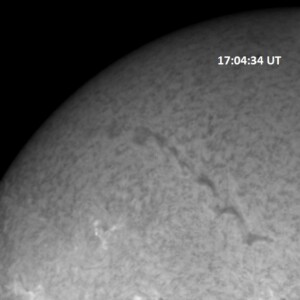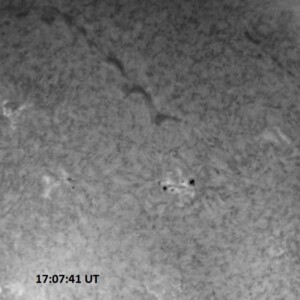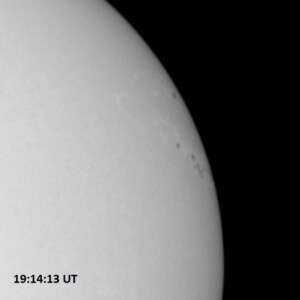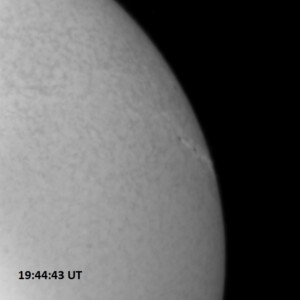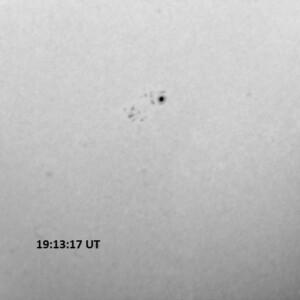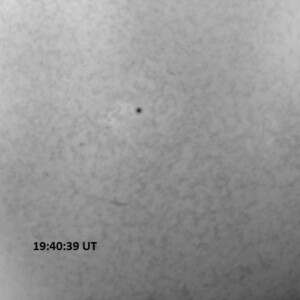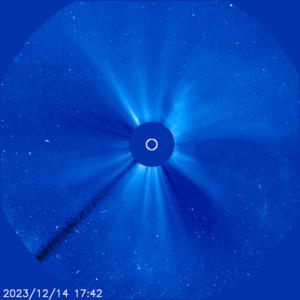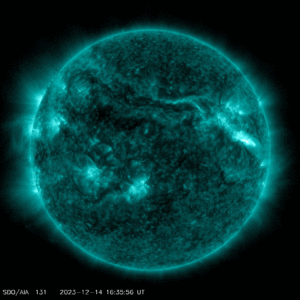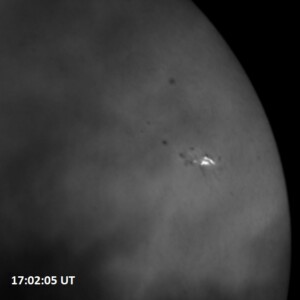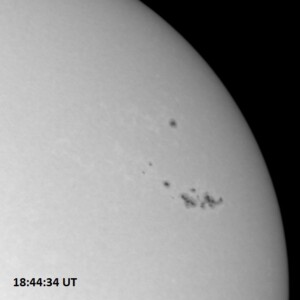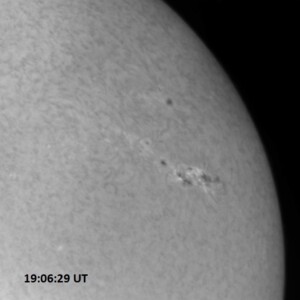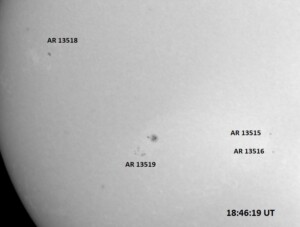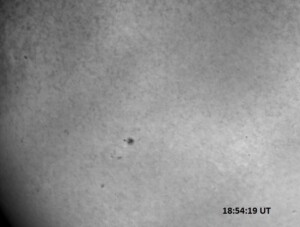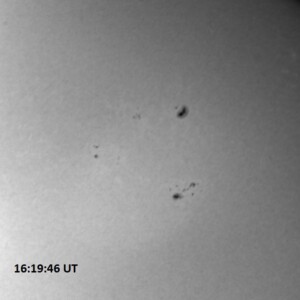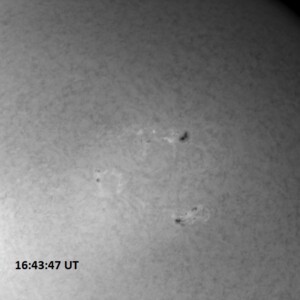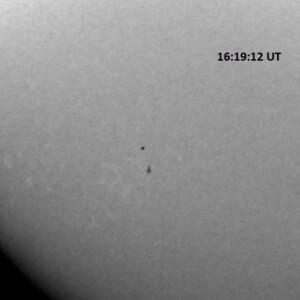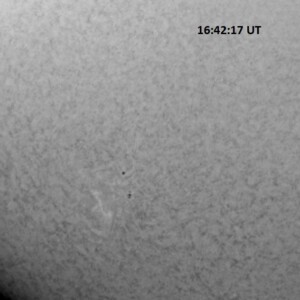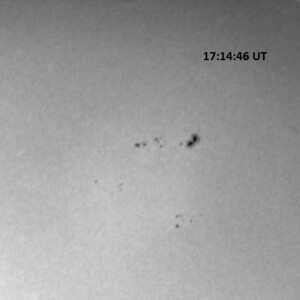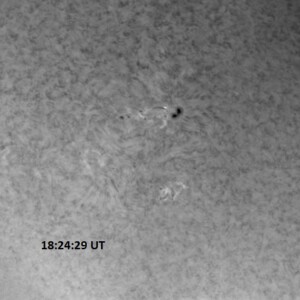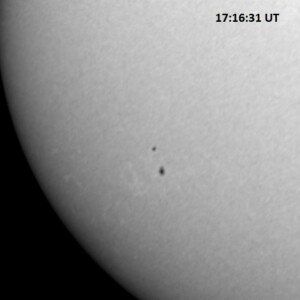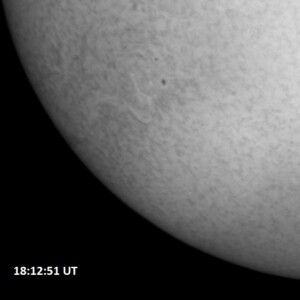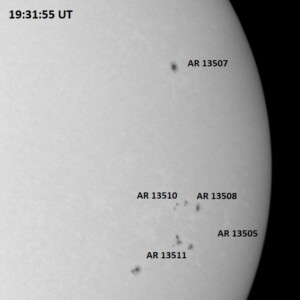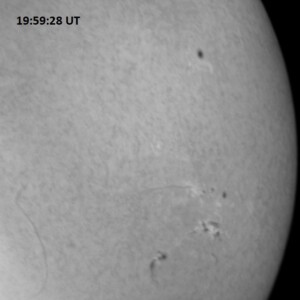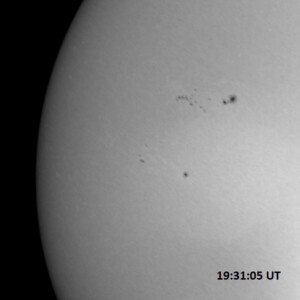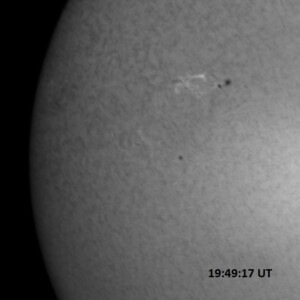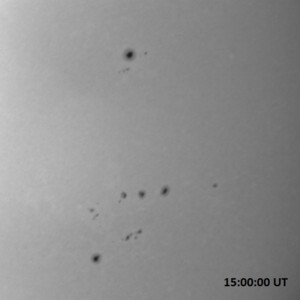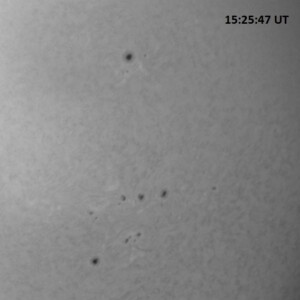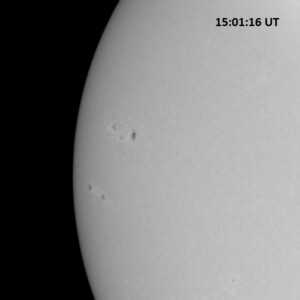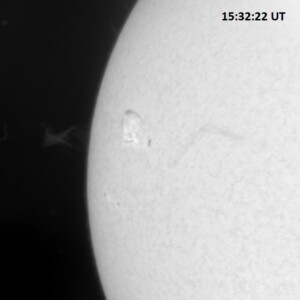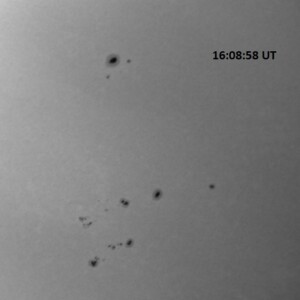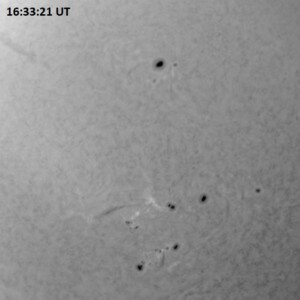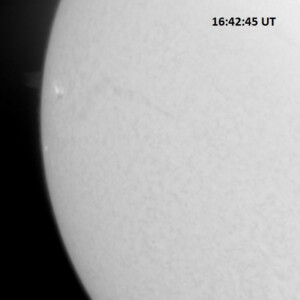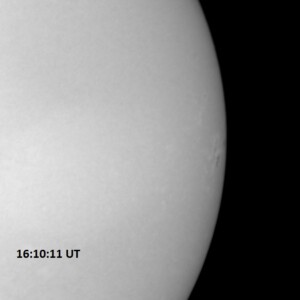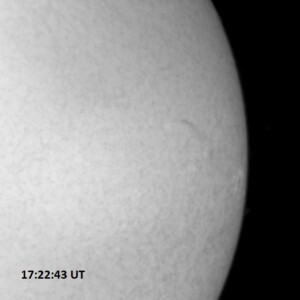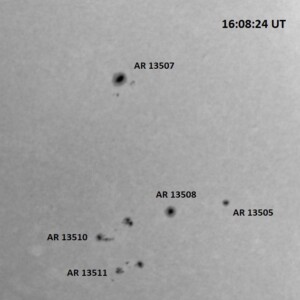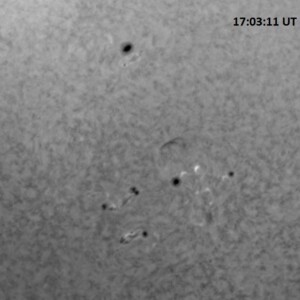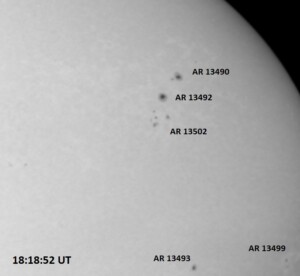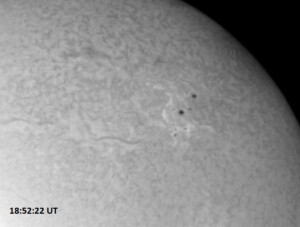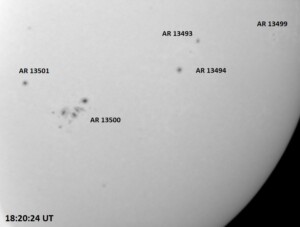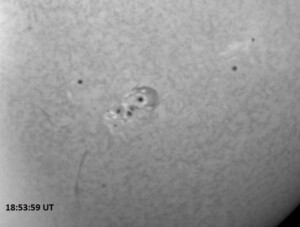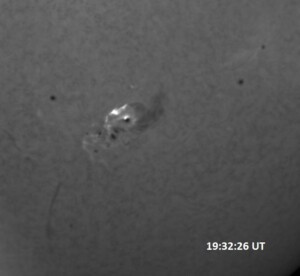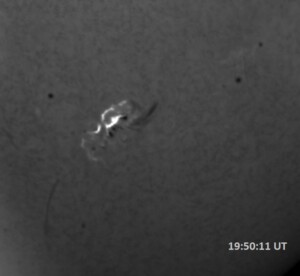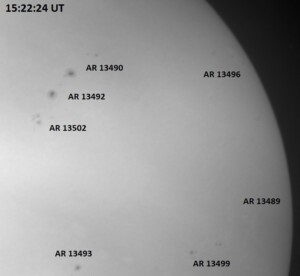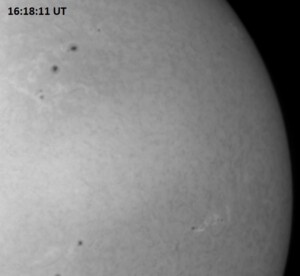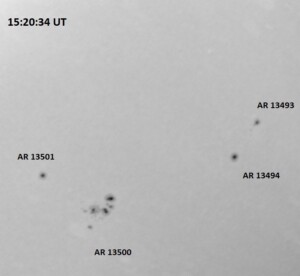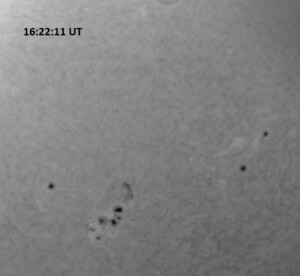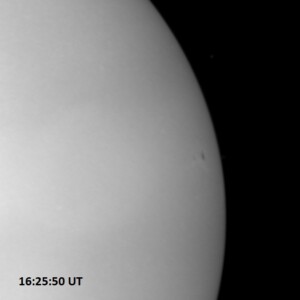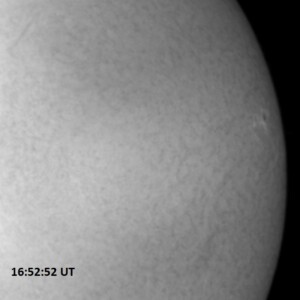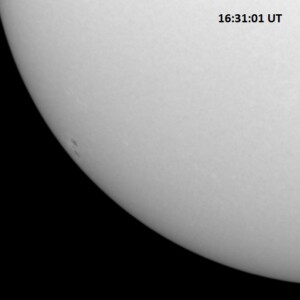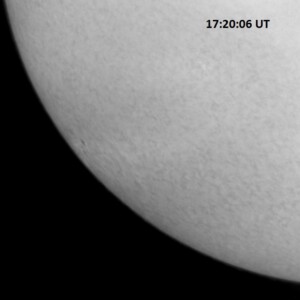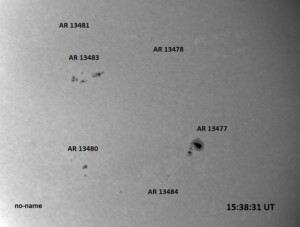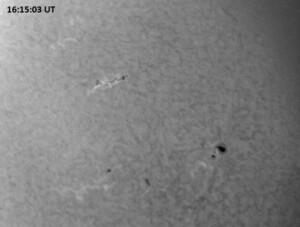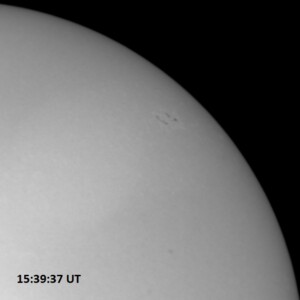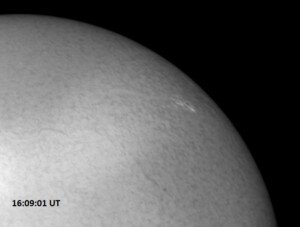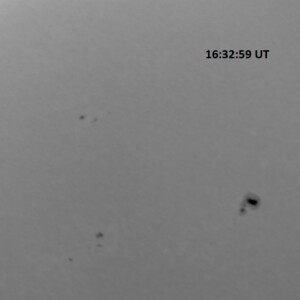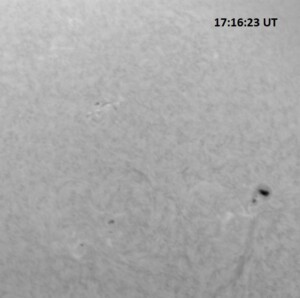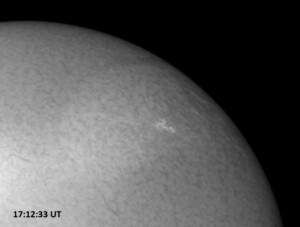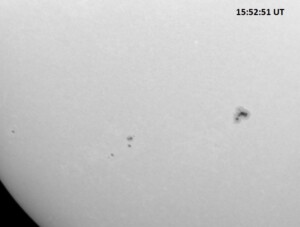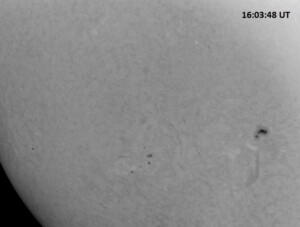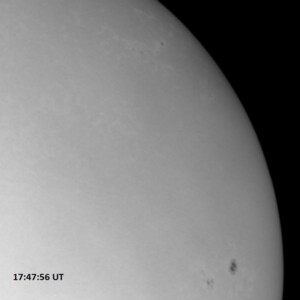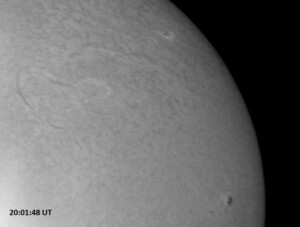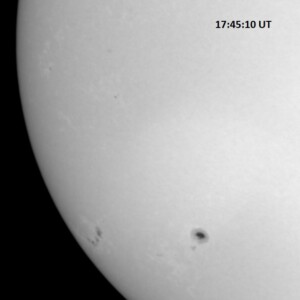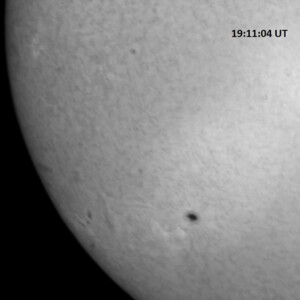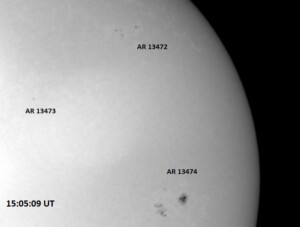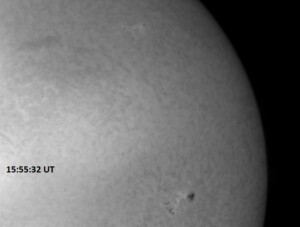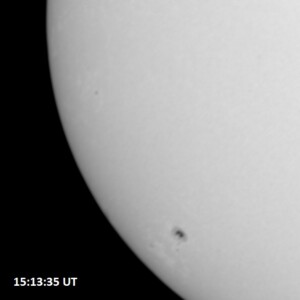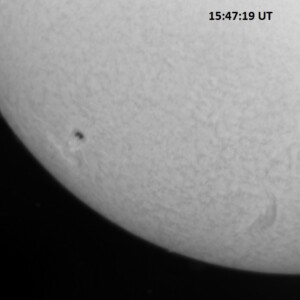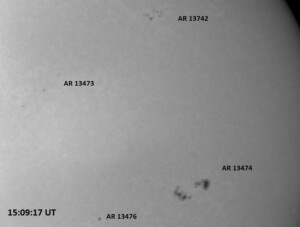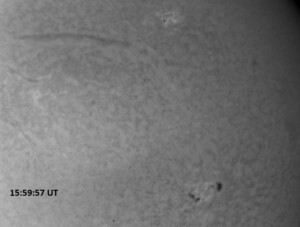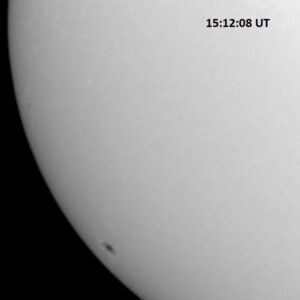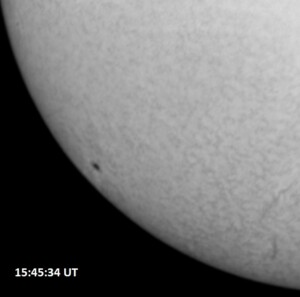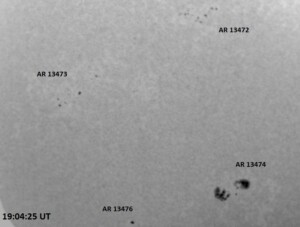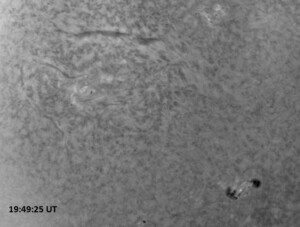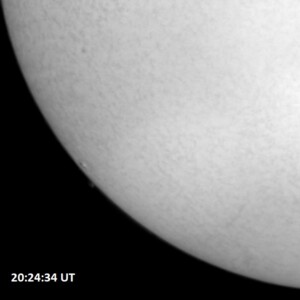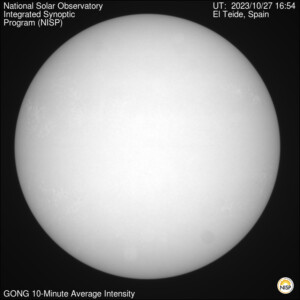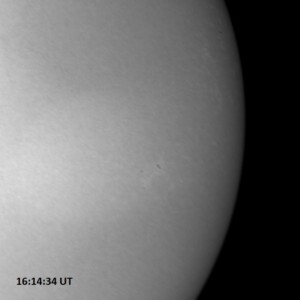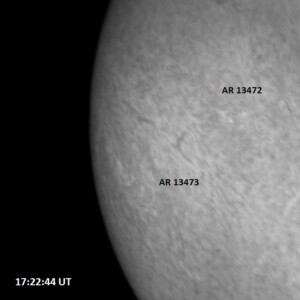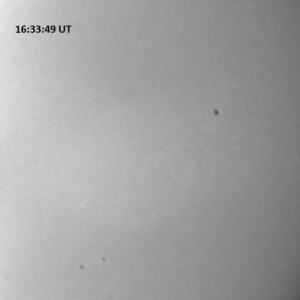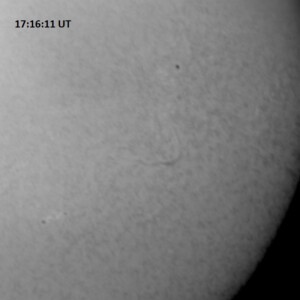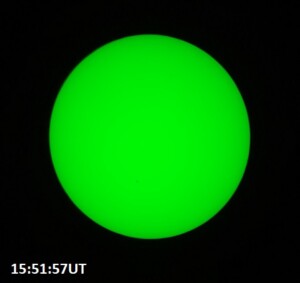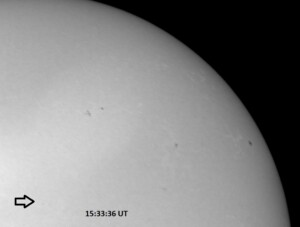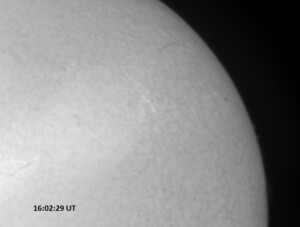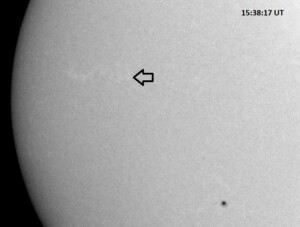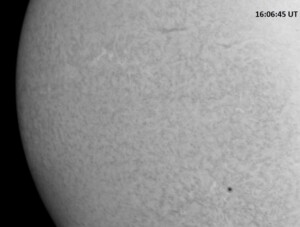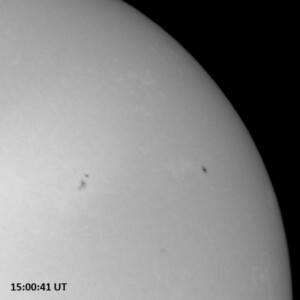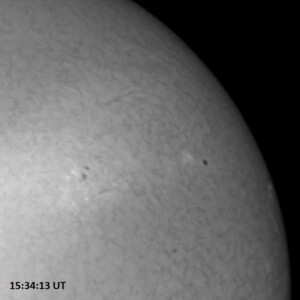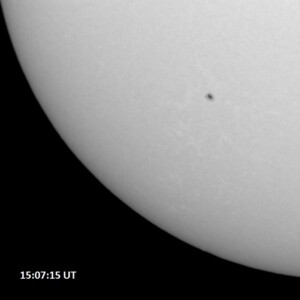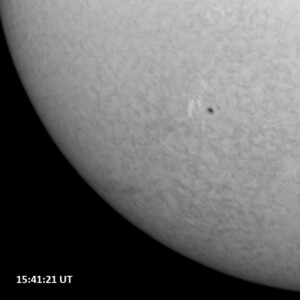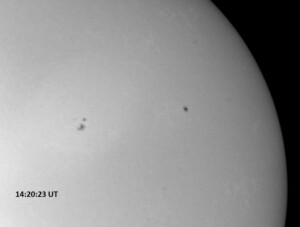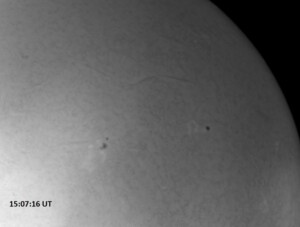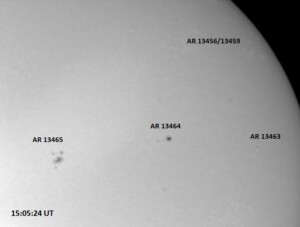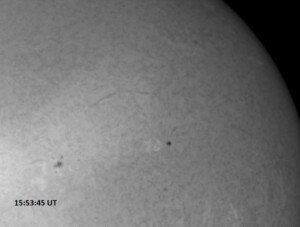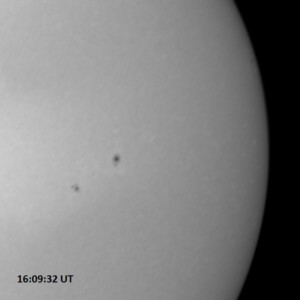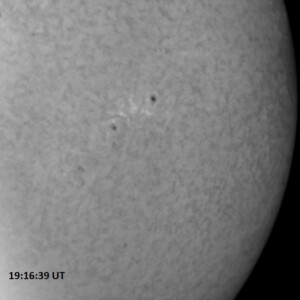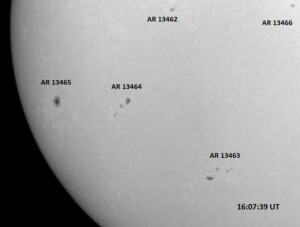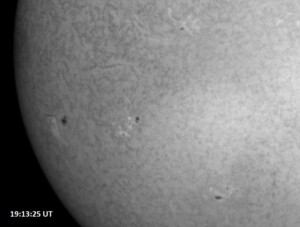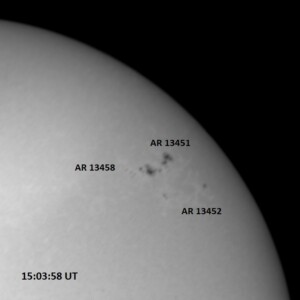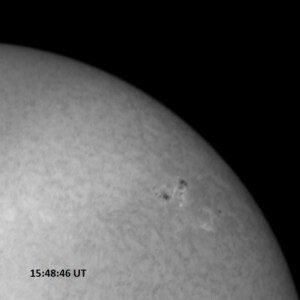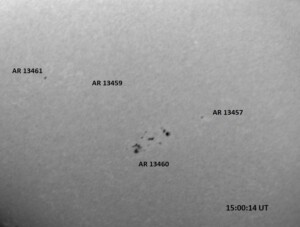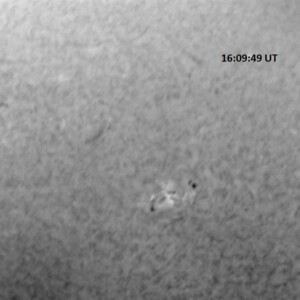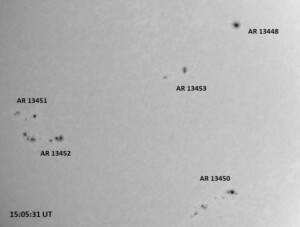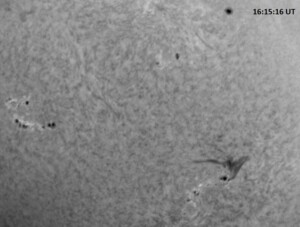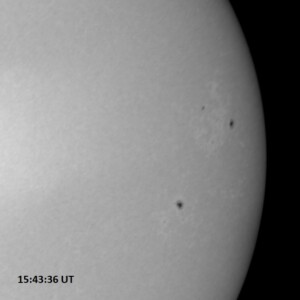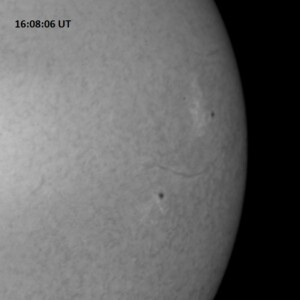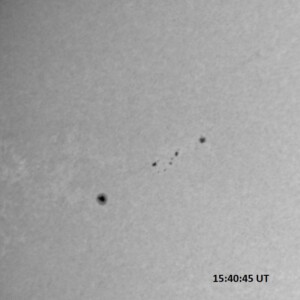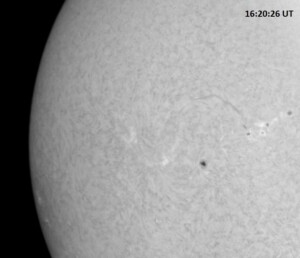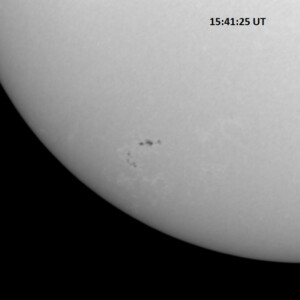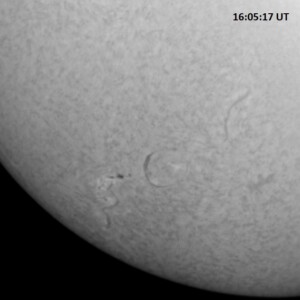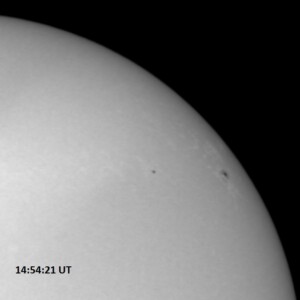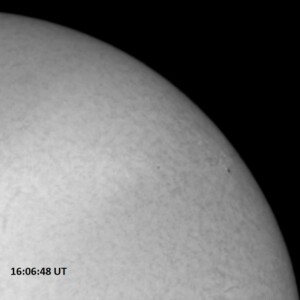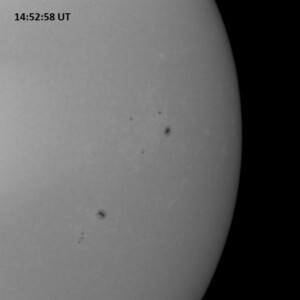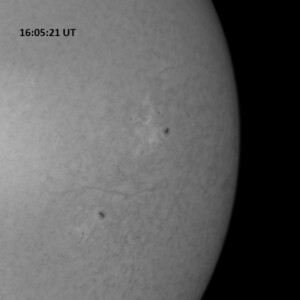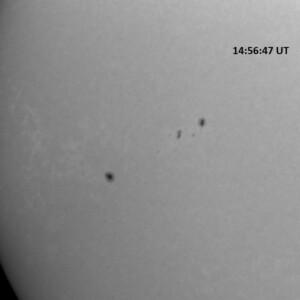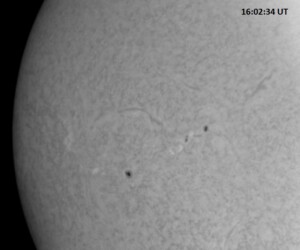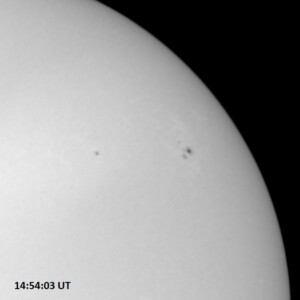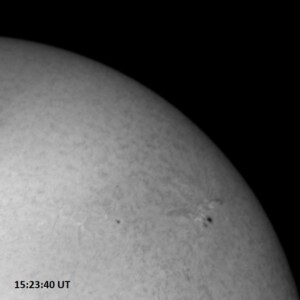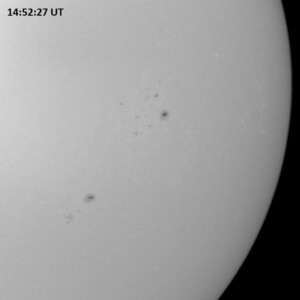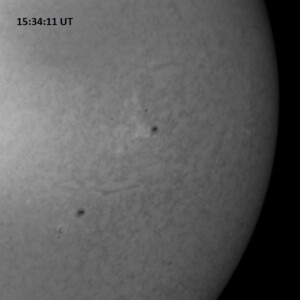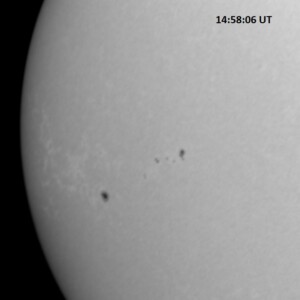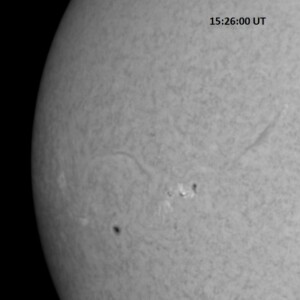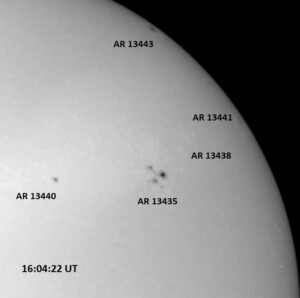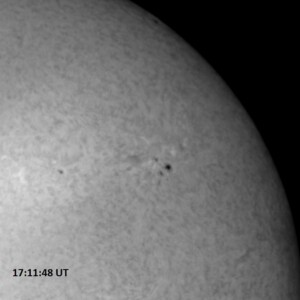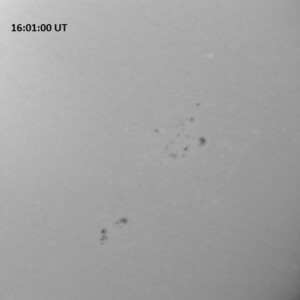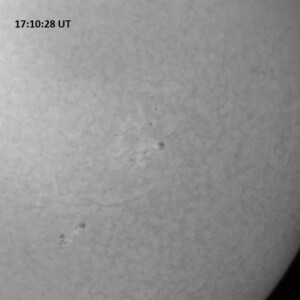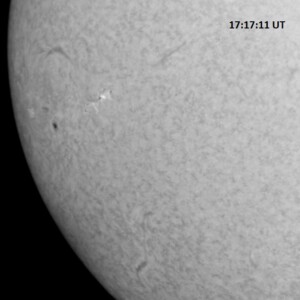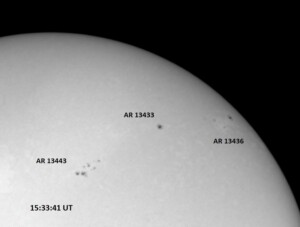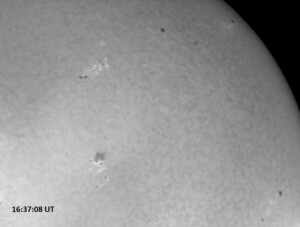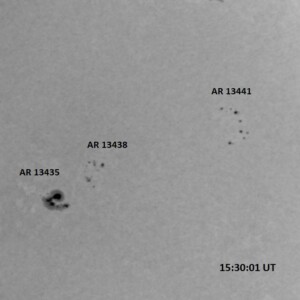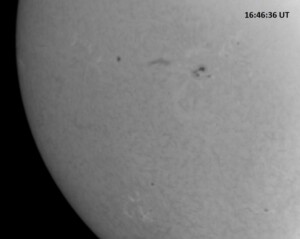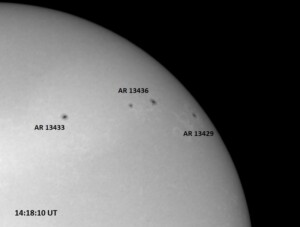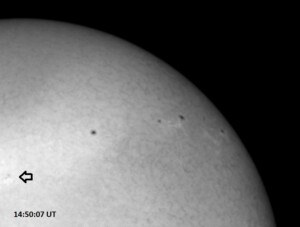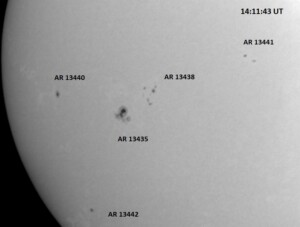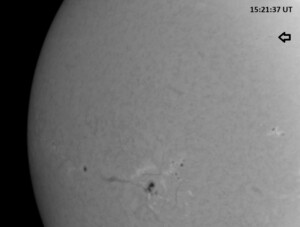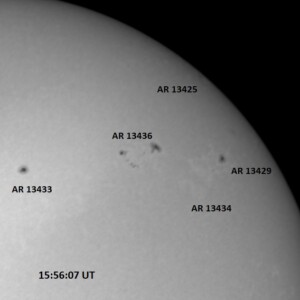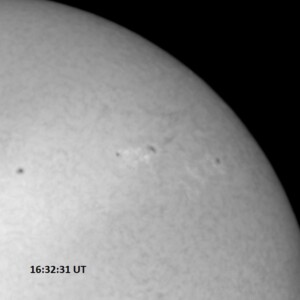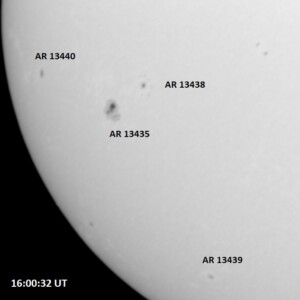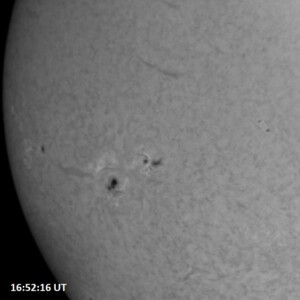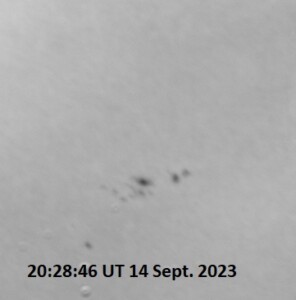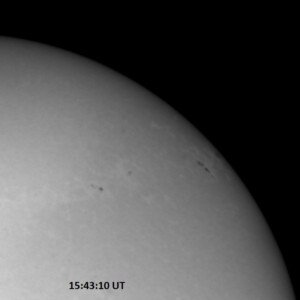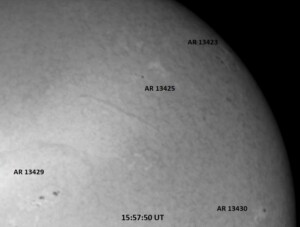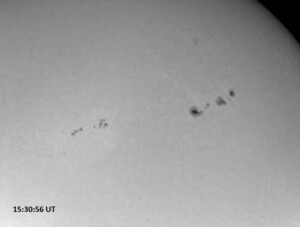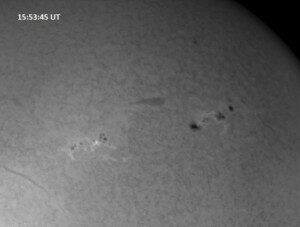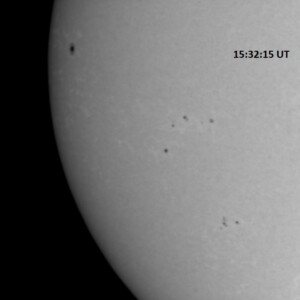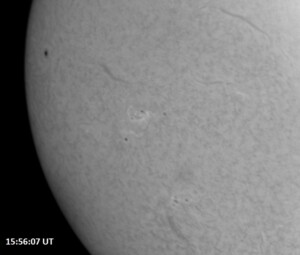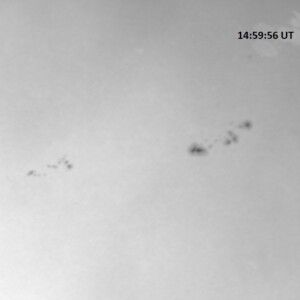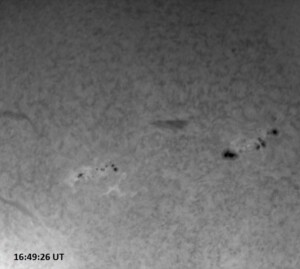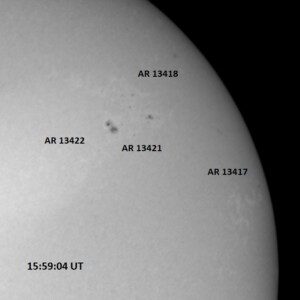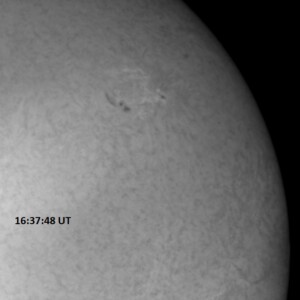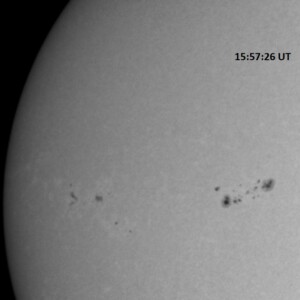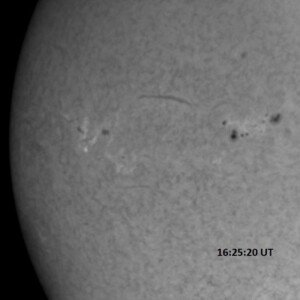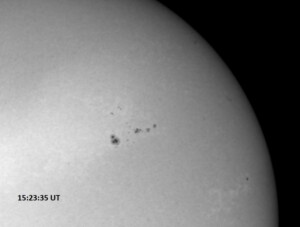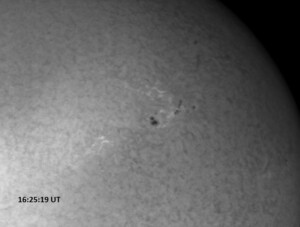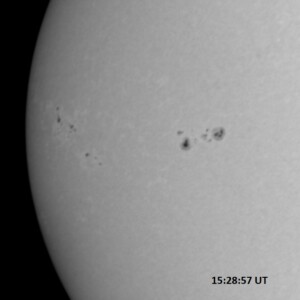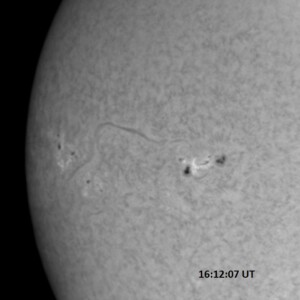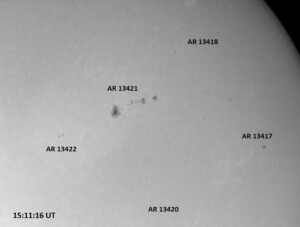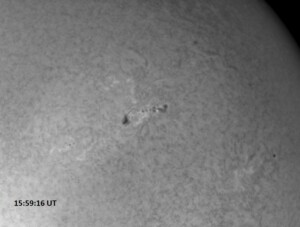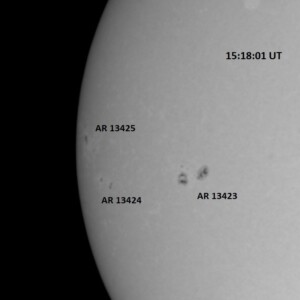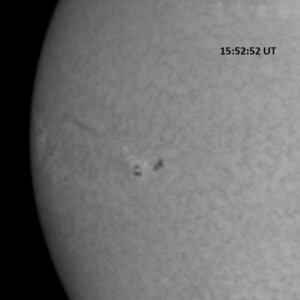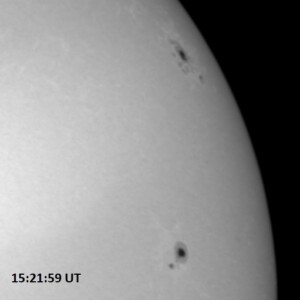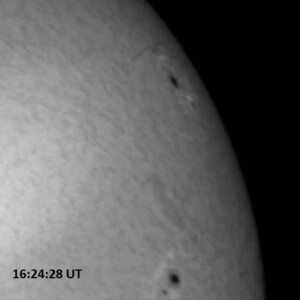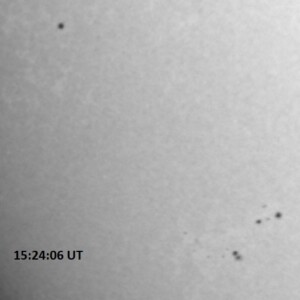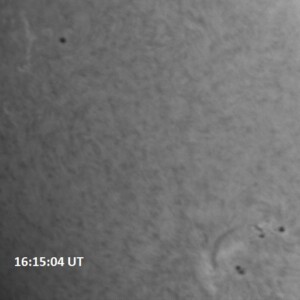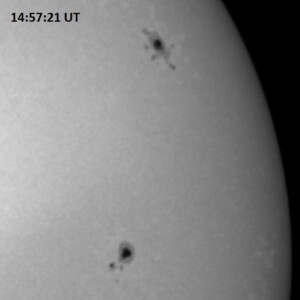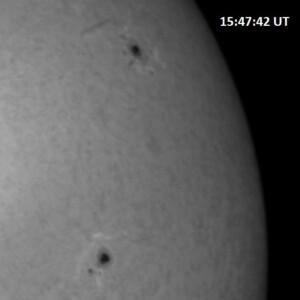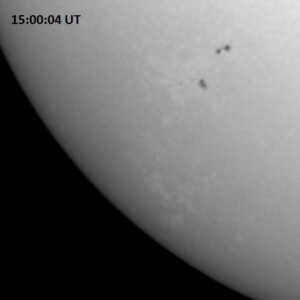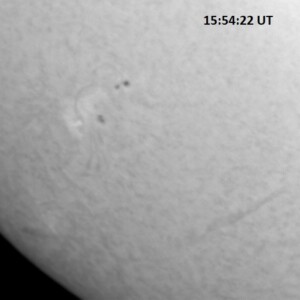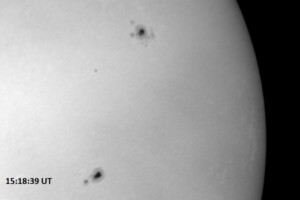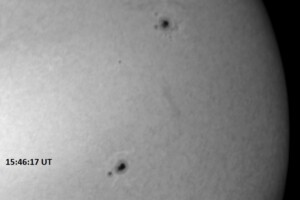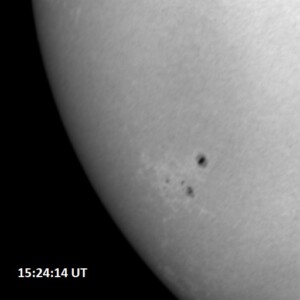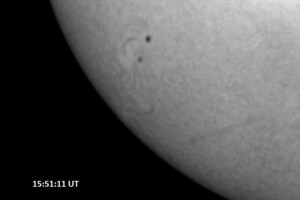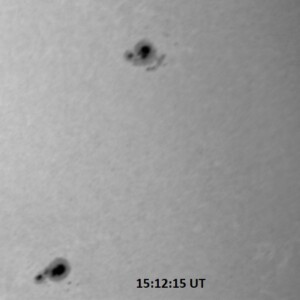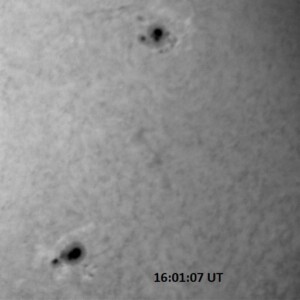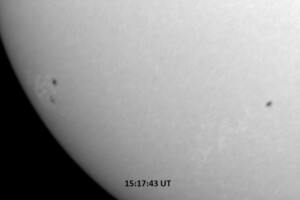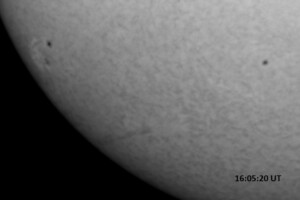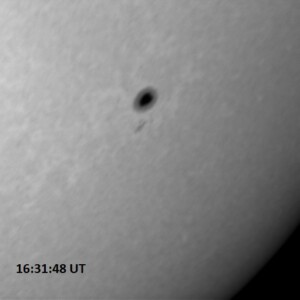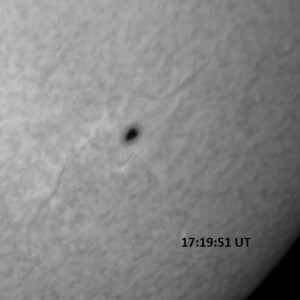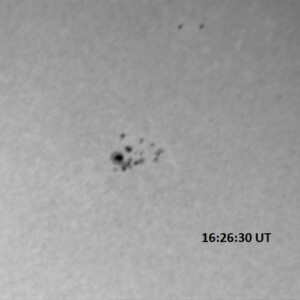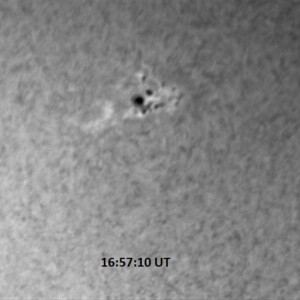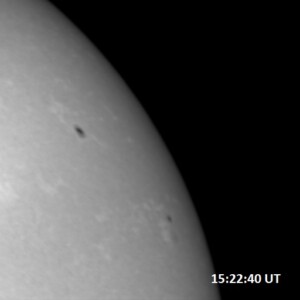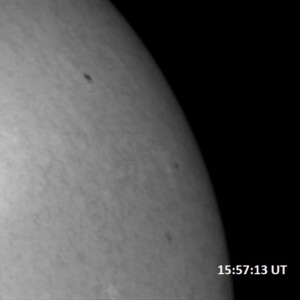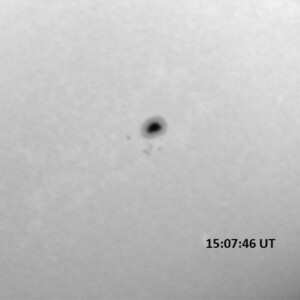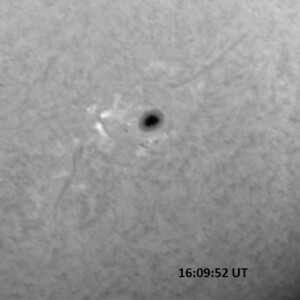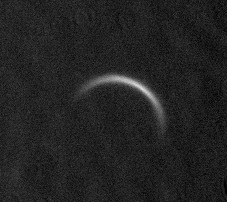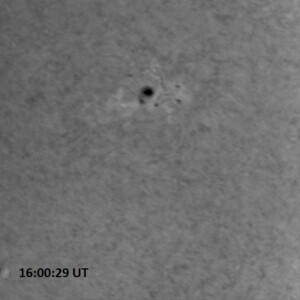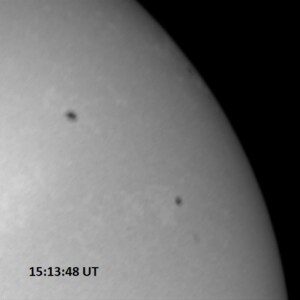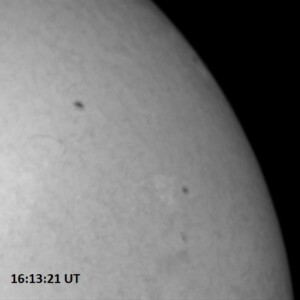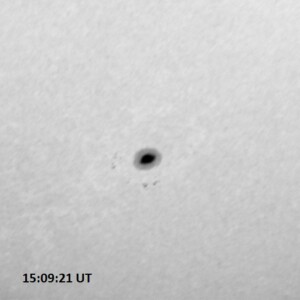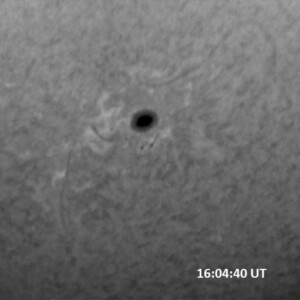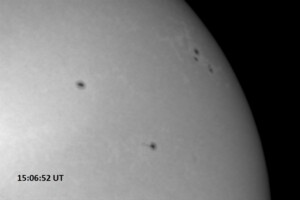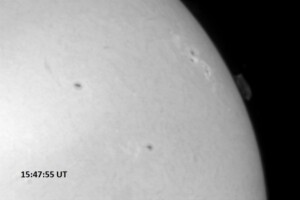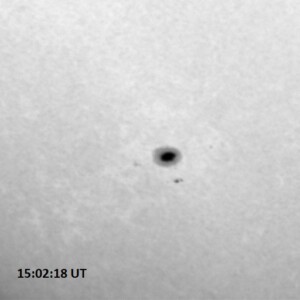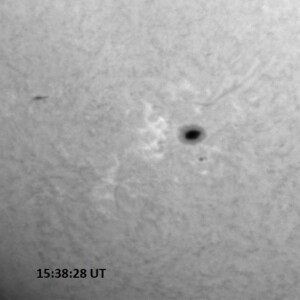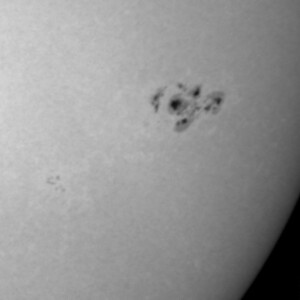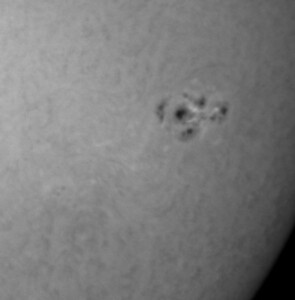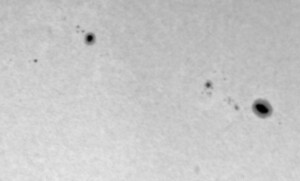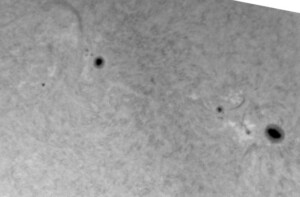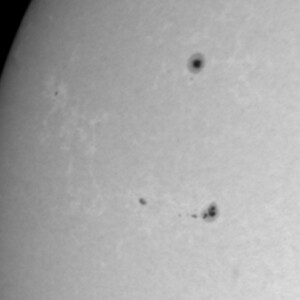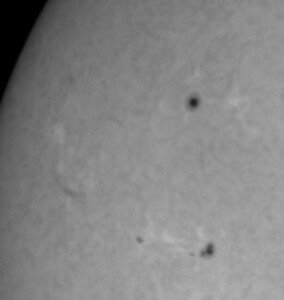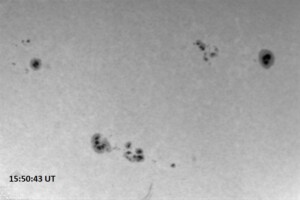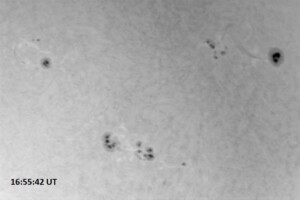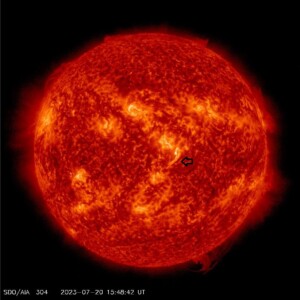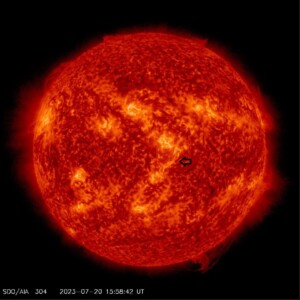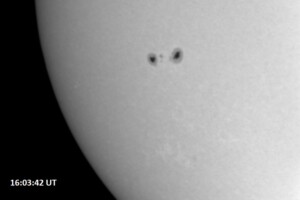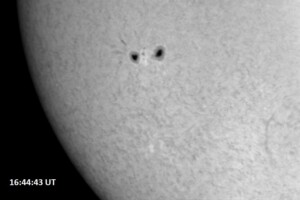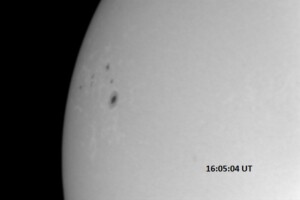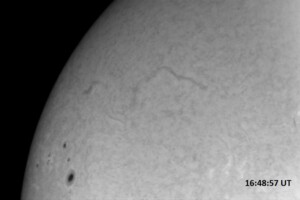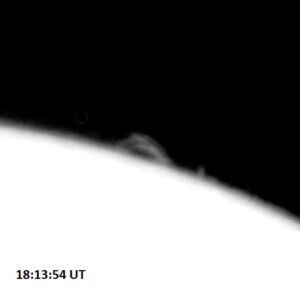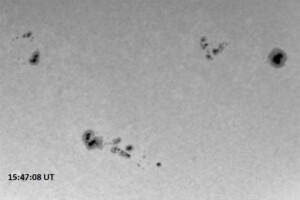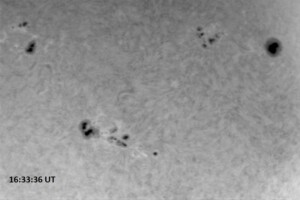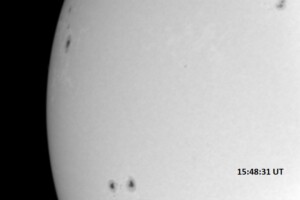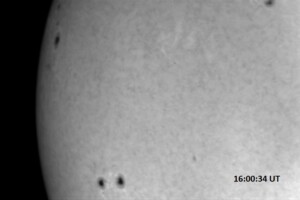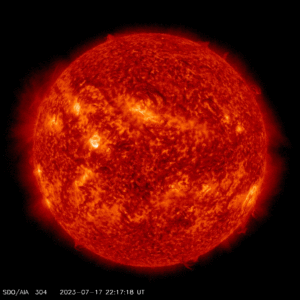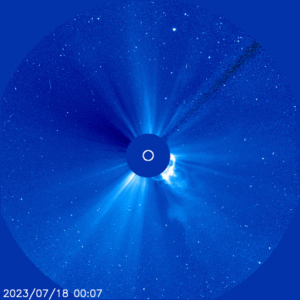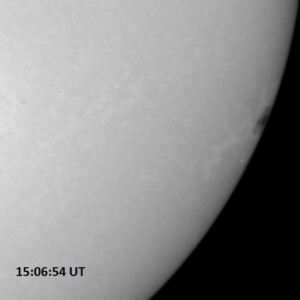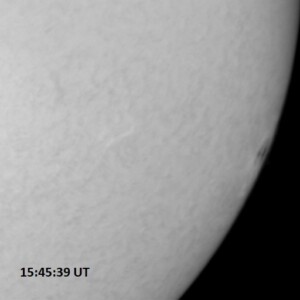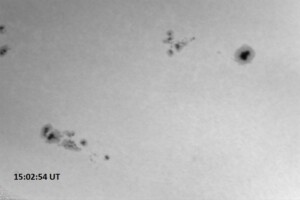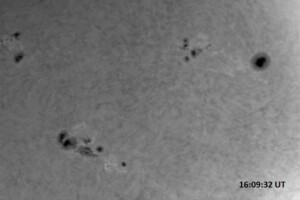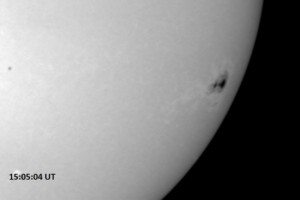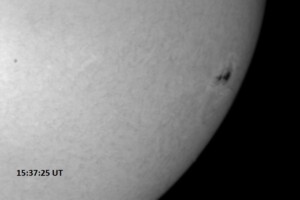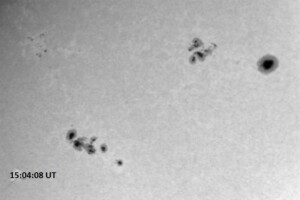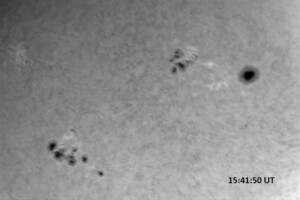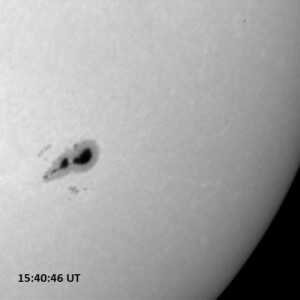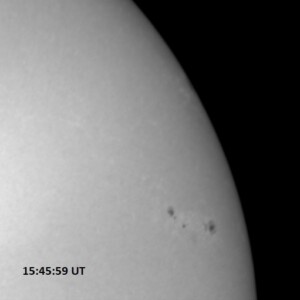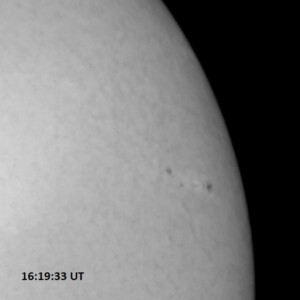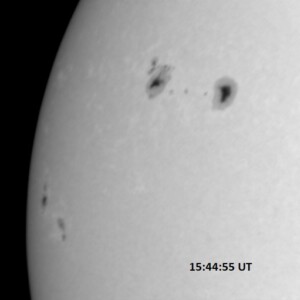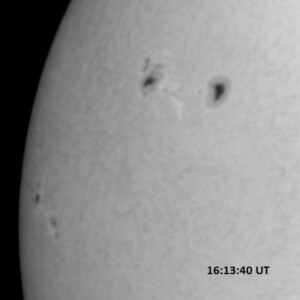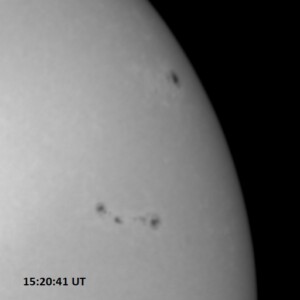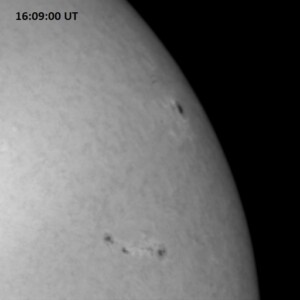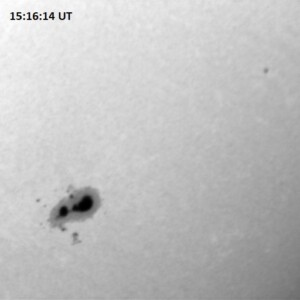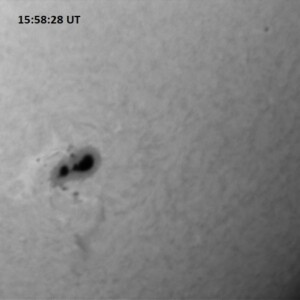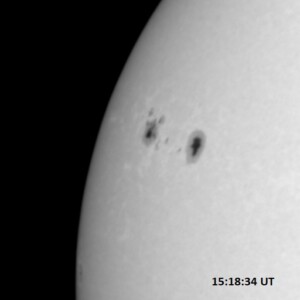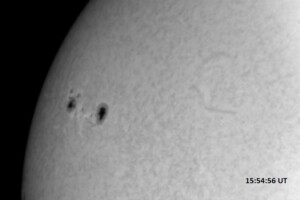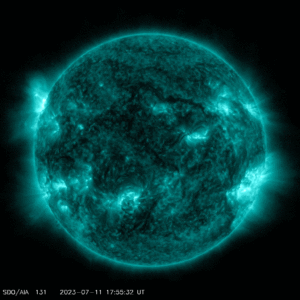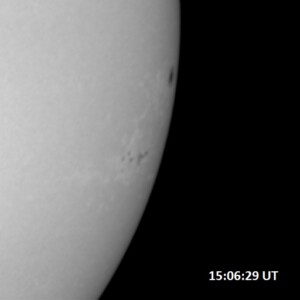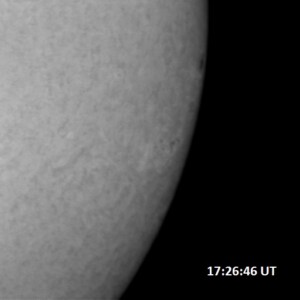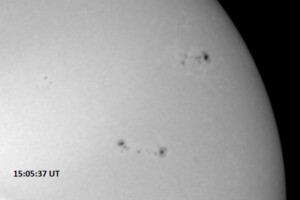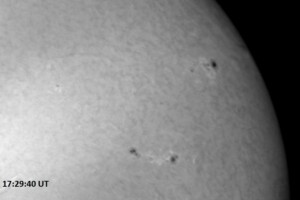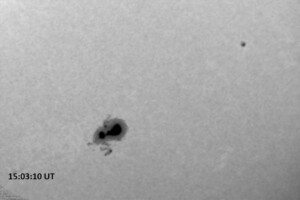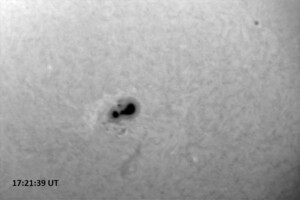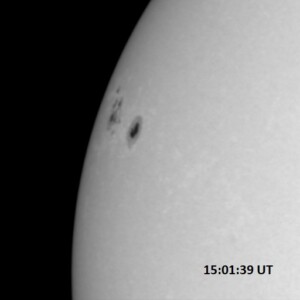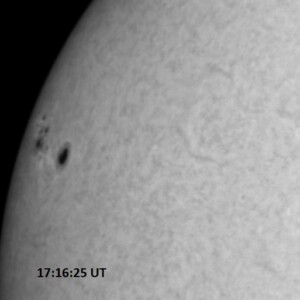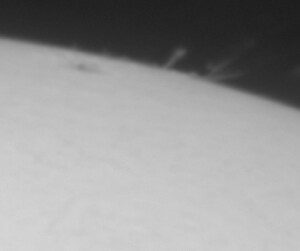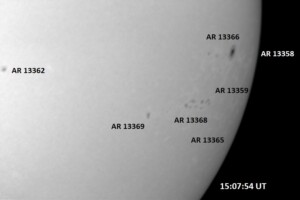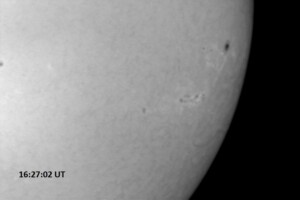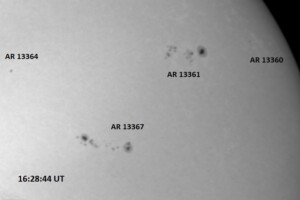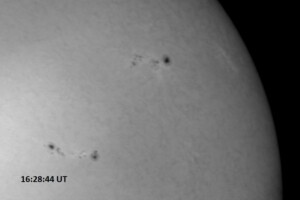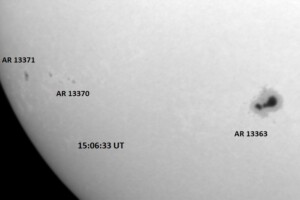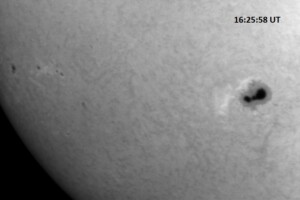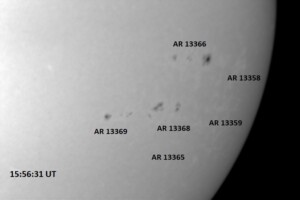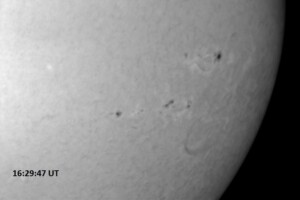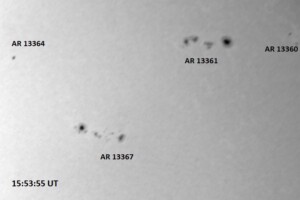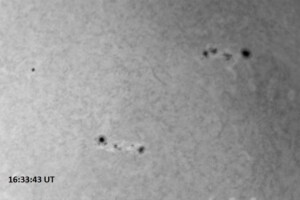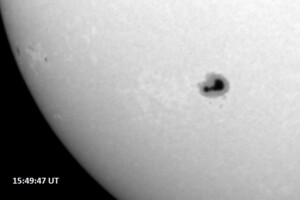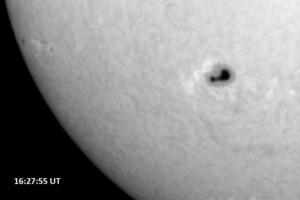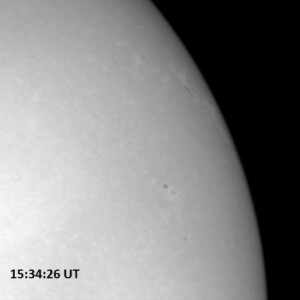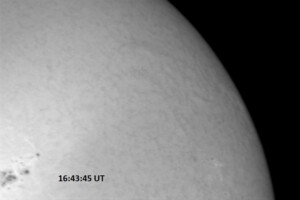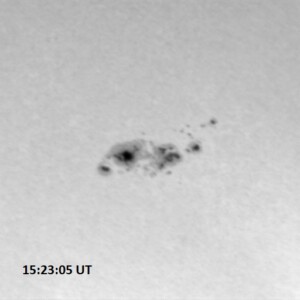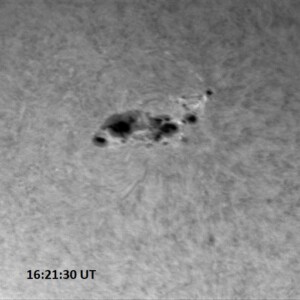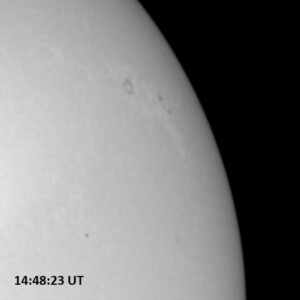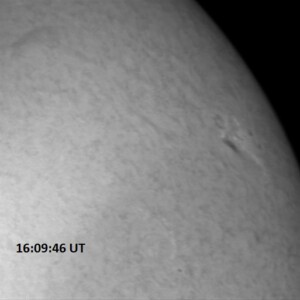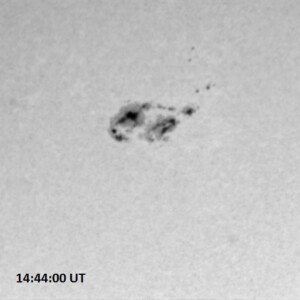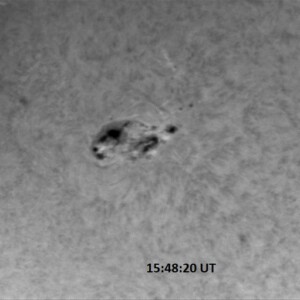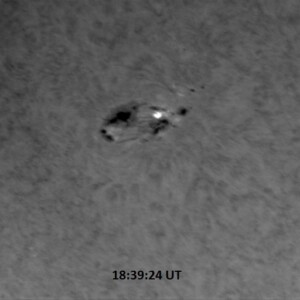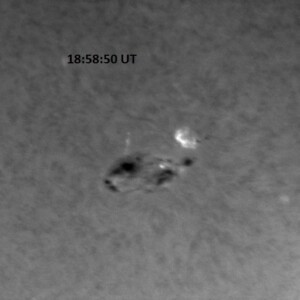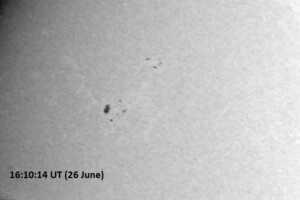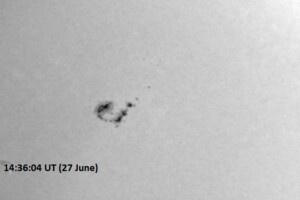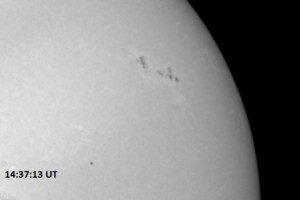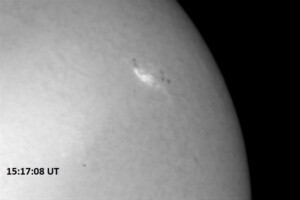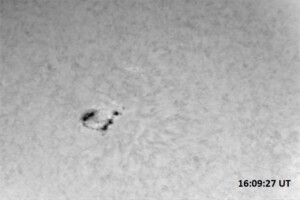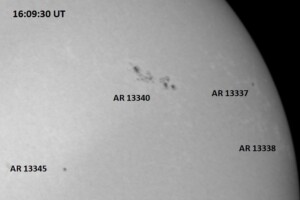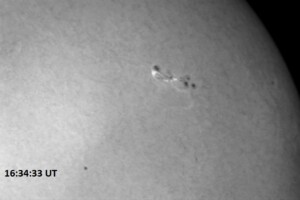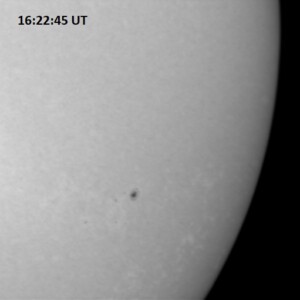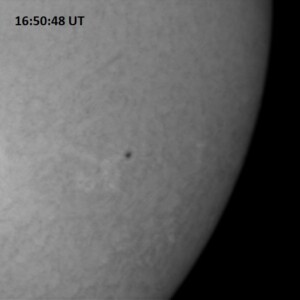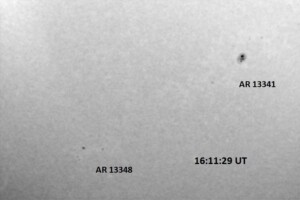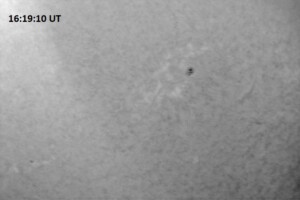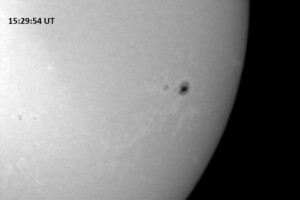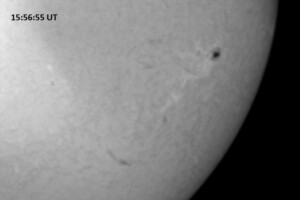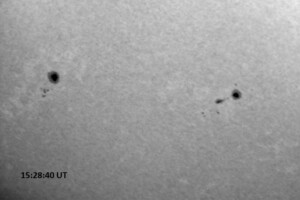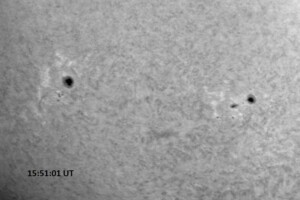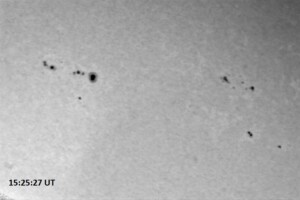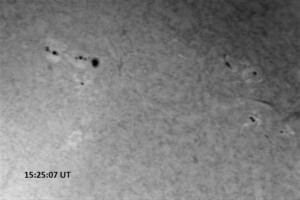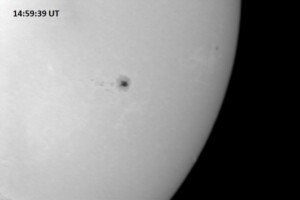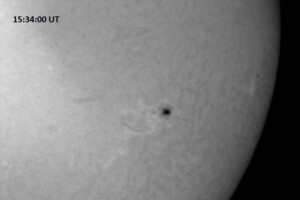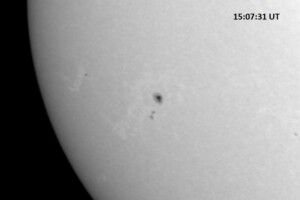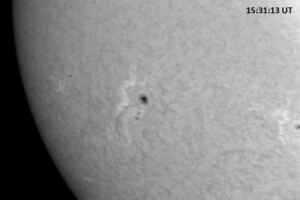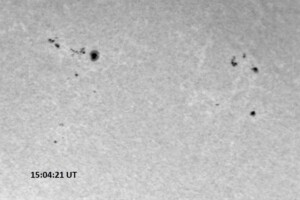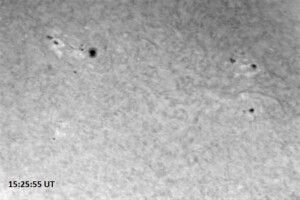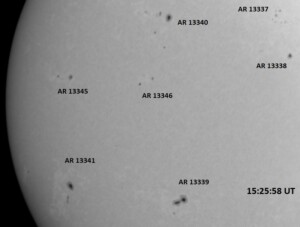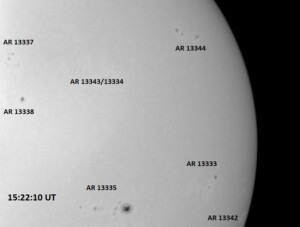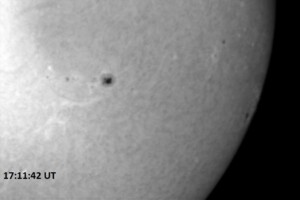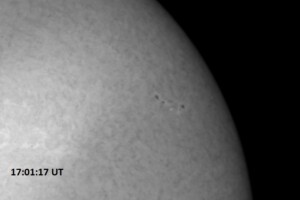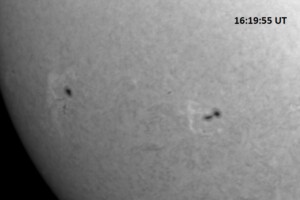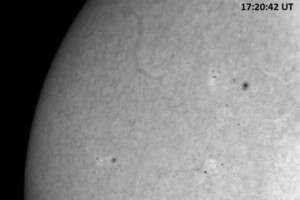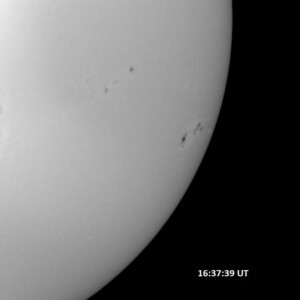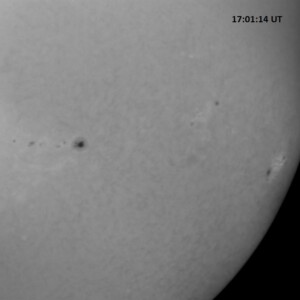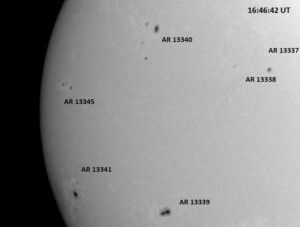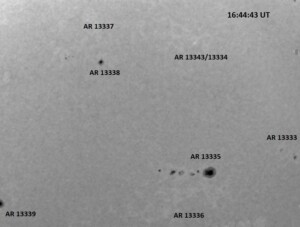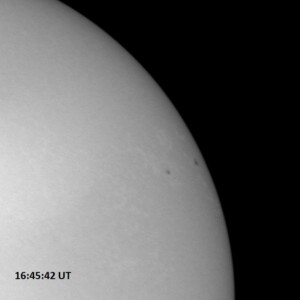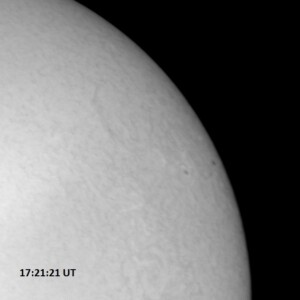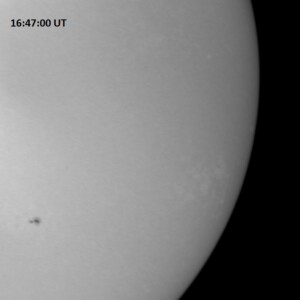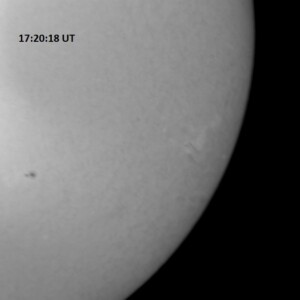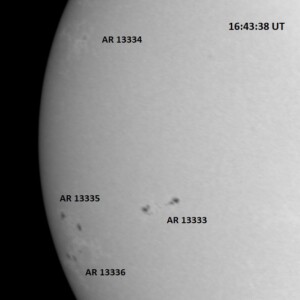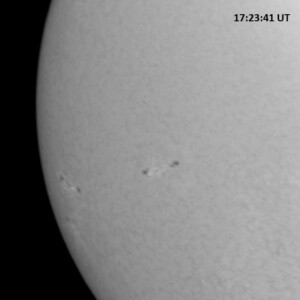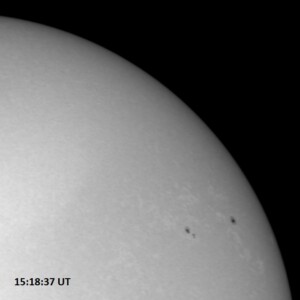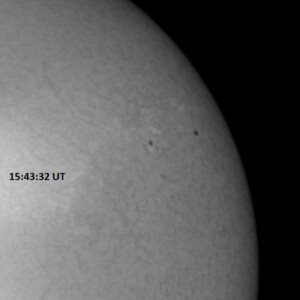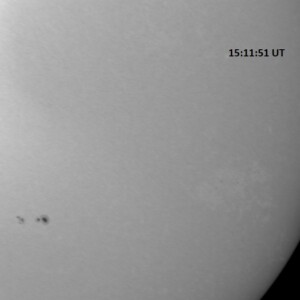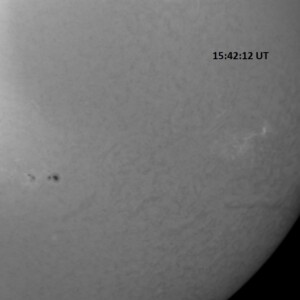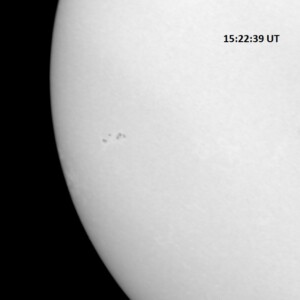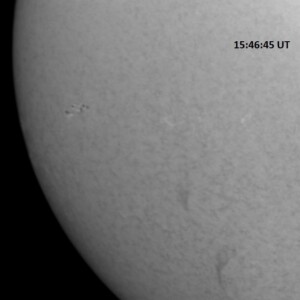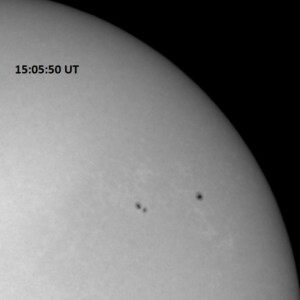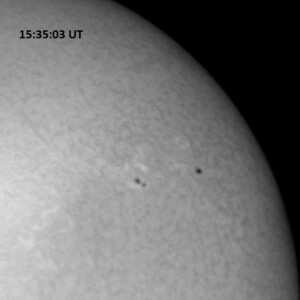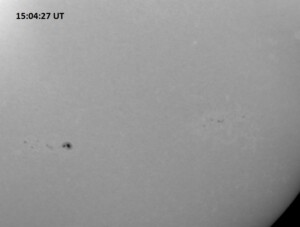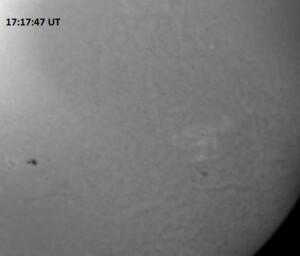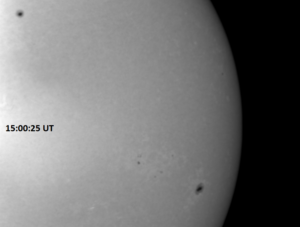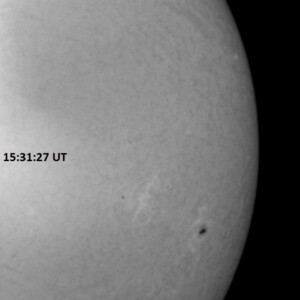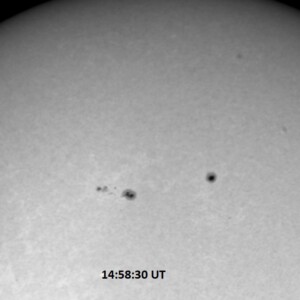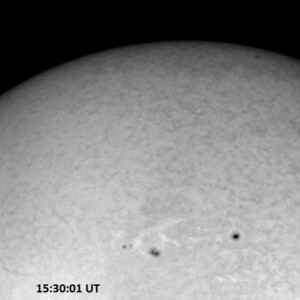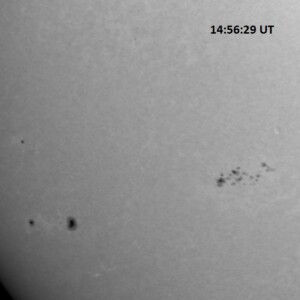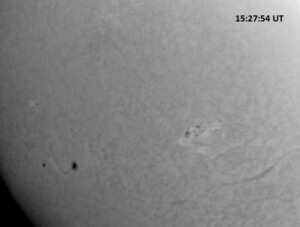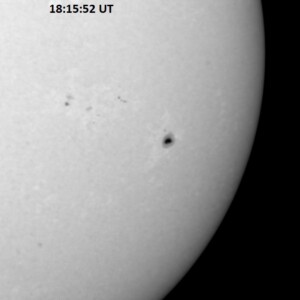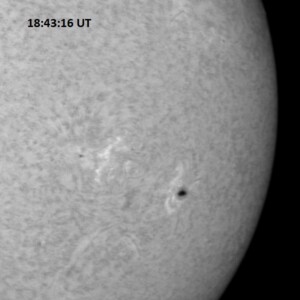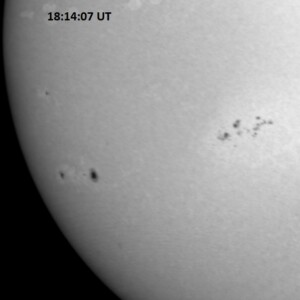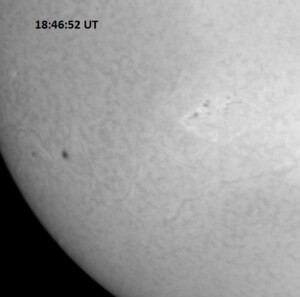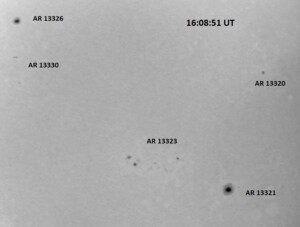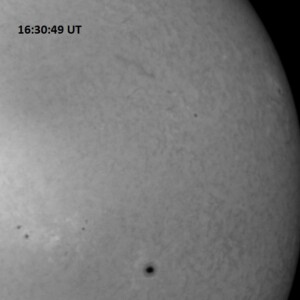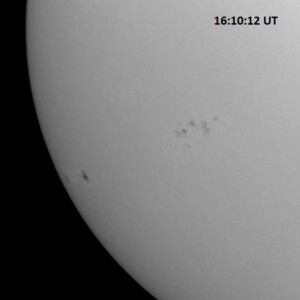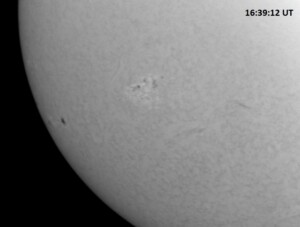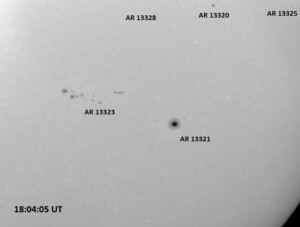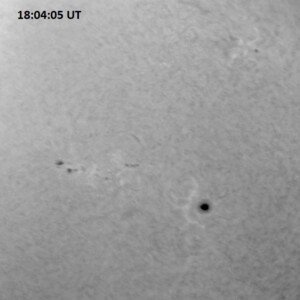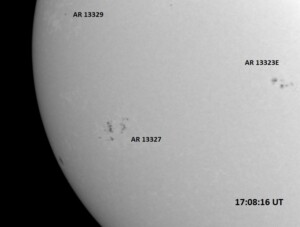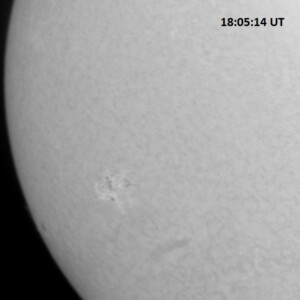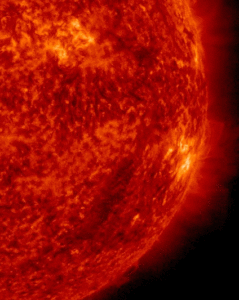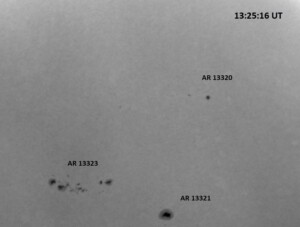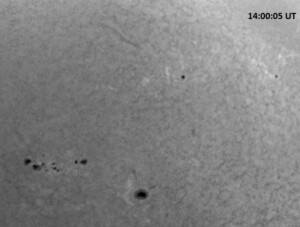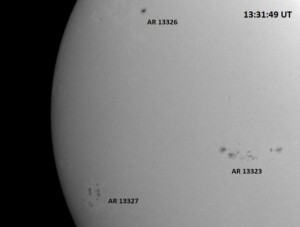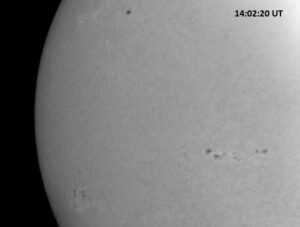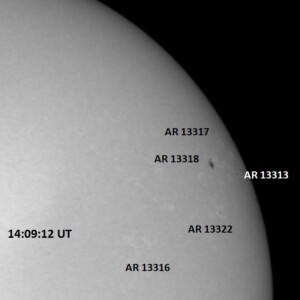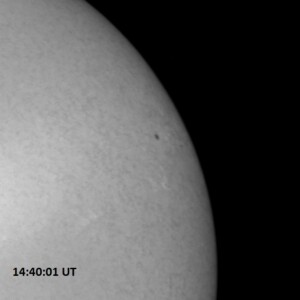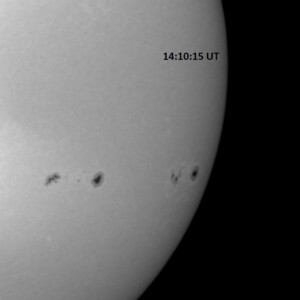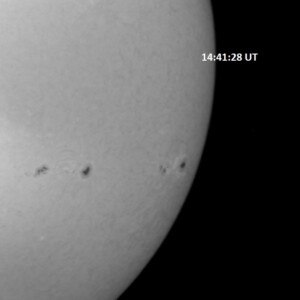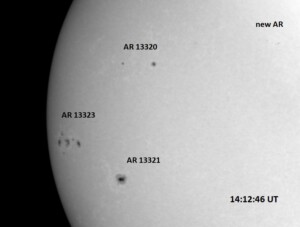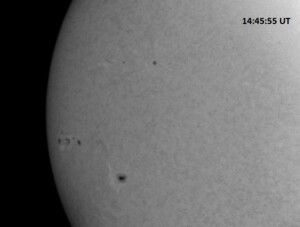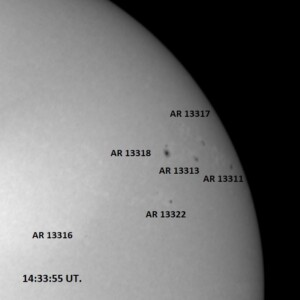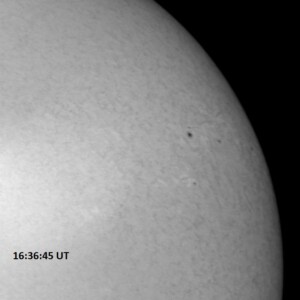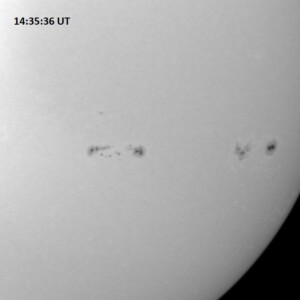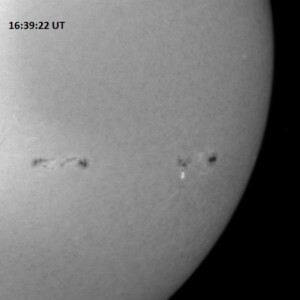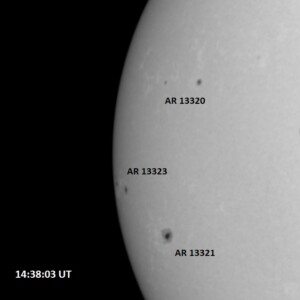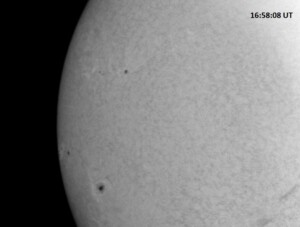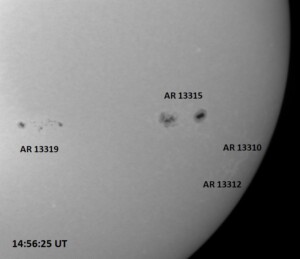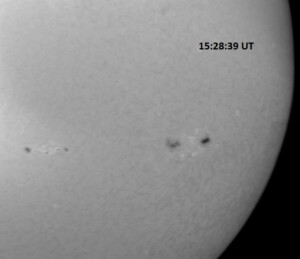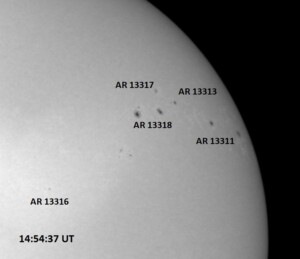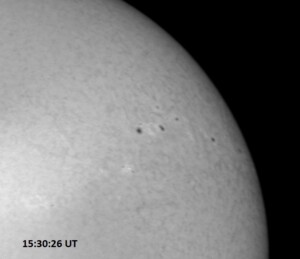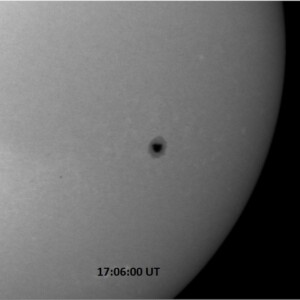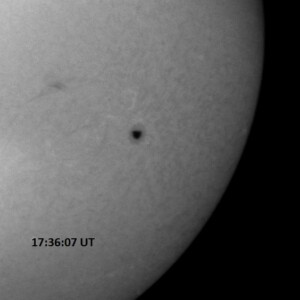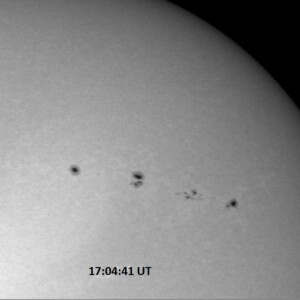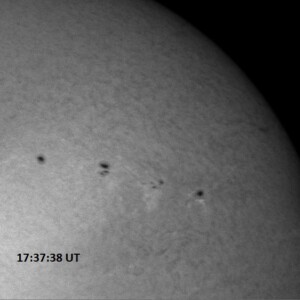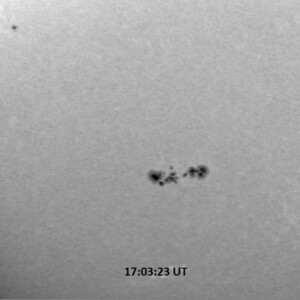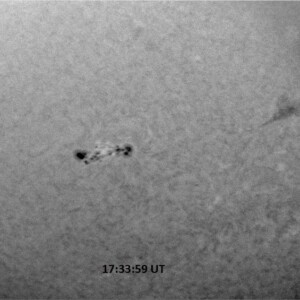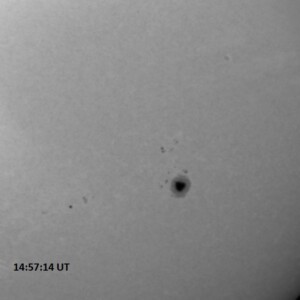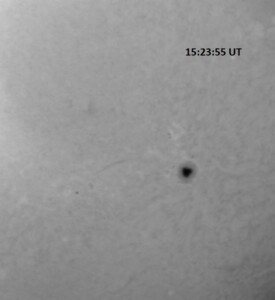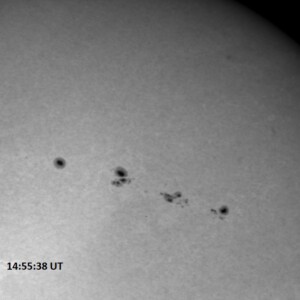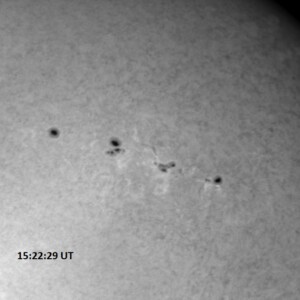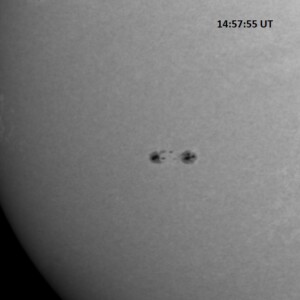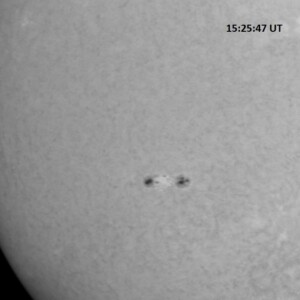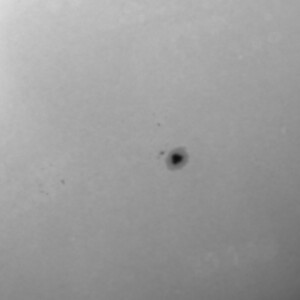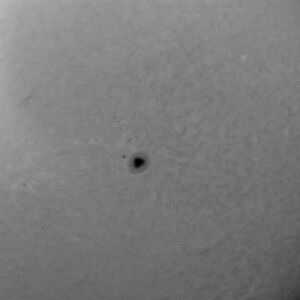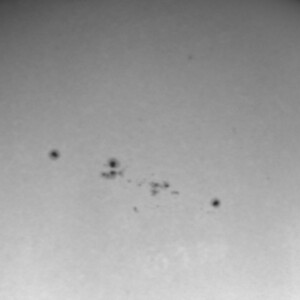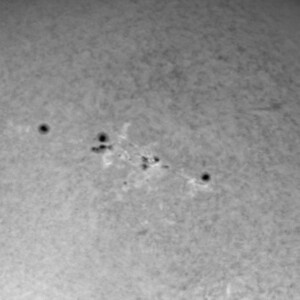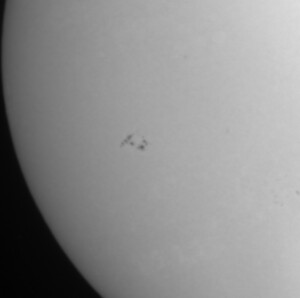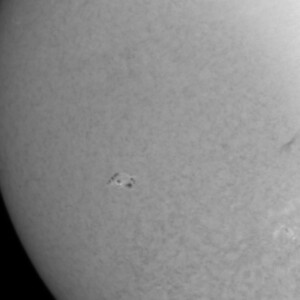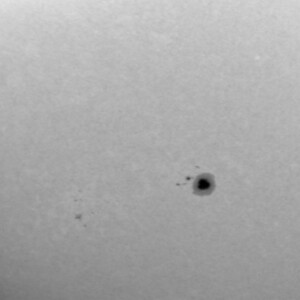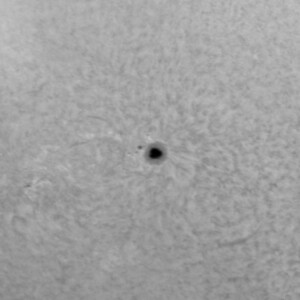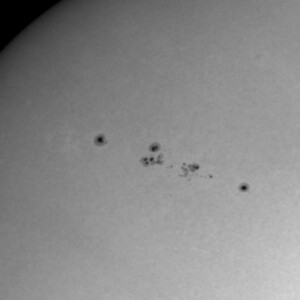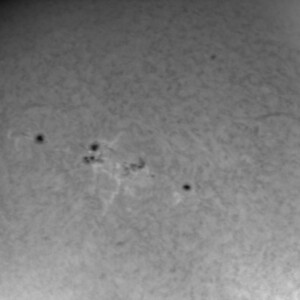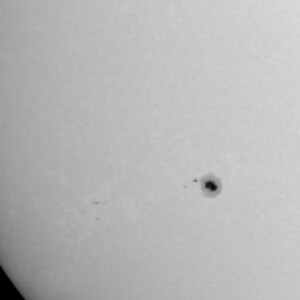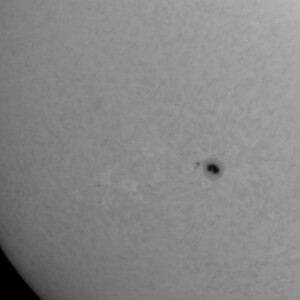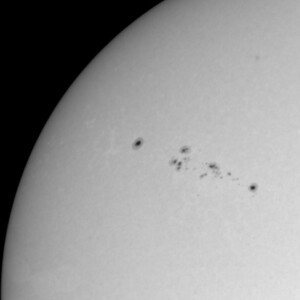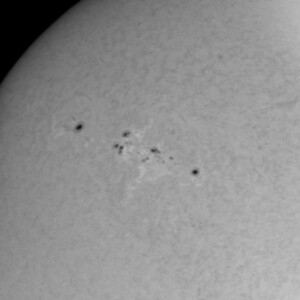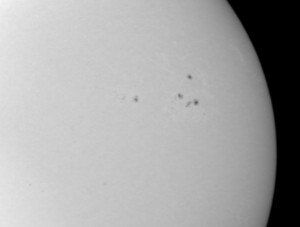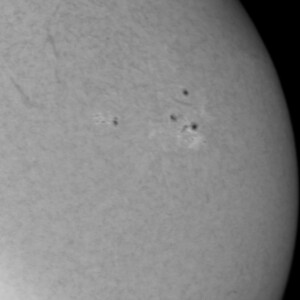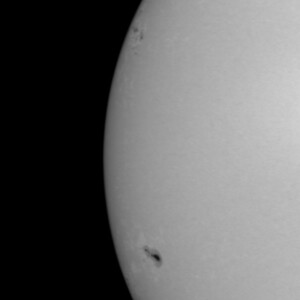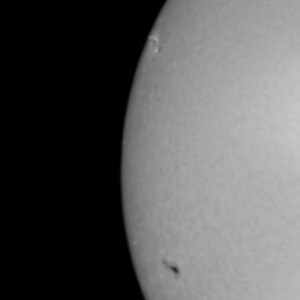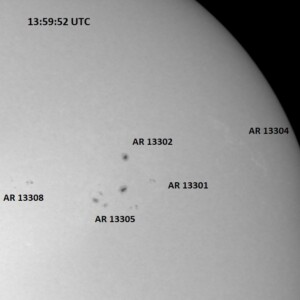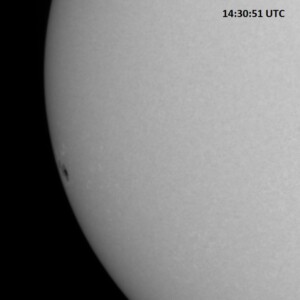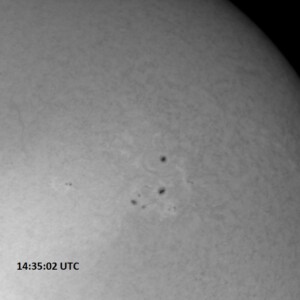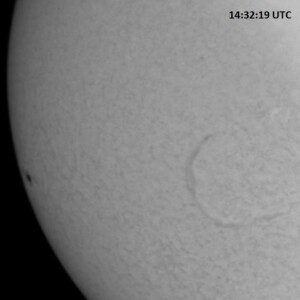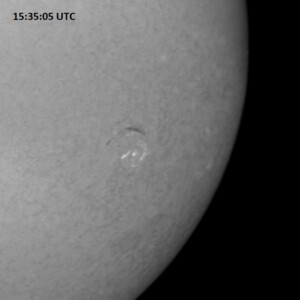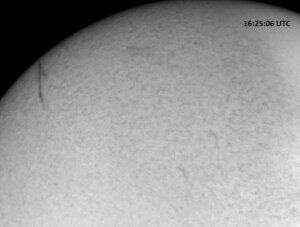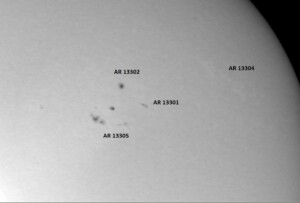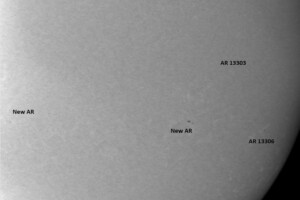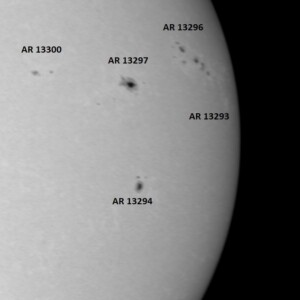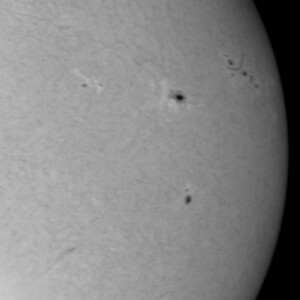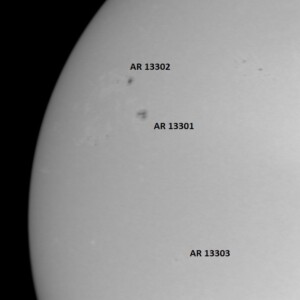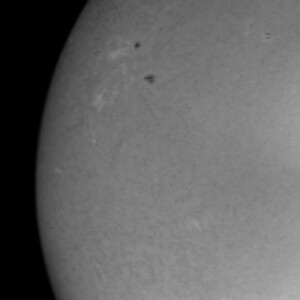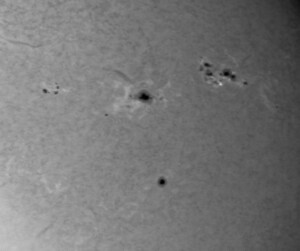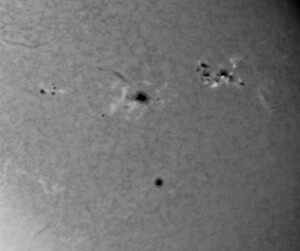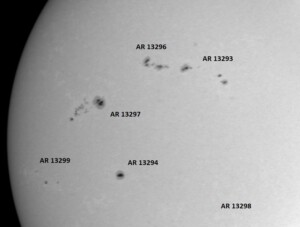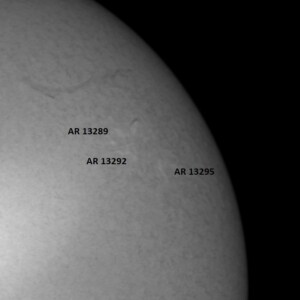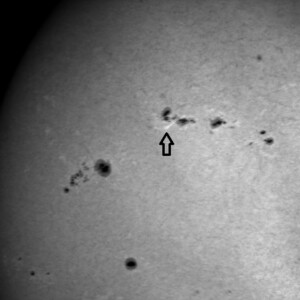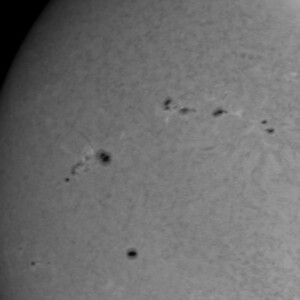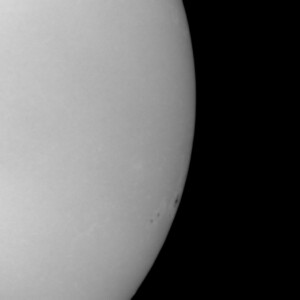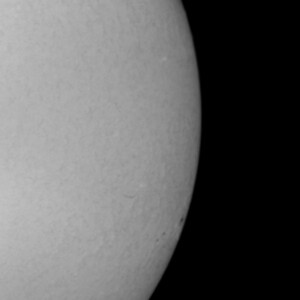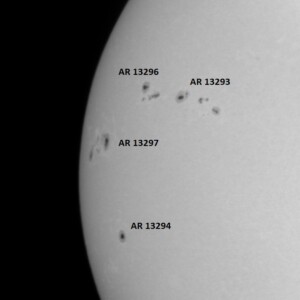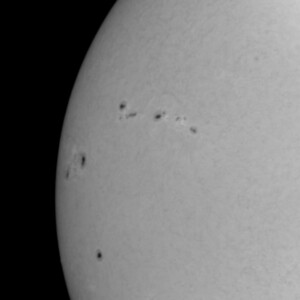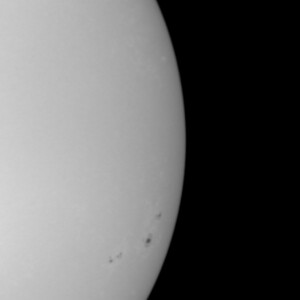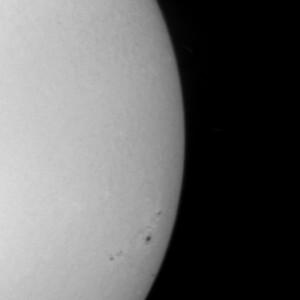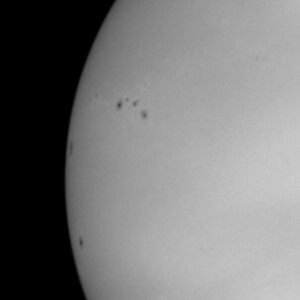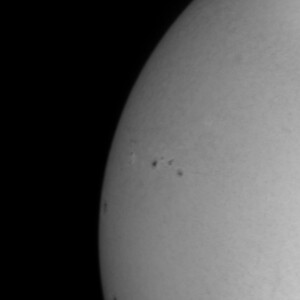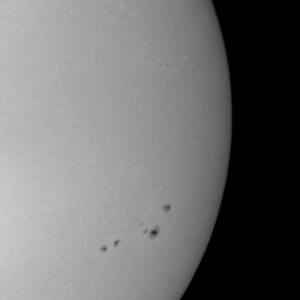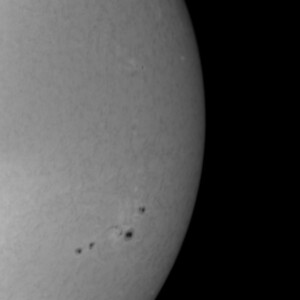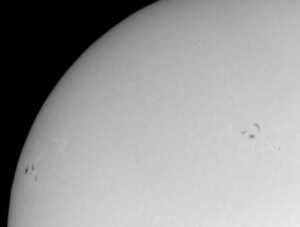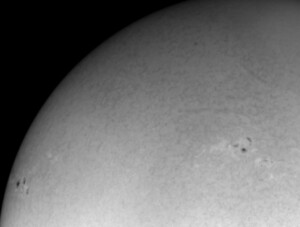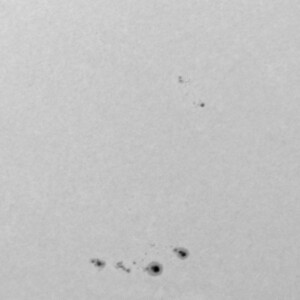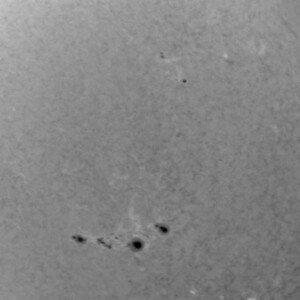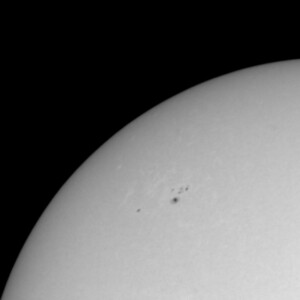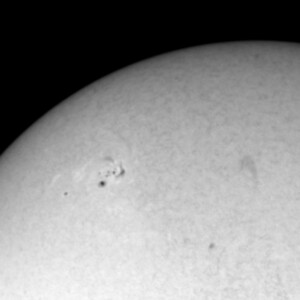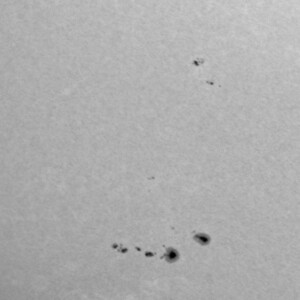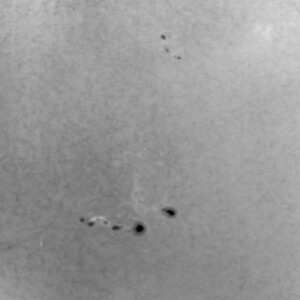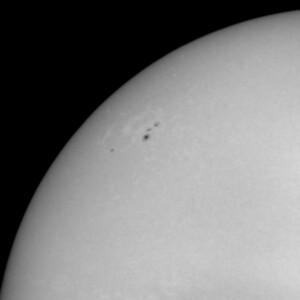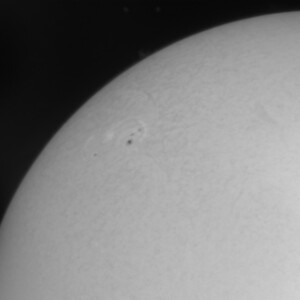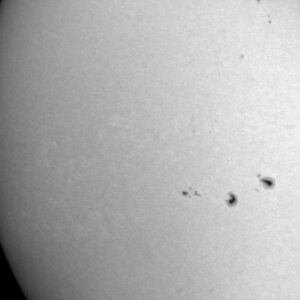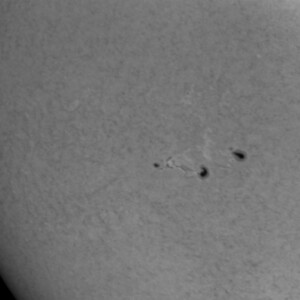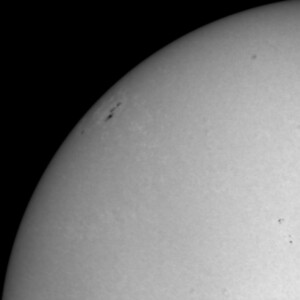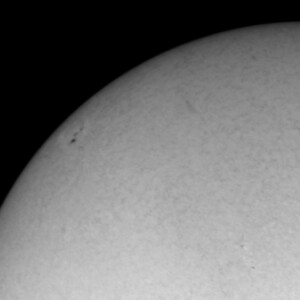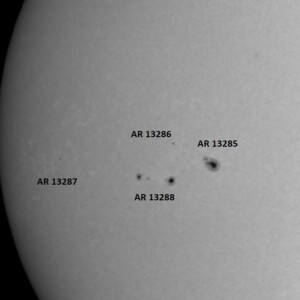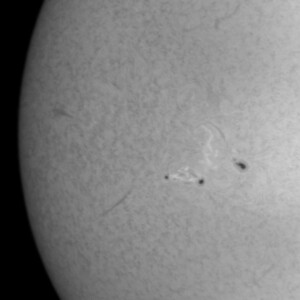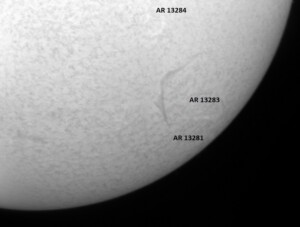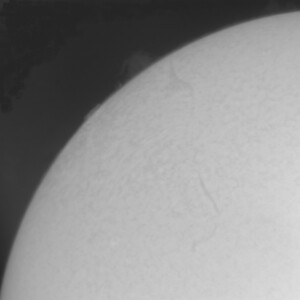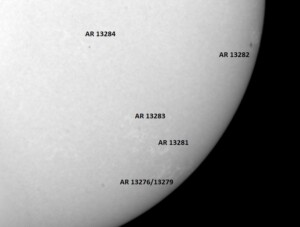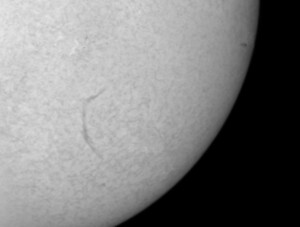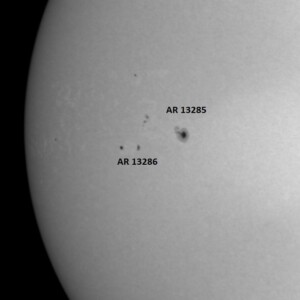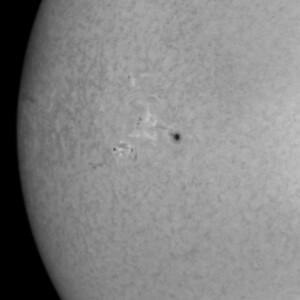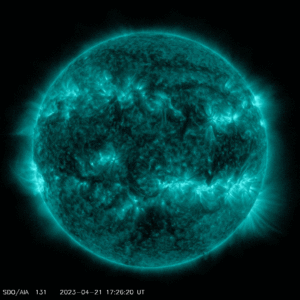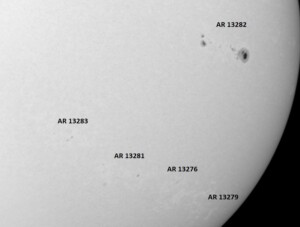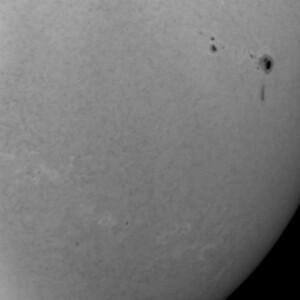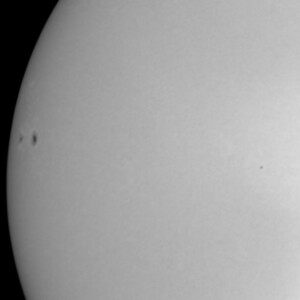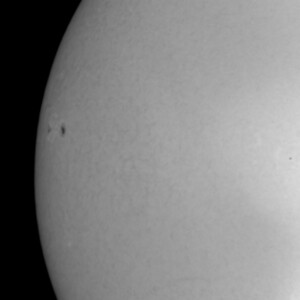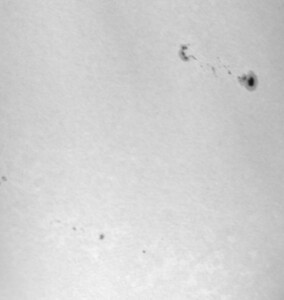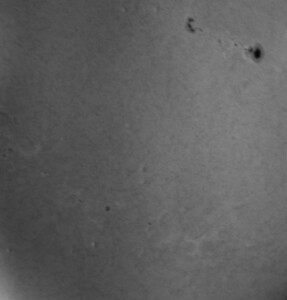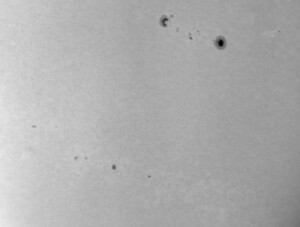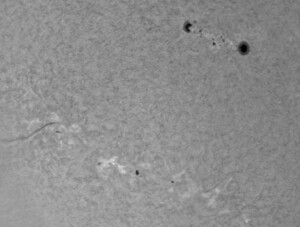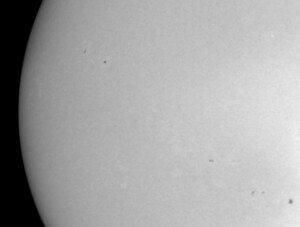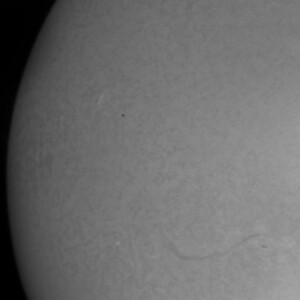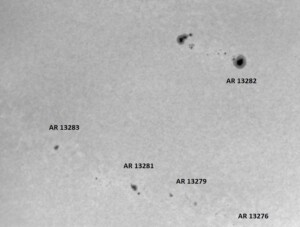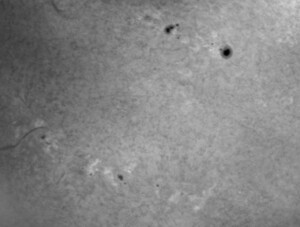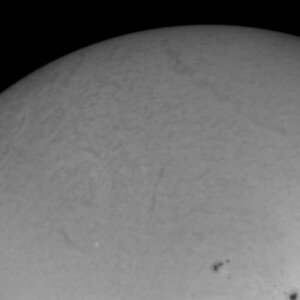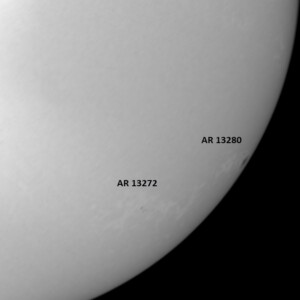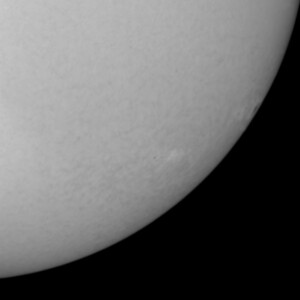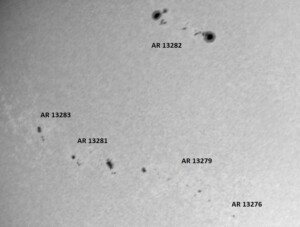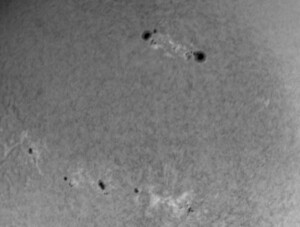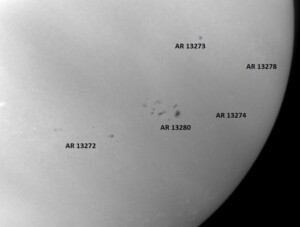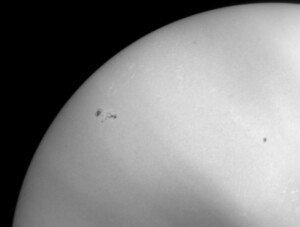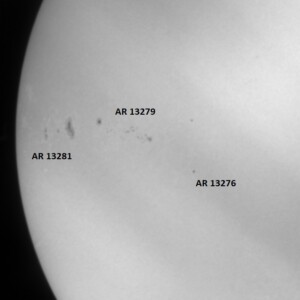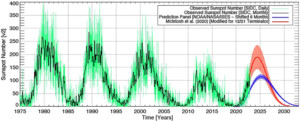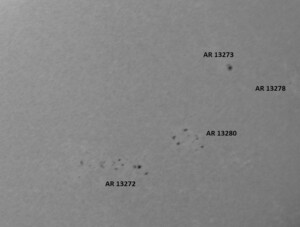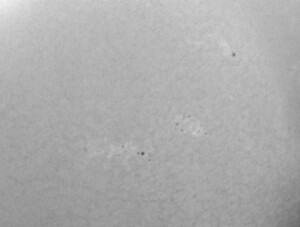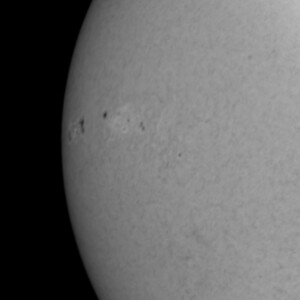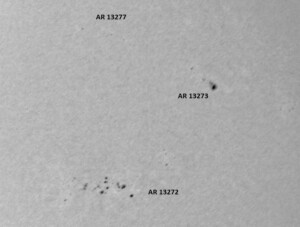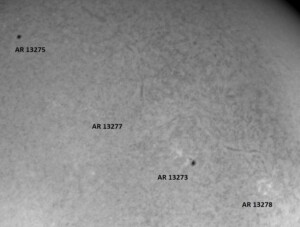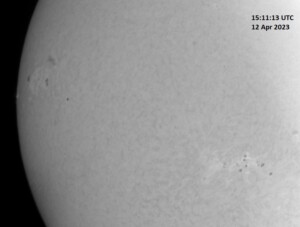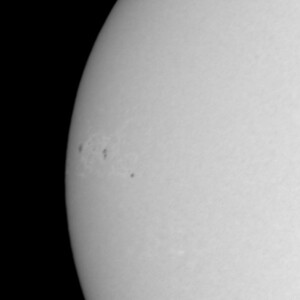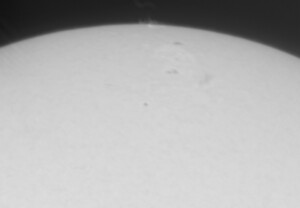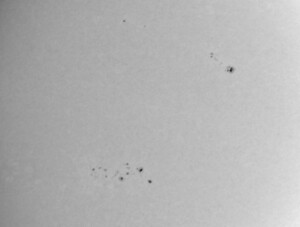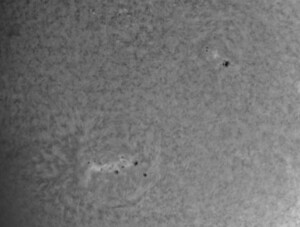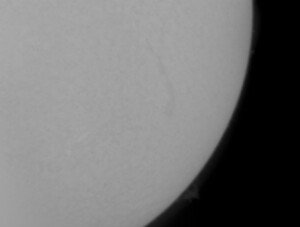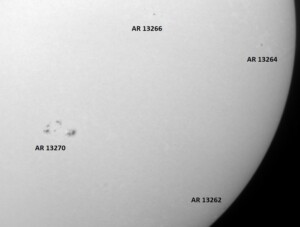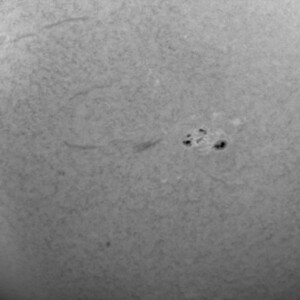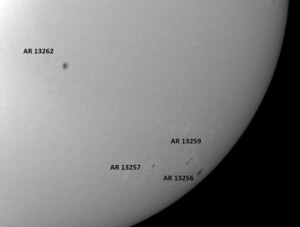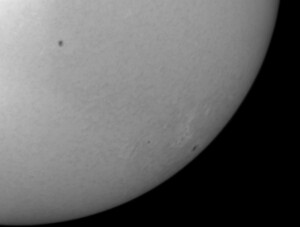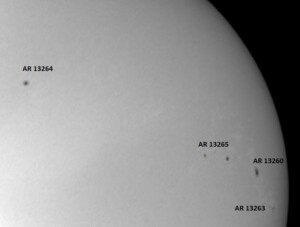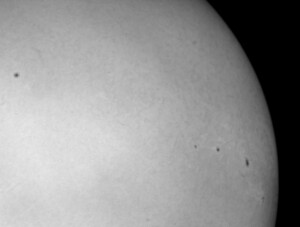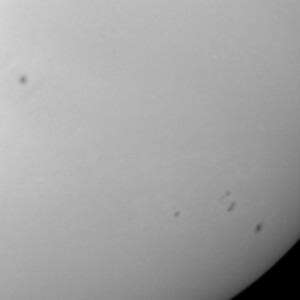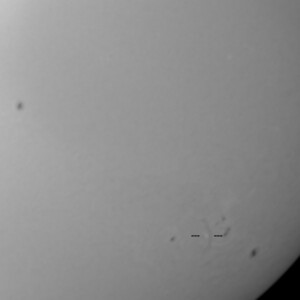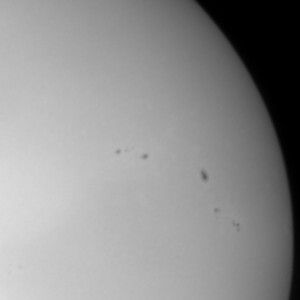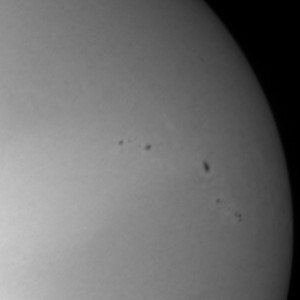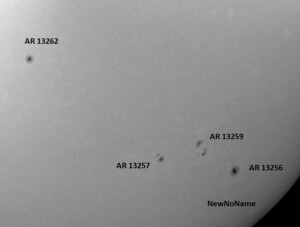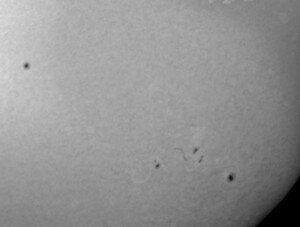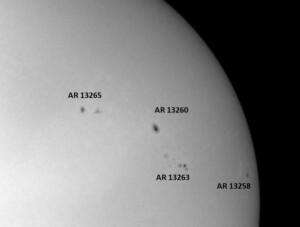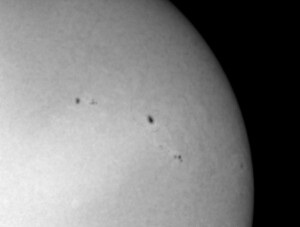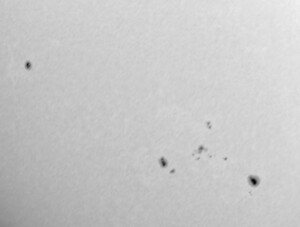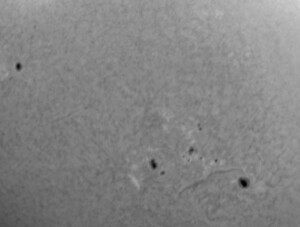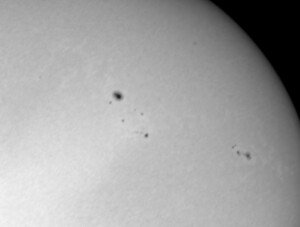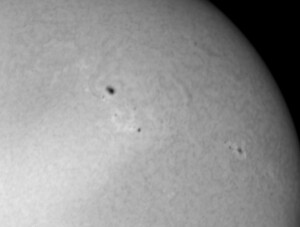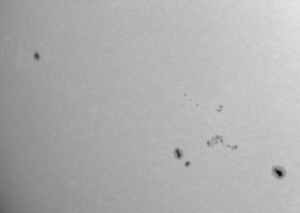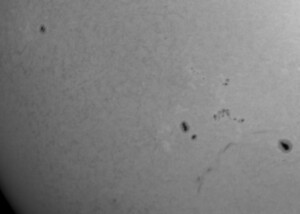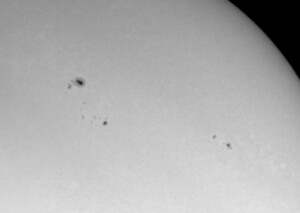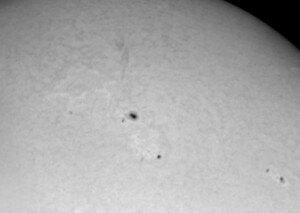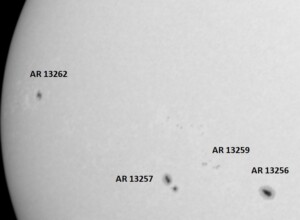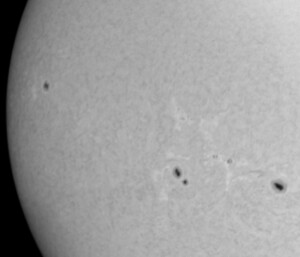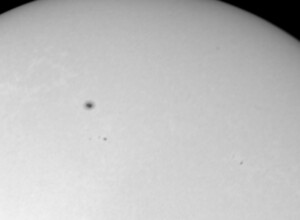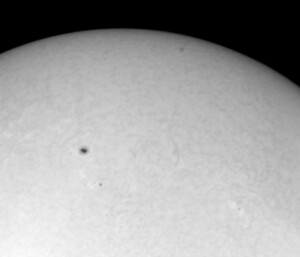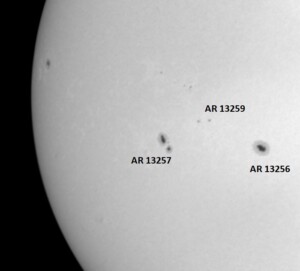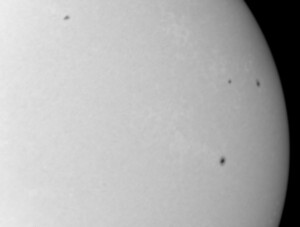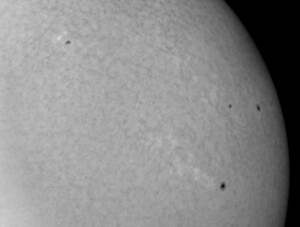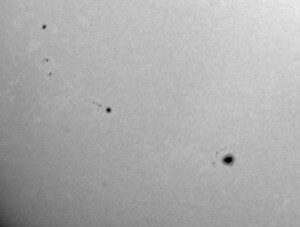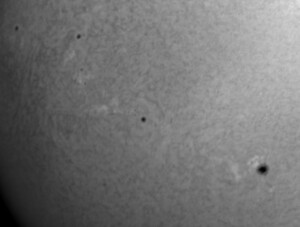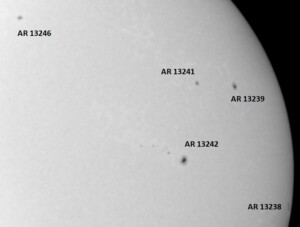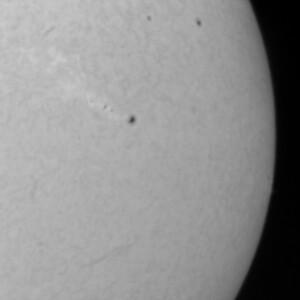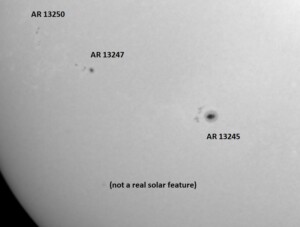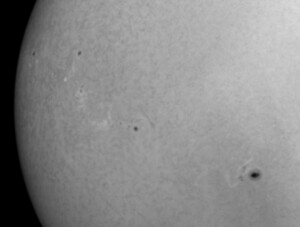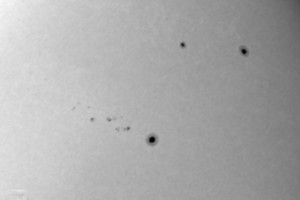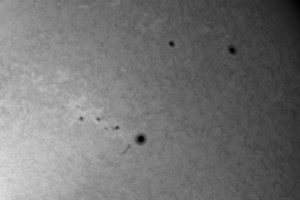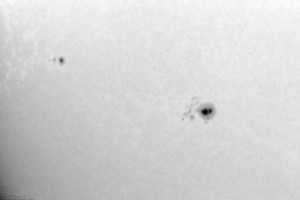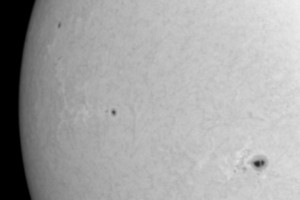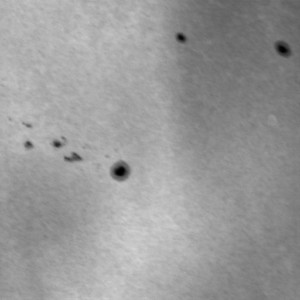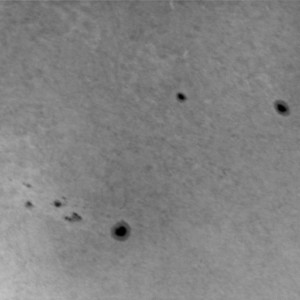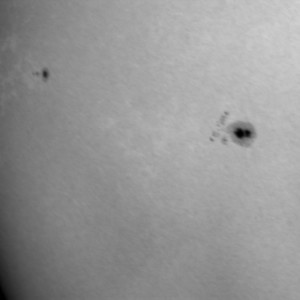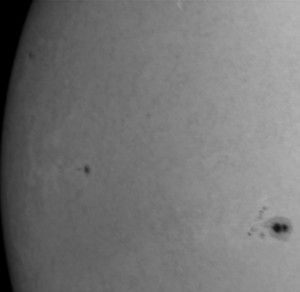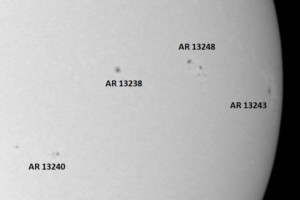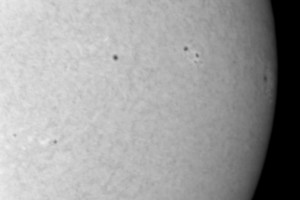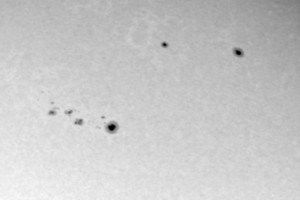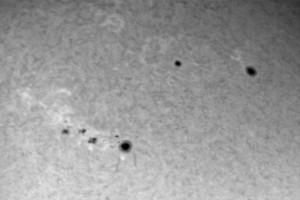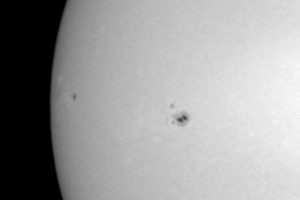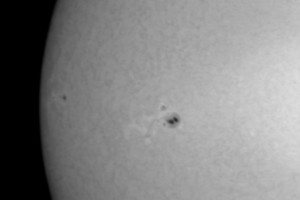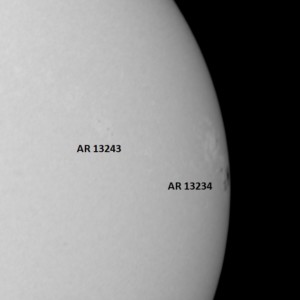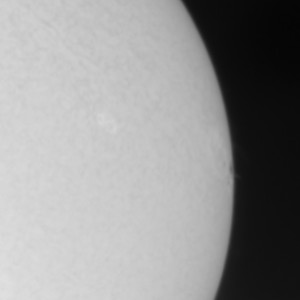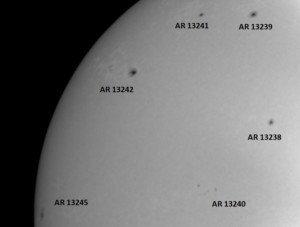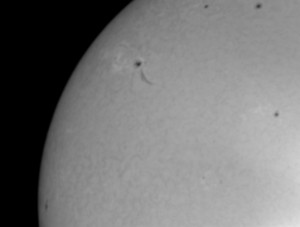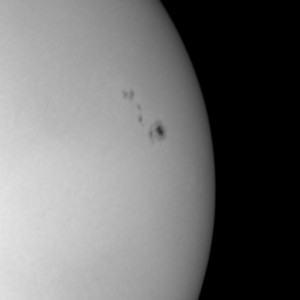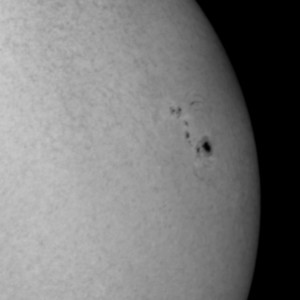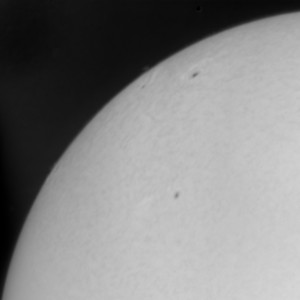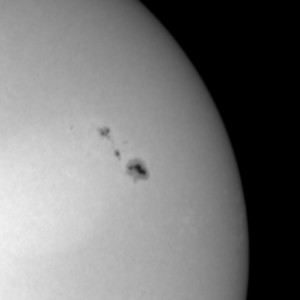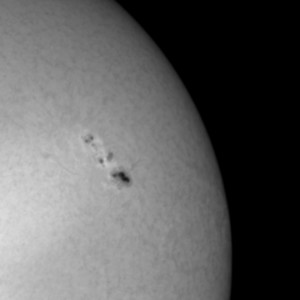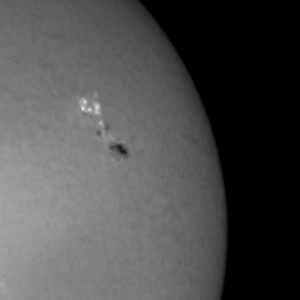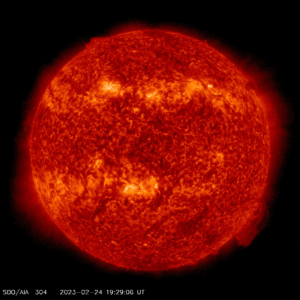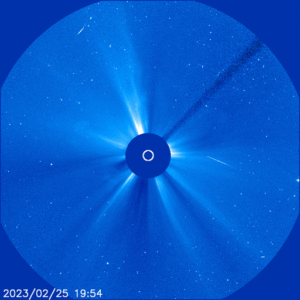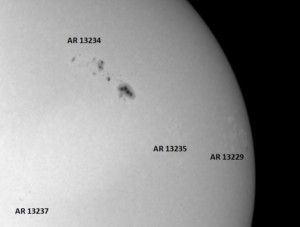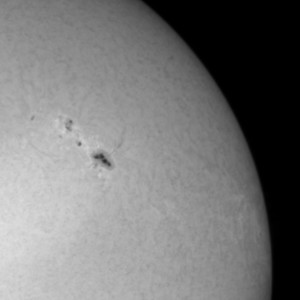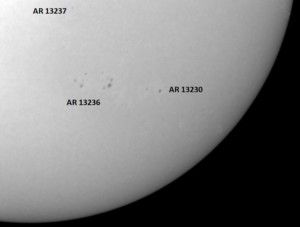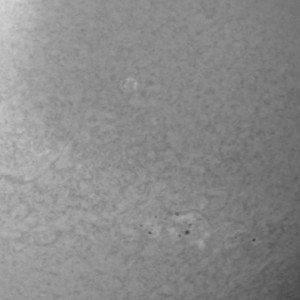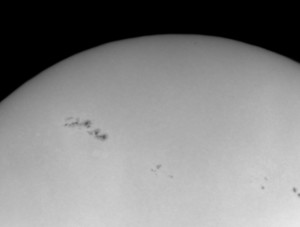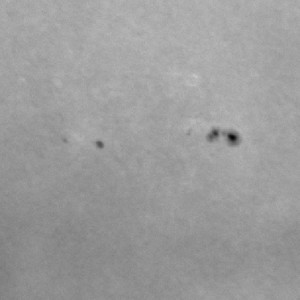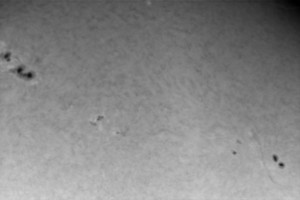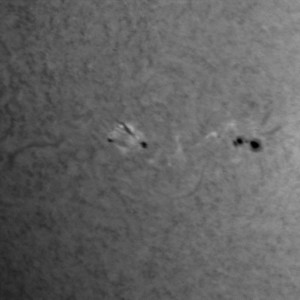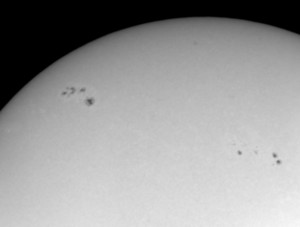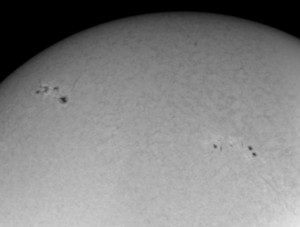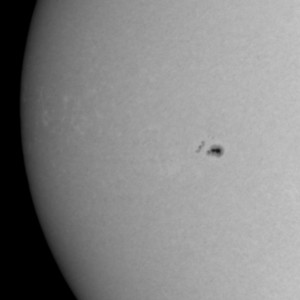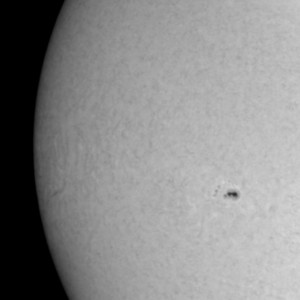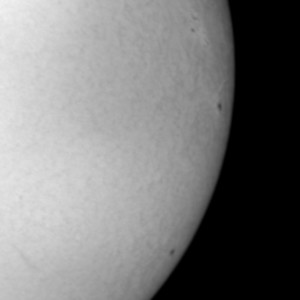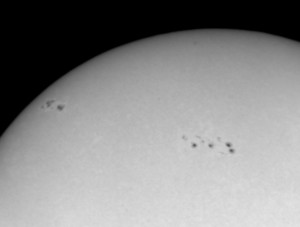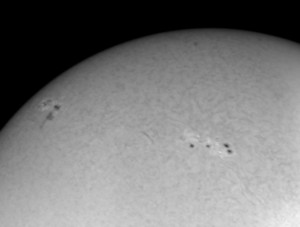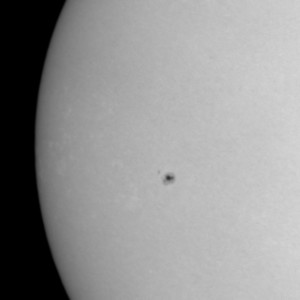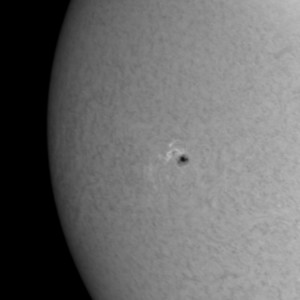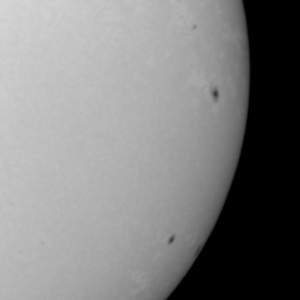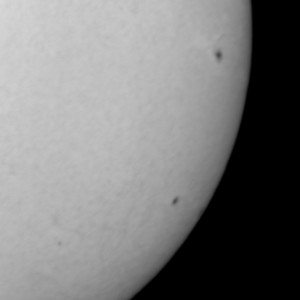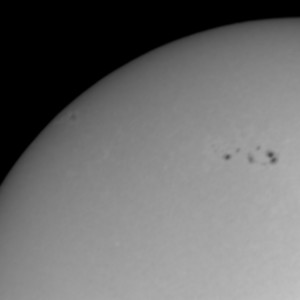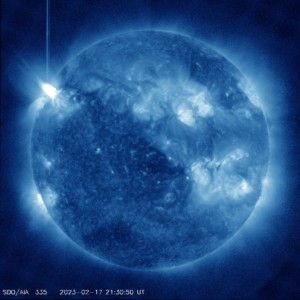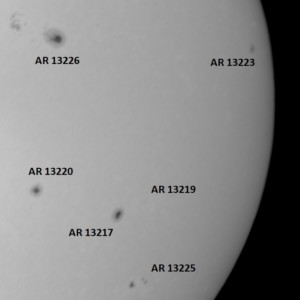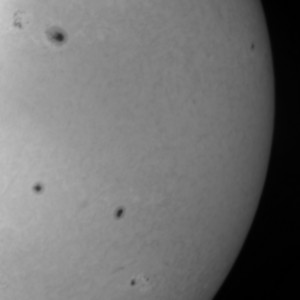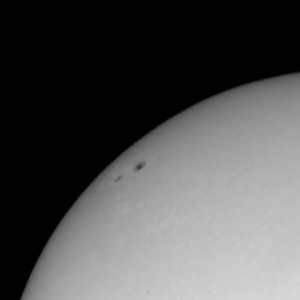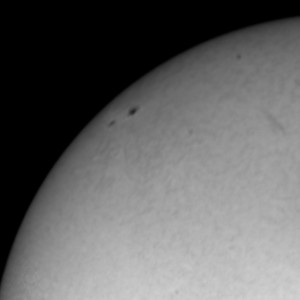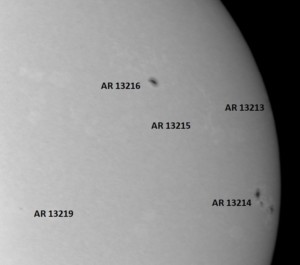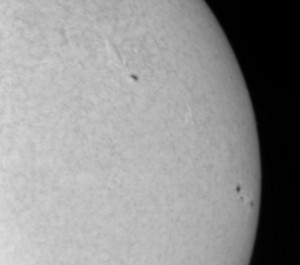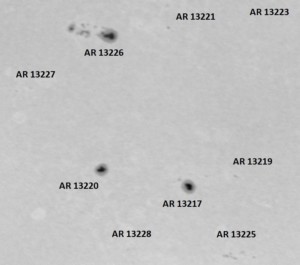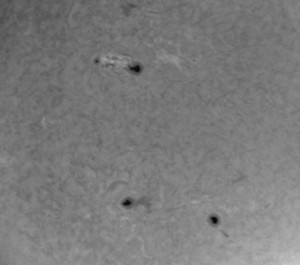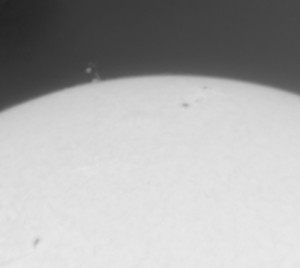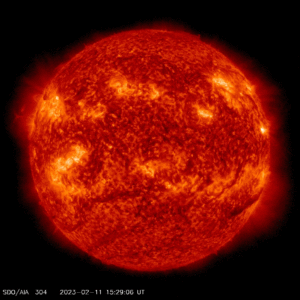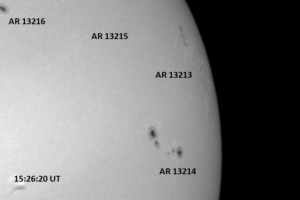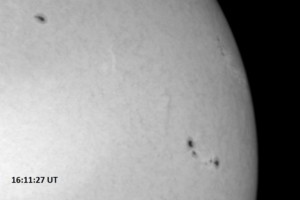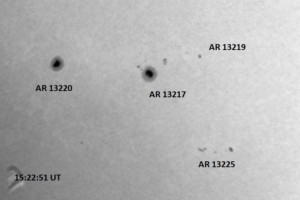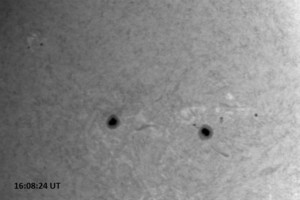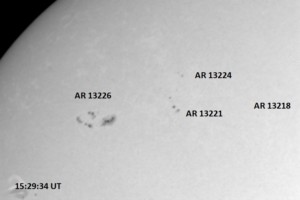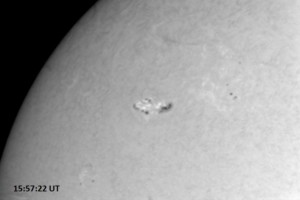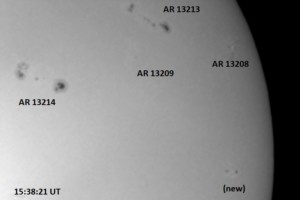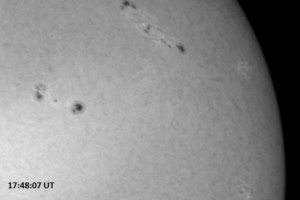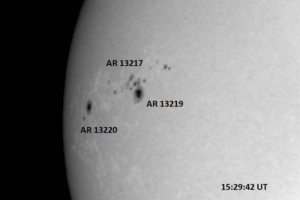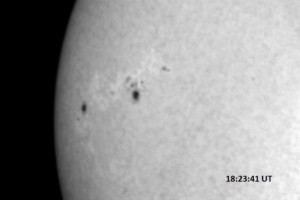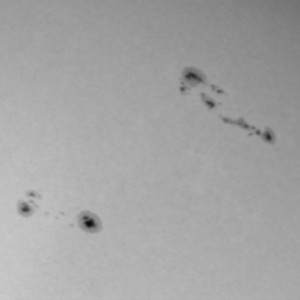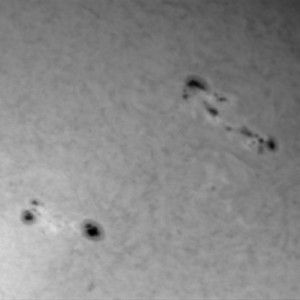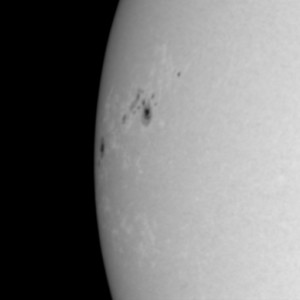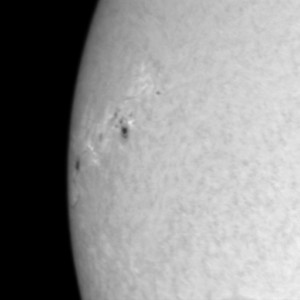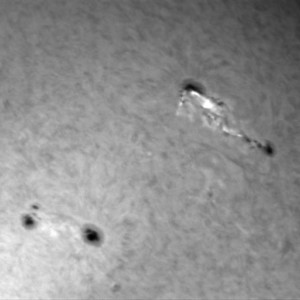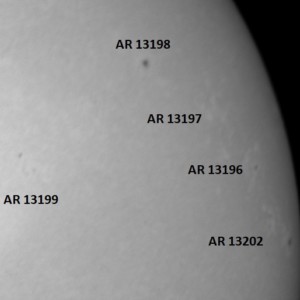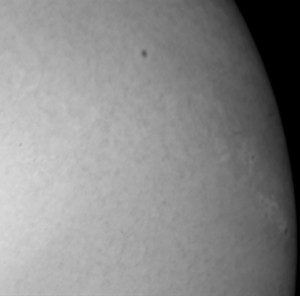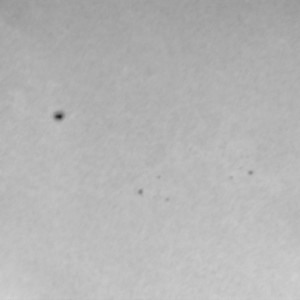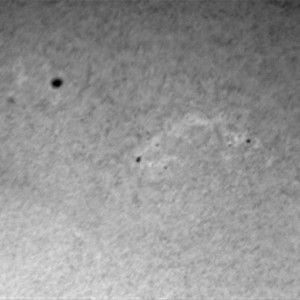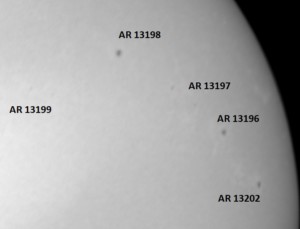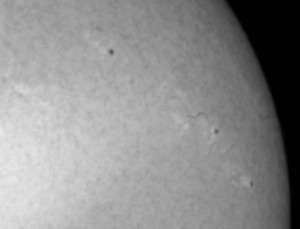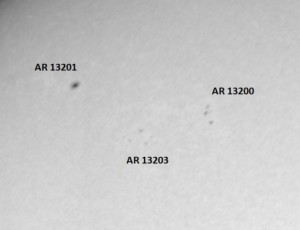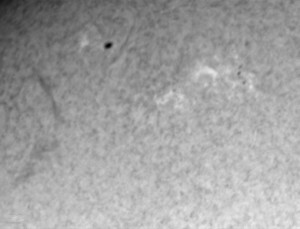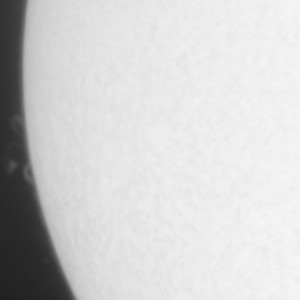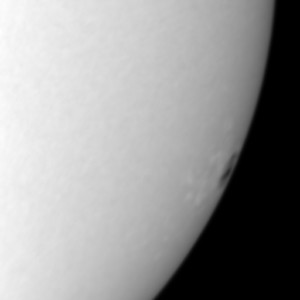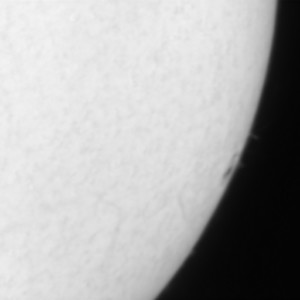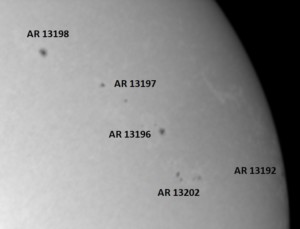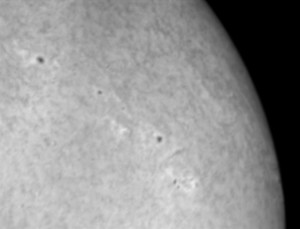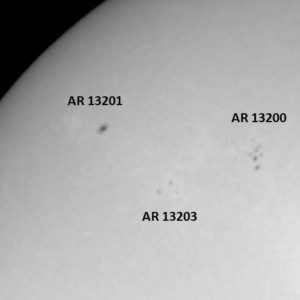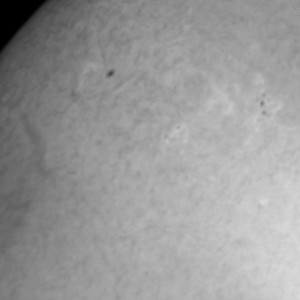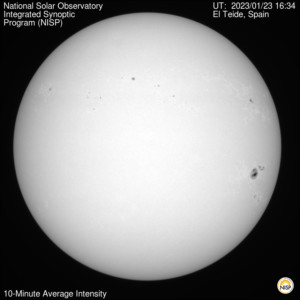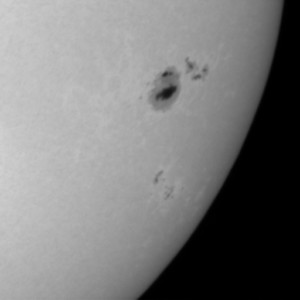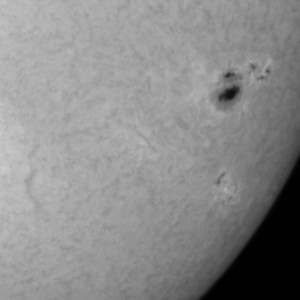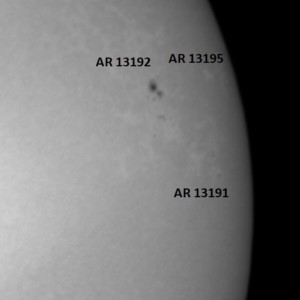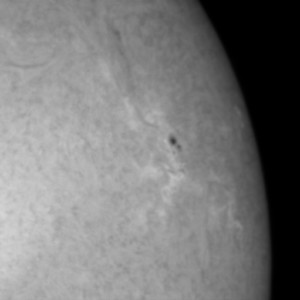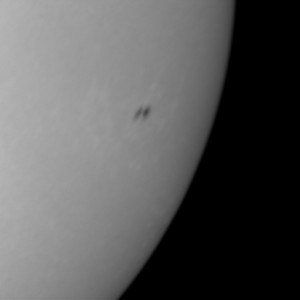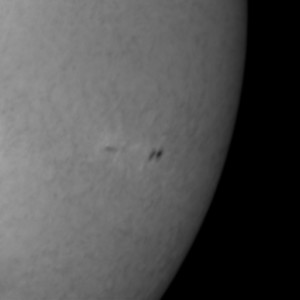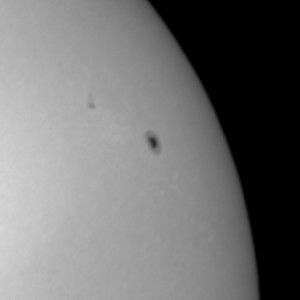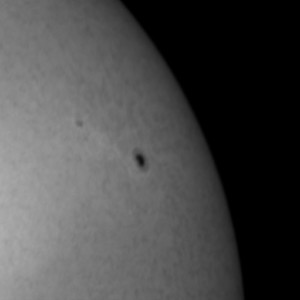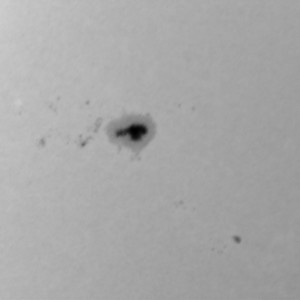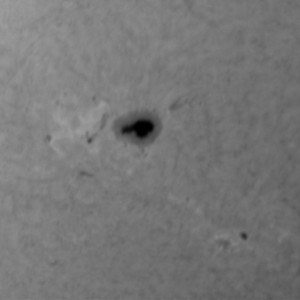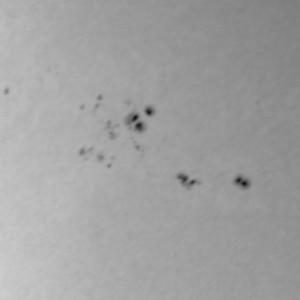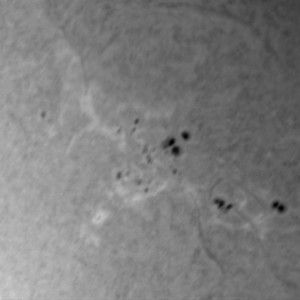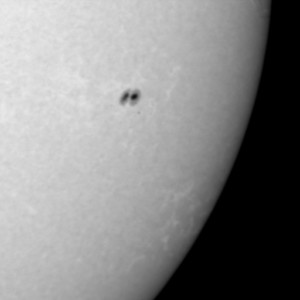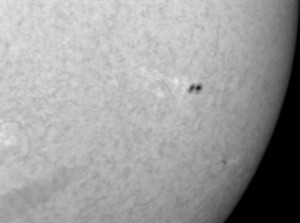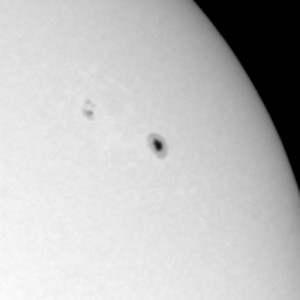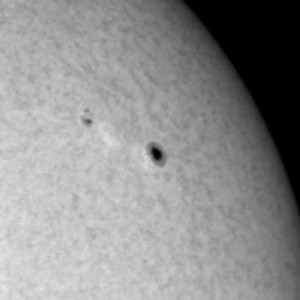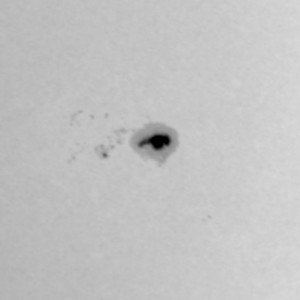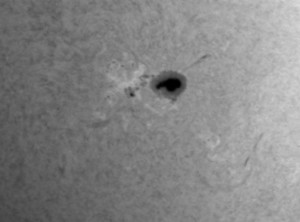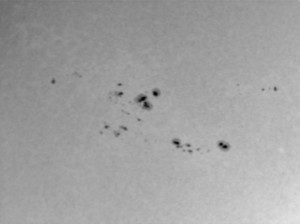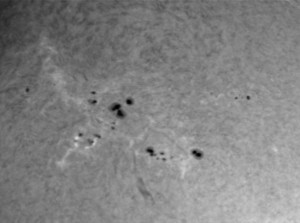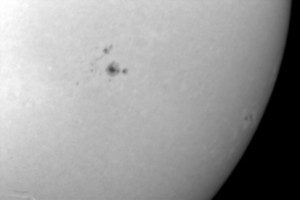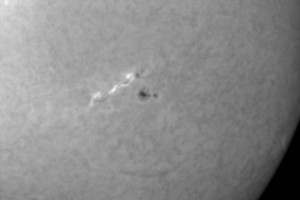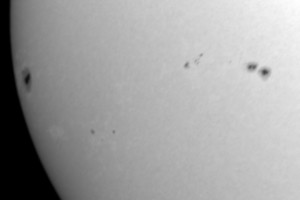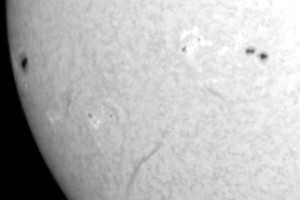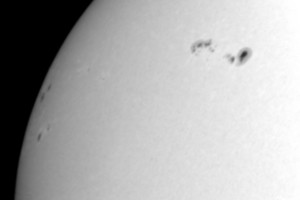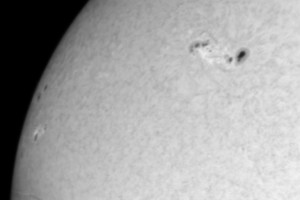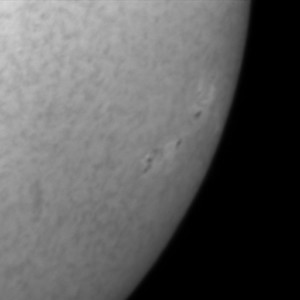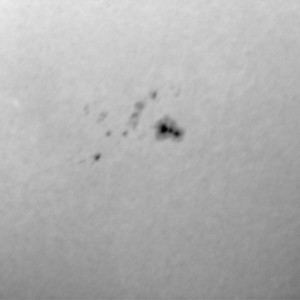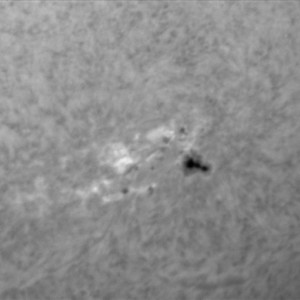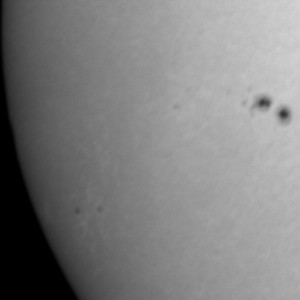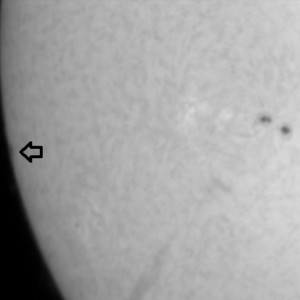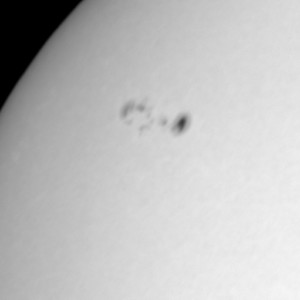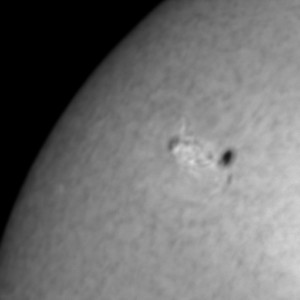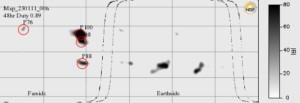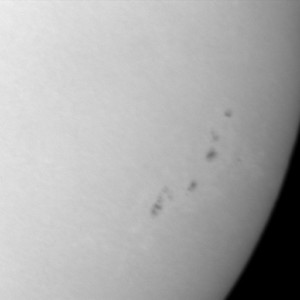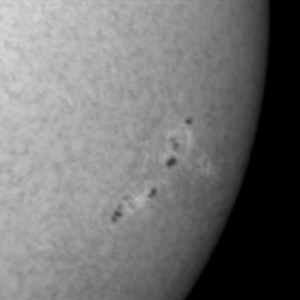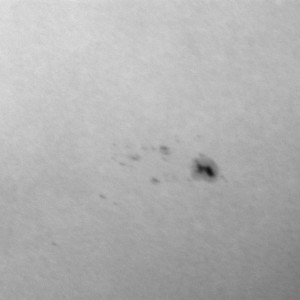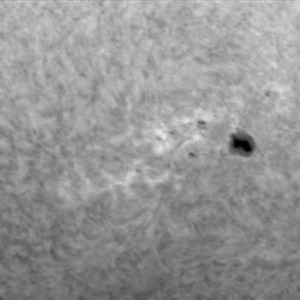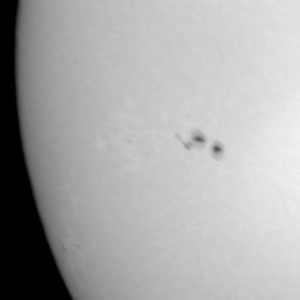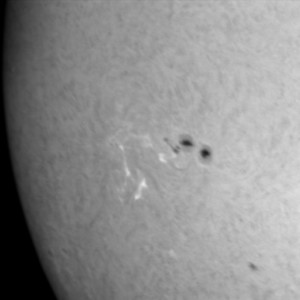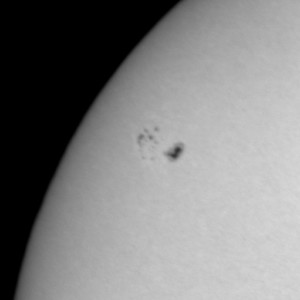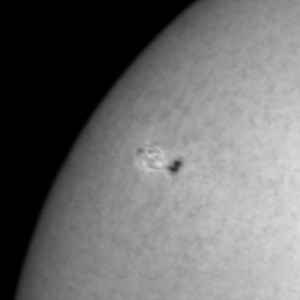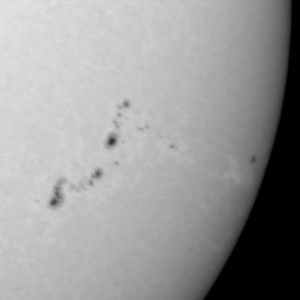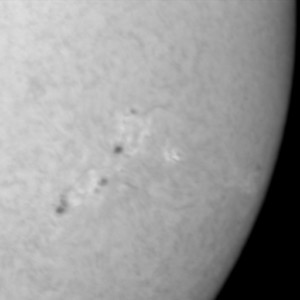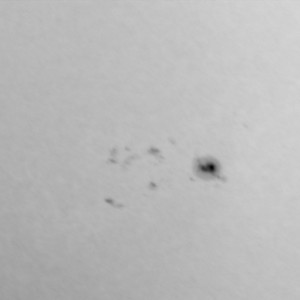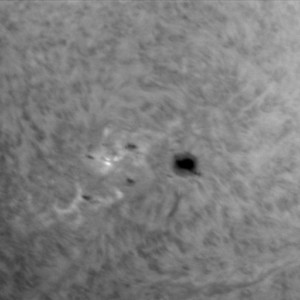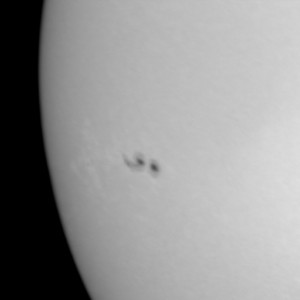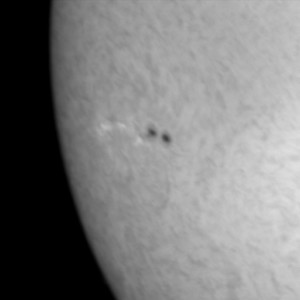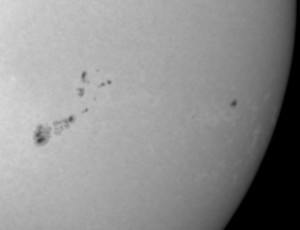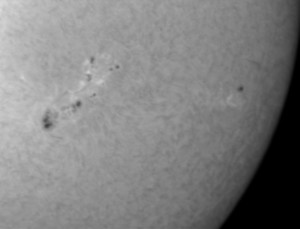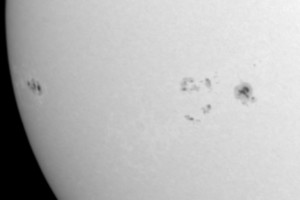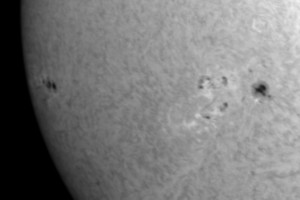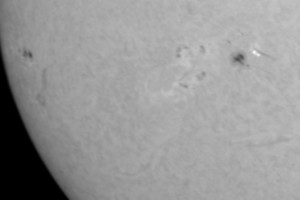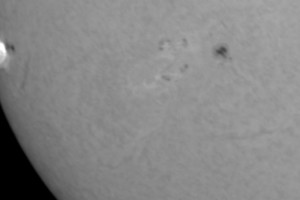The Latest Solar Images
Note: All images on this website © 2018-2024 by Brian Cudnik and Prairie View A&M Physics. All rights reserved.
Observations are happening daily, except for Saturday, Sunday, and holiday periods; and are governed by duty schedule, weather, and solar activity. When the Sun has very low activity (spotless), observations will be limited or non-existent. Whenever the Sun becomes active again, the observing program will become active as well, weather permitting.
One can monitor the Sun via several websites that provide real-time images of the Sun. The website, https://www.solarmonitor.org/, has such images in six different channels. The numbers are the NOAA designations for active regions (with the “1” at the start of the designation removed for convenience). Another website with up-t0-date information on solar activity and other goings-on in the skies is www.spaceweather.com. Additional information about the Sun’s current activity can be obtained from https://www.swpc.noaa.gov/, and real-time full-disk H-alpha images from observatories around the world can be viewed at http://halpha.nso.edu/.
A typical observing run may last from one to four hours, depending on seeing considerations, weather, and other work responsibilities, but will include active region monitoring of available active regions and the collection of frames for high-resolution solar mosaics in H-alpha. Each session includes at least one mosaic, which is a series of images made of all parts of the Sun’s disk that can later be stitched together to form a whole-disk image. At the very least, this ensures that all visible features such as prominences, filaments, and active regions (sunspot groups) are all captured in image form at least once per session. Usually observations are carried out in the late morning hours, but an additional session may occur in the mid-afternoon hours and it will include its own mosaic. If a sunspot group is expected to be active, then it becomes a main focus for observation for extended periods of time.
Solar activity is summarized in each day’s entry below, based on the forecast discussion product issued by the Space Weather Prediction Center each morning, along with observed activity (or lack of) the day of the featured observations. Regions are numbered by the NOAA/SWPC and are often provided in four-digit format (e.g. 3327), although I and other sources use the full five-digit designation (13327). Solar flares are described in terms of their X-ray intensity and optical “importance” (apparent brightness and area covered). Finally the SWPC 3-day forecast for solar activity is provided at the end of each entry.
More information about solar flares can be found at these websites: https://www.swpc.noaa.gov/phenomena; https://www.space.com/solar-flares-effects-classification-formation; and https://www.spaceweatherlive.com/en/solar-activity/solar-flares.html
The solar images are recorded through a Meade 16-inch f/8 Cassegrain telescope equipped with a 0.3 Å Hydrogen-alpha filter and a 16-bit, 3326×2504 pixel SBIG STF-8300 CCD camera. The aperture of the scope is stopped to 4-7/8 inch by an energy-rejection filter, which renders the system an f/26. A neutral density filter is added to bring the sunlight intensity down by 90%. Each image is automatically dark-subtracted as it is saved and each exposure is 0.1 second long for the red off-band continuum images and 0.5 second for the on-band H-alpha images. Flat field images are taken at periodic intervals throughout the observing session and are obtained by training the telescope to focus near the center of the Sun’s disk. Five images are then taken while dithering the frame 1′ to 5′ N,S,E, and W. The idea is to try to get images that are slightly blurred (either due to seeing or scope motion) and off set from each other. A set of 30 bias images (0-second exposures with the dome closed and scope parked) are taken at the end of each observing session.
Select images are processed for further study and display. A program called MaxIM DL is used to do basic calibration (bias-subtraction and flat field correction), and the levels are adjusted for optimum display contrast. Choice images are then selected for online display. All of the images are archived in their raw FITS format, sorted by date, and backed up twice. At a later time we can mass process these and make them available for scientific use. Inquiries can be made of Brian Cudnik, at bmcudnik@pvamu.edu, or Premkumar Saganti, at pbsaganti@pvamu.edu.]
==========================================================
December 20, 2023
The Sun remains at low activity levels. AR 13521 has grown some and produced three higher-level C-class flares: a C7.5/SF today at 5:53 UT, a C7.9/SF today at 6:03 UT, and a C8.2/SF today at 8:54 UT. AR 13519 also grew some and was the source of a C7.9/SF today at 9:36 UTC. AR 13529 maintained its complex (‘beta-gamma’) magnetic configuration; AR 13528 was mostly inactive despite showing some growth. AR 13531 rotated into view and was unremarkable until it produced a C6.8 flare today at 17:27 UT. The rest of the nine spotted active regions on the visible solar disk remained mostly quiet and unremarkable. Today’s flares came from AR 13519 and 13521 prior to 13:40 today, then ARs 13526, 13529, 13530, and 13531 each contributed flaring activity. The largest three active regions on the Sun are 13529 (250 MSH), AR 13526 (190 MSH) and AR 13528 (110 MSH).
Each of the images covers 18.0’x13.8′ except where indicated. The first column displays the red continuum images; the second column shows the H-alpha images, with the time of acquisition labeled on each one. Each is a 0.5 second exposure and is displayed so that celestial north is up, east is left (solar north is 7.8 degrees rotated left or counterclockwise of celestial north).
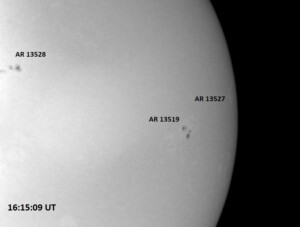 The western limb and disk of the Sun, showing three spotted active regions. AR 13527 is rotating out of view with 13519 to follow. The western limb and disk of the Sun, showing three spotted active regions. AR 13527 is rotating out of view with 13519 to follow. |
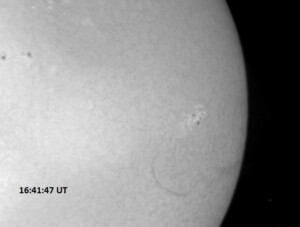 Same view as the image at left, but in H-alpha, showing some filaments south of 13519. Same view as the image at left, but in H-alpha, showing some filaments south of 13519. |
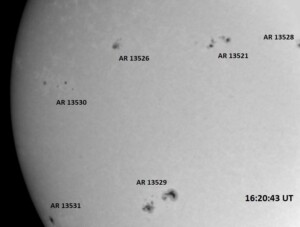 Many spotted active regions (labeled) appear in this view of the eastern disk and limb. Many spotted active regions (labeled) appear in this view of the eastern disk and limb. |
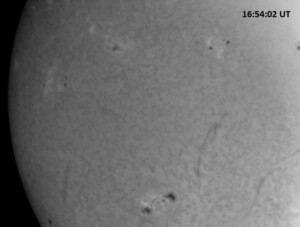 Several filaments (mainly in the lower half of the image) are also present, made visible by the H-alpha filter. Several filaments (mainly in the lower half of the image) are also present, made visible by the H-alpha filter. |
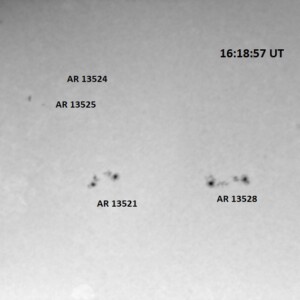 Four active regions, three of them spotted, are seen in this view taken near the center of the solar disk. This image is 13.8’x13.8′ in extent. Four active regions, three of them spotted, are seen in this view taken near the center of the solar disk. This image is 13.8’x13.8′ in extent. |
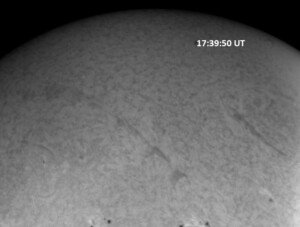 The large filament remains visible in the northern hemisphere of the Sun. A second, smaller filament appears in the right part of the image. AR 13528 appears, in part, in the center lower edge of the image; AR 13521 is to the left of it. The spot near the lower right corner is an image artefact, but the brighter region is plage from spotless AR 13518. The large filament remains visible in the northern hemisphere of the Sun. A second, smaller filament appears in the right part of the image. AR 13528 appears, in part, in the center lower edge of the image; AR 13521 is to the left of it. The spot near the lower right corner is an image artefact, but the brighter region is plage from spotless AR 13518. |
Solar activity is expected to be low with a chance for isolated M-class flares through at least 22 December.
December 19, 2023
Despite the increasing number of sunspot groups on the solar disk today, solar activity remains low. Since the M1.1 flare on 17 December at 20:15 UT, there had been no M-class flares since (through this writing, 21:06 UTC 19 December). There’s been only C-class activity since. AR 13519 has, after a couple days of growth, begun to show signs of decay. AR 13426 is growing and produced a C4.0 flare at 20:36 UT on the 18th. This region was responsible for most of today’s reported flares, including a C7.3 today at 3:04 UT. AR 13529, also growing, produced the most recent two flare, including a C7.1 at 15:39 UT. AR’s 13528 and 13530 are also growing. The other spotted regions are all unremarkable.
Except for the bottom most image, the first column are red continuum images, and the second column are H-alpha line-centered images. All were recorded at the time indicated on each image. The two red-continuum images are 0.25 second exposures, and the four H-alpha images are each is a 0.5 second exposures. Celestial north is up, east is left in each image. Solar north is rotated 8 degrees left, or counterclockwise, in each image.
Solar activity is expected to be low with a chance for M-class flares on 19 December, and a slight chance of M-class flares on 20-21 December.
December 16, 2023
Solar activity returned to low levels as AR 13514 slowly decayed. It was responsible for the bulk of the C-class activity today and yesterday. AR 13519 had grown slightly, but the rest of the spotted regions, including newly numbered regions 13522 and 13523, were mostly quiet and unremarkable.
The images below are each 0.5 second exposures, covering 13.8’x13.8′ on the sky. The red continuum images are found in the first column, with the H-alpha line images in the second column. Celestial north is up, east is left, with solar north is rotated 10 degrees left/counterclockwise of celestial north.
Solar activity is likely to be moderate, with a chance for X-class flares (from AR 13514) on 16-17 December. Activity should decrease to low levels, with a chance for M-class flares, on 18 December, as AR 13514 rotates beyond the western limb of the Sun
December 15, 2023
Skies cleared enough for about twenty minutes today to obtain some follow-up images of the Sun. There was only enough time for the continuum imaging sequence; the skies completely clouded over by the time the H-alpha filter was on line for imaging. Since yesterday’s notable X2.8 flare, there had been only C-class flares, until AR 13514 produced a pair of M-class flares in quick succession: an M6.3/1N flare today at 7:15 UT, followed 19 minutes later by an M6.9/SF at 7:34 UT. Since these events, the Sun had quieted down dramatically, with only low-level C-class and optical sub-flares, all (except one subflare from AR 13519) from AR 13514. This low state continues through this writing (20:40 UT, 15 December). There was an erupting filament channel in the northeast quadrant of the solar disk observed yesterday starting at 11:30 UT. This was not observed from PVSO. Most of the significant spot development happened with AR 13514; the remaining regions remained quiet, unchanged, and/or relatively simple.
All the images below are red-continuum. The first column are the images, with the second column being copies of each image, but with the image time and active region labels included. Each is a 0.5 second exposure, with celestial north up, east left. The top row images cover 13.8’x13.8′ on the sky while the bottom images cover 17.4’x10.5′ on the sky. Solar north is rotated 10 degrees left/counterclockwise of celestial north.
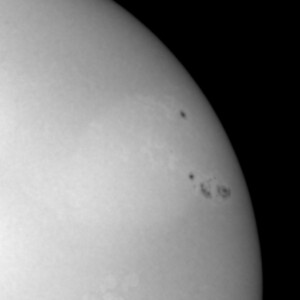 |
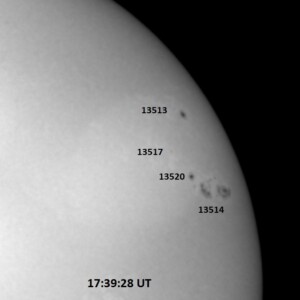 |
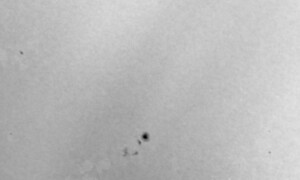 |
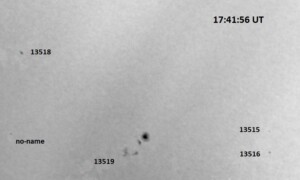 |
Solar activity is expected to be moderate, with a chance for isolated X-class flares (from AR 13514) through at least 16 December.
December 14, 2023
Solar activity reach high levels this morning and stayed there for the rest of the day. AR 13514 was responsible for an M5.8/SF at 7:44 UT today. This region has grown significantly yesterday, being much more impressive in appearance today than two days ago when it was last observed. This region was the source of several other C-class flares as well as the largest flare of the current solar cycle so far, an X2.8/1B flare at 17:02 UT. AR’s 13519 and 13520 also grew, with the remaining active regions being quiet and stable.
The X2.8 flare was the largest since the X8 and X9 flares of September 2017. It was the largest since September 10, 2017 and produced radio sweeps and bursts as well as a 4800 sfu (solar flux units) tenflare (a solar flare which produces a 10-cm radio noise burst that exceeds 100% of the preflare 10-cm flux level). Radiation from this event caused deep shortwave radio blackouts over the southern half of North America and all of Central and South America. A Type-II radio burst was reported by the U.S. Air Force shortly after the event. The flare generated a lop-sided coronal mass ejection (below, click on the image for the animation) which is expected to travel in excess of 2100 km/s or 4.7 million mph.
Except for the teal image below, the first column are red continuum images, and the second column are H-alpha line-centered images. Each is a 0.5 second exposure and each image of AR 13514 covers 13.8’x13.8′. The two of AR 13519 and more each cover 18.0’x13.8′. Celestial north is up, west is right in each image.
Solar activity is expected to be low with an increasing chance for isolated M-class flares through 16 December. This is due tot he increased magnetic complexity of AR’s 13514, 13519, and 13520; also several active regions are expected to return during this time.
December 12, 2023
Solar activity continued to be low. AR 13511 has rotated out of view, so the C-class flares from it have stopped being detected at Earth. AR 13513 has shown some decay and was mostly inactive yesterday, but today produced a C1.3 / SF at 12::41 UT. It remains the largest on the visible disk, at 210 MSH, over 3 times larger than the next largest sunspot. Six spotted active regions, five numbered, remain visible on the solar disk. The sixth is starting to come into view on the ENE limb of the Sun. AR 13514 has grown some and has produced several C-class flares today, including a C9.1/SF at 3:38 UT today; and a C8.2/SF at 13:42 today. AR 13517 continues to grow but remains quiet as is the rest of the spotted active regions.
The first column images were taken in red continuum, the second in H-alpha. Each image covers 13.8’x13.8′ on the sky and is a 0.5 second exposure. North is up, east is left (solar north is rotated left by 13 degrees)
Solar activity is expected to be low, with a chance for M-class flares (from AR’s 13513 and 13514) through at least 14 December.
December 11, 2023
The Sun became moderately active late yesterday due to an M1.4 flare from AR 13511 at 22:34 UT on 10 December. This region also was the source for most of the C-class activity yesterday and today. The region is decaying slightly as it approached the solar limb. AR 13513 is the largest region on the visible solar disk, at 220 millionths of a solar hemisphere (MSH) in size, it appears considerably larger than AR 14511, at 140 MSH. The remaining spot groups are less than 100 MSH, with sizes ranging from 10 to 70 MSH. AR 13513 has complex magnetic fields and has grown a bit but remained quiet all day yesterday and today. The remaining regions were unremarkable, with AR 13517 emerging yesterday between AR 13513 and 13514.
The first column images were taken in red continuum, the second in H-alpha. Each image covers 13.8’x13.8′ on the sky and is a 0.5 second exposure. North is up, east is left (solar north is rotated left by 112 degrees)
There is an elevated likelihood of M-class flaring today and tomorrow, due to AR 13511 and 13513 flare potentials. There is also a slight chance for an X-class flare through 12 December. Activity decreases to a chance of M-class flares on 13 December as AR 13511 rotates over the limb.
December 8, 2023
Solar activity continued to be low. There had been no further M-class flares after the one described below-until AR 13511 produced an M5.4 that peaked at 23:06 UT. This sent solar activity to high levels after it being low since late December 6. Prior to this, the largest event since the M2 flare was a C8.1/SF at 20:57 UTC on 7 December from AR 13513. This region showed slight growth in the trailing parts. The leading spots of AR 13511 also have grown somewhat. AR 13514 shows slight decay while AR 13505 and 13512 decayed to spotless plage. There were lots of low- to medium-level C-class flares today, from AR’s 13511 and 13513.
The first column images were taken in red continuum, the second in H-alpha. Each image covers 13.8’x13.8′ on the sky and is a 0.5 second exposure. North is up, east is left (solar north is rotated left by 13 degrees)
Solar activity is expected to be low, with a chance for M-class flares through at least 10 December.
December 6, 2023
The Sun continues to maintain moderate levels of activity. AR 13513 continues to produces lots of C-class and several M-class flares. One was an M2 flare at 5:41 UT on 6 December; another was an M2.3 flare just observed at 21:44 UT this afternoon. AR’s 13510 and 13511 grew slightly, with 13511 producing a C8/SF at 18:03 UT on 5 December. Just south of AR 13513 is a new spot group, AR 13514, the source of a small flare kernel captured in yesterday’s observations. It produced an optical subflare today. All the flare events, with two exceptions, came from AR 13513. A C1.3 came from AR 13507. Several filaments erupted yesterday and there was possibly one in progress as captured by our camera of AR 13513. The tall prominence (referred to as a filament when it is seen against the Sun’s bright disk) was gone a couple hours later in GONG imagery.
The first column images were taken in white light, the second in H-alpha, as was the single image below the table, which depicts the M2.3 flare two minutes after its X-ray maximum. This image shows reduced contrast because it was taken through a thin sheet of cirrus clouds. Each image covers 13.8’x13.8′ on the sky and is a 0.5 second exposure. North is up, east is left (solar north is rotated left by 14 degrees)
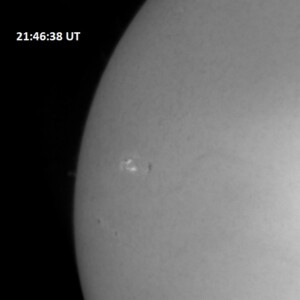 The M2.3 flare (bright spots) just past maximum.
The M2.3 flare (bright spots) just past maximum.
Solar activity is expected to be low, with a chance for M-class flares through at least 8 December.
December 5, 2023
Today saw frequent C-class flaring after an impulsive M1/1F flare at 6:44 UT on 5 December. This came from AR 13513, which just rotated into view. This region also produced several mid- to high-level C-class flares yesterday and again today. AR 13507 is showing decay, but AR 13510 and 13511 are showing growth. None of these were very active, but AR 13510 just produced a C8.6/1N flare that peaked at 18:03 UT. The other spotted active regions showed little change, and AR 13501 has rotated out of view.
The first image is red continuum, the second and third are H-alpha images, each 0.5 second exposure taken at the indicated time. Celestial north is up, east is left in each image, which covers 13.8’x13.8′ on the sky.
Solar activity is expected to be low, with a chance for M-class flares, through at least 7 December.
December 4, 2023
Since last week’s impressive double flare that was documented in full during the observing session, solar activity has been predominantly low. Only two more M-class flares have happened since. Both were M1 and both occurred on 1 December. Since last week the complex of sunspot groups on the western part of the solar disk had rotated out of view, and today, the source of last week’s activity is nearing the very edge of the Sun, about to rotate out of view. The largest flare recently, and since the second M1 of 1 December, was a C8.1 that happened at 1:26 UT on 4 December from new region 13511. This is a rapidly growing region which was not visible during yesterday morning’s visual sunspot count session. AR’s 13500, 13507, and 13510 each produced a few low-level C-class events. The tail end of an optical sub-flare, with dark surging, was observed this morning at 16:51 near AR 13505. Aside from the rapid growth of AR 13511, and the tepid growth in AR’s 13507 and 13510, the other active regions on the solar disk were stable/unchanging.
Each of the below images cover 13.8’x13.8′ on the sky. The first column contains red continuum images, 0.25 sec exposures each; and the second has H-alpha images, 0.5 second exposures each; the time indicated on the image is when each image was taken. Celestial north is up, west is right in each image. Heliocentric (Solar) north is rotated 15 degrees to the left for each image.
Solar activity is expected to be low, with a chance for M-class flares through at least 6 December.
November 28, 2023
After an extended period of low solar activity, the largest flare prior to this afternoon was a C6.7 flare from AR 13500 at 18:52 UT on 27 November. There was a C2.1 from the same region at 4:48 UT today. Then things were quiet, with only a few optical subflares from AR’s 13490, 13500, 13502, and 13504. Then at 19:32, AR 13500 produced an M3.4, which was followed quickly by an M9.8 flare at 19:50 UT. All of this was documented at the Solar Observatory this afternoon. The monitoring started at 18:53 UT when some prominent dark surging activity caught my attention. This eventually became the first of two M-class flares. Images were grabbed every 30 seconds from 19:14 to 19:50 UT, then every 60 seconds thereafter. The cadence increased as the flare decay continued, and we monitored the region through 20:25 UT.
Other activity of note was a C8.1 flare from AR 13499 at 23:31 UT on the 28th. There are currently 12 spotted active regions on the visible disk, 9 of them numbered, with AR 13500 being the largest and most complex of the batch.
The below images were recorded at the times indicated, with the regions labeled in the two continuum images. The first two rows of the table below survey most of the visible regions on the Sun. The last row depict AR 13500 during the X-ray peaks of the two M-class flares recorded today. Each image covers 13.8’x18.0′ unless otherwise indicated. Celestial north is up, west is right in each image. The bottom teal-colored image is a Solar Dynamic Observatory animated image showing the flare in extreme ultraviolet light. This was posted to spaceweather.com which describes the flare in more detail. If you are visiting this site at a later date, load the November 29, 2023 version of the spaceweather.com page.
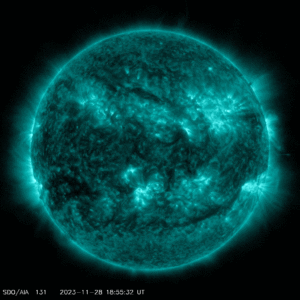 Click on the image for an animation of the solar flare.
Click on the image for an animation of the solar flare.
Solar activity is expected to be low with a chance for isolated M-class flares and a slight chance for an X-class flare, mainly due to AR 13500, through at least 1 December.
November 27, 2023
Despite the impressive looking active regions five days ago, and even more recently, solar activity remained low overall over the last five days. There were only 3 low-level M-class flare November 23/24, but lots of C-class flares. There were as many as 13 spotted active regions on the visible disk but that number has dropped to 11. Over the last day or so, low-level C-class flares were observed coming from AR’s 13490, 13492, 13500, and 13502. Some decay occurred in AR’s 13489, 13490, and 13502; while some growth was seen in AR’s 13499, 13503, and 13504. A filament approximately 33 degrees long (as measured on the solar disk) began to lift off the NW quadrant of the Sun overnight (local time) around 5:30 UT. This produced a CME that began around 6:24 UT. A few other filaments remain on the solar disk as of this morning.
The low activity continued into today with only occasional low-level C-class and sub-flare activity coming from AR’s 13490, 13492, and 13502. AR 13500 just produced a C6.7 flare, which peaked at 18:52 UT.
Each of the below images is a 0.5 second exposure and cover 13.8’x15.0′ on the sky. The first column contains red continuum images and the second has H-alpha images, each taken at the time indicated on the image. Celestial north is up, west is right in each image. Heliocentric (Solar) north is rotated 17 degrees to the left for each image.
Solar activity is expected to be low, with a chance for isolated M-class flares through at least 29 November.
November 22, 2023
More sunspots continue to rotate into view as the Sun transitions from a quiet to an active state. Despite appearances, overall activity remains low, with only four regions (AR 13489, 13492, 13493, and 13495) displaying flare activity. All the flares were C-class and optical subflares, the largest being a c8.9/SF from AR 13492 at 6:28 UT today. Another large active region is coming into view east of the AR 13493/13494 pair, and lots of prominence activity on the ESE and ENE limbs indicate even more are about to rotate into view.
The first two images below are the same red continuum of the many spotted regions visible near the eastern limb of the Sun. The first image is un-labeled, the second is labeled to show where each of the individual active regions reside. The third is an H-alpha image of the same zone. Each of these covers 13.8’x15.6′ on the Sun. Each image, taken at the UT printed on each, is a 0.5 second exposure and is oriented so that celestial north is up, west is right.
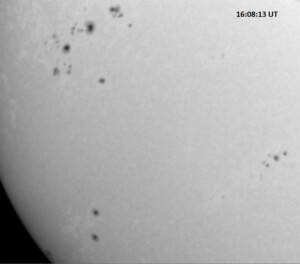 |
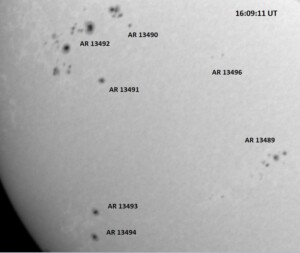 |
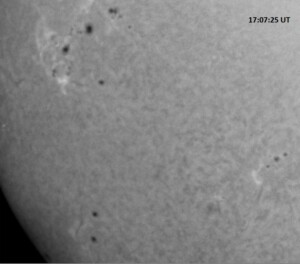 |
Solar activity is expected to be low, with a chance for M-class flares, through at least 24 November.
November 20, 2023
The Sun’s disk had transformed from being nearly spotless to having eleven spot groups in just a matter of days. A cluster of active regions has rotated into view over the weekend and are now becoming more clearly visible as they rotate into better view. Solar activity became moderate today as AR 13490 produced an M1.2 flare at 9:03 UT. AR’s 13489, 13490, and 13491 produced C-class flares. AR 13489 is growing and another region has emerged just behind/east of it.
The first two images below are the same red continuum of the many spotted regions visible near the eastern limb of the Sun. The first image is un-labeled, the second is labeled to show where each of the individual active regions reside. The third is an H-alpha image of the same zone. Each of these covers 13.8’x18.0′ on the Sun. Each image, taken at the UT printed on each, is a 0.5 second exposure and is oriented so that celestial north is up, west is right.
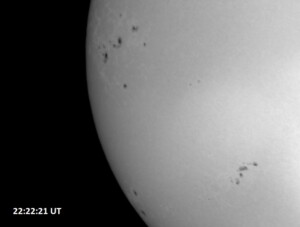 |
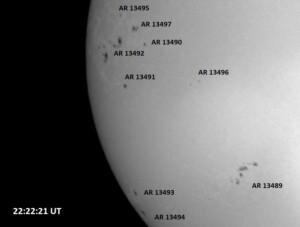 |
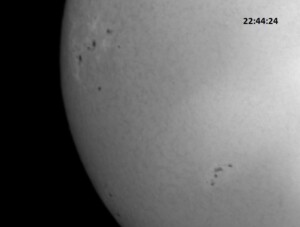 |
Solar activity is expected to be low, with a chance for M-class flares, through at least 22 November.
November 17, 2023
The Sun’s disk is almost spotless at this time, with only two small spotted active regions visible: AR 13486 on the western limb about to rotate out of view, and what will likely become AR 13489, rotating into view on the eastern limb. Both these regions, and 13487 (now invisible due to its proximity to the solar edge) remain stable and relatively quiet. Old active regions 13472 is anticipated to return on the 18th and 13474 on the 19th. Some surging was seen on the east limb, which may be one of them.
Each of the below images is a 0.5 second exposure and cover 13.8’x13.8′ on the sky. The first column contains red continuum images and the second has H-alpha images, each taken at the time indicated on the image. Celestial north is up, west is right in each image. Heliocentric (Solar) north is rotated 23 degrees to the left for each image.
Solar activity is expected to be low, with a slight chance for M-class flares through at least 19 November.
November 15, 2023
AR 13485 produced an isolated M1/SN flare late yesterday, at 23:05 UT on 14 November. This region is in the process of rotating off the visible disk. AR 13486 is the largest group on the visible disk, covering 140 Millionths of a Solar Hemisphere (MSH). Although AR 13483 is larger, at 260 MSH, it has rotated completely out of view. AR 13485 is the next largest after 13486, at 90 MSH but is largely hidden by its location on the solar limb. AR 13487 covers 30 MSH as does new region 13488, which had just rotated into view two days ago, but just lost its spot. Aside from these the Sun’s disk is almost blank. A lot of CME’s have erupted on the far side of the sun yesterday and today. Some of this activity may rotate into our view in a week or two.
All the visible regions are captured in one image (in two wavelengths, below). Each image is a 0.5 second exposure and is 13.8’x13.8′ in sky coverage, with the red continuum image at left and the H-alpha image at right. Celestial north is up, west is right in each image.
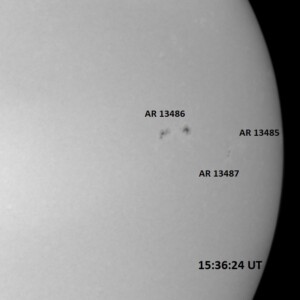 |
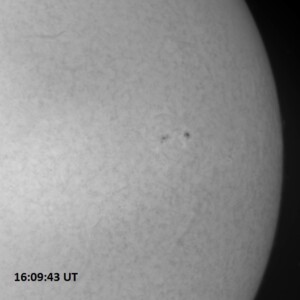 |
Solar activity is expected to be low with a chance for M-class flares through at least 17 November. AR 13486 would be the likely source of such flares.
November 14, 2023
After several days of being completely cloudy, the skies cleared for a few hours this morning (before clouding back up by noon local time). The Sun appears to be wiping its face clean of sunspots as the active longitudes of spots rotates toward and onto the western limb. AR 13486 and 13487 emerged a few days ago and the former is growing fairly rapidly. AR 13487 emerged rapidly yesterday but with otherwise unremarkable through today. Except for these two, the remaining four spotted active regions are either close to the limb, or (for AR 13477) have rotated over the limb. So there are five spotted regions visible, along with three spotless plage regions (two are on the western limb). No new regions appear to be rotating over the eastern limb.
Prior to today’s observing session, AR’s 13483, 13484, 13485, and 13486 were each producing low level C-class flares (C1’s), the largest of which was a C2.1 from AR 13483. Five more C-class flares occurred between 14:43 and 17:37 UT, but as of this writing no region has been attached to these. The largest of these fiver was a C2.7 as 15:31 UT (during the observing session but nothing unusual was observed on the Sun during this time). Further, a C5.8 event happened at 18:11 UT but no information is yet available for this event. This was the largest event so far since a C8.4 at 4:40 UT on 12 November. The most recent M-class event peaked at 17:29 UT on 11 November and was the only such event since at least 8 November.
All the visible regions are captured in one image (in two wavelengths, below). Each image is a 0.5 second exposure, with the red continuum image (left) covering 13.8’x13.8′ on the sky; the H-alpha image (right) is a bit larger, at 13.8’x14.6′ (to fit another filament into the frame). Celestial north is up, west is right in each image.
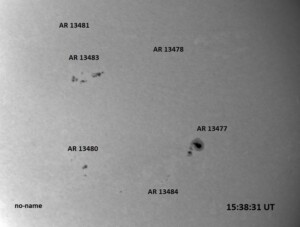 |
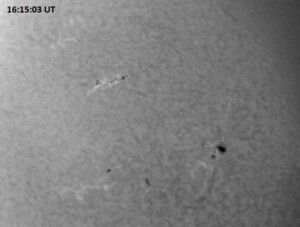 |
Solar activity is expected to be low with a chance for M-class flares today only. This chance decreases to just a slight chance through at least 16 November as AR’s 13483, 13484, and 13485 rotate over the western limb.
November 8, 2023
Solar activity continues at low levels, with new AR 13483 being the most active region on the visible solar disk. It produced the largest flare in over two days: a C6 at 8:48 UTC this morning. Since then the X-ray background has nearly flatlined at the C1.0 level and continues that way as of this writing (19:35 UT, 8 November). AR 13477 continues to be the largest region on the disk, at 260 millionths of a solar hemisphere (MSH), but it remained quiet. The other five numbered regions were 50 or less MSH. AR 13479 continued to grow and had some C-class activity yesterday but had only produced a sub-flare at 0:42 UT today. All of the regions have been unremarkable today.
There are many filaments on the solar disk today. They have been erupting fairly regularly over the last week or so. When a filament rotates onto the solar limb, it becomes a prominence. One such feature began erupting off the west limb, beginning at 7:30 UT, and it produced a CME which will remain far from Earth.
Each of the below images is a 0.5 second exposure and cover 13.8’x18.0′ on the sky, except for the continuum image of AR 13479 (lower left of the images), which is 13.8’x13.8′. The first column contains red continuum images and the second has H-alpha images, each taken at the time indicated on the image. Celestial north is up, west is right in each image. Heliocentric (Solar) north is rotated 23 degrees to the left for each image.
Solar activity is expected to be low, with a chance for isolated M-class flares through at least 10 November.
November 7, 2023
The Sun continues to be quiet, with only low-level C-class flares, mostly from AR 13480. It is the most complex active region on the visible disk, magnetically speaking, but it is losing some of that complexity. AR 13477 is also showing some decay as it crosses into the western half of the Sun’s disk. The other three spotted regions were unremarkable. However, there appears to be two new groups of flux: a possible resurgence of AR 13479 near the northwest limb, and a new region, likely AR 13483, situated just south of AR 13481 (decayed to plage), and north of the AR 13477/13480 pair.
The first image below is a red continuum of three spotted active regions. The second is an H-alpha image of the same zone. Each of these covers 13.8’x13.8′ on the Sun. The third is an H-alpha of the northwest disk, showing what appears to be a resurging AR 13479. This image covers 13.8’x18.0′ on the Sun. Each image, taken at the UT printed on each, is a 0.5 second exposure and is oriented so that celestial north is up, west is right.
Solar activity is expected to remain low, with a chance for isolated M-class flares, through at least 9 November.
November 6, 2023
The Sun appears to be quieting down once again. There was a pair of M1 flares from AR 13480 yesterday but today the Sun had been quiet. The spotted regions are decaying, now five remain as two rotated out of view and others have decayed. The largest flare over the weekend was an M1.6 from the above mentioned region. Another filament channel erupted yesterday from the northeast disk region, beginning around 15:00 UT. This generated a CME that will miss the Earth. Yet another filament channel erupted today around 6:00 UTC, this being near the SW limb region.
The weather was cloudy most of the day today, but a thinning with a bit of a break in the cirrostratus overcast occurred to allow a brief observing session this morning.
The main active regions are shown below, in two images taken at the times indicated. The left is a red continuum image, the right is H-alpha, made through very thin cirrus clouds. Each 0.5 second exposure covers 13.8’x18.0′ and is oriented so that celestial north is up, east is left.
Solar activity is expected to be low with a chance for isolated M-class flares through at least 8 November.
November 3, 2023
After a flurry of activity, the Sun’s X-ray output displays an almost perfectly flatline profile on the C1.0 level, lasting from 9:20 UT to 22:30 UT. Two C-class events preceded this lull in activity, the first from AR 13480 (which was responsible for the majority of yesterday’s flare activity, including an M1 at 19:21 UT, the last such event so far) at 1:32 UT, the second from an unindicated source.
Currently there are 8 spotted regions on the visible solar disk, the largest of which is AR 13474 (but it is decaying), and the second largest is 13477 (which is growing). The other regions are small, many of which are slowly dissipating.
The first column of the table below show the red continuum images, taken at the times indicated, each a 0.25 second exposure. The second column shows the H-alpha images of each region, each a 0.5 second exposure. Each of the four images covers 13.8’x13.8′ on the sky (except the first H-alpha image of AR 13472 and 13474, which is 18.0’x13.8′) and is oriented with celestial north up, west right.
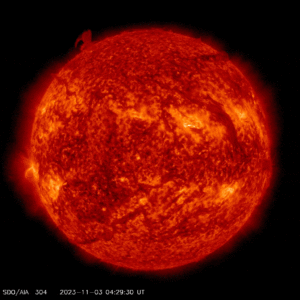 Filament eruption today – click image for animation.
Filament eruption today – click image for animation.
Solar activity is expected to be low, with a chance for M-class flares through at least 5 November.
November 2, 2023
The Sun is back on the upswing as far as sunspot numbers and activity are concerned. This morning, I observed eight spotted active regions, four in the northern hemisphere, and four in the southern. Seven of these are numbered and only two have areas greater than 100 millionths of a solar hemisphere (MSH). Six regions are quite small, but two are larger: AR 13474 (430 MSH, the largest currently visible) and 13477 (160 MSH).
Activity reached moderate levels when an M1 flare erupted at 12:26 UT yesterday from near AR 13477; this activity likely came from another region still out of view (and it has not yet revealed itself today). Parts of AR 13474 show some decay and the rest of the spotted regions appeared stable or in slow decay since yesterday with the exception of AR 13479, which emerged yesterday and grew a bit today. Today, AR 13474 was the source of most activity: a C3.9/SF at 1:58 UT, a C2.2/SF at 12:11 UT, and an impulsive M1.6/SB at 12:22 UT today. Prior to this event, four more C-class events (the largest was a C6.4 at 6:25 UT) were recorded but the present activity report does not associate a specific region with these. After the M1 flare there were no further flares, until about 19:15 UT.
An M1.0 flare occurred at 19:21 UT this afternoon, but a GONG H-alpha full disk image does not show an obvious source for the flare. There had been some east and east-southeast limb activity all day which may be from another active region that is about to rotate into view. This active region may be the source of this flare and the four C-class events mentioned above.
The first column of the table below show the red continuum images, taken at the times indicated, each a 0.25 second exposure. The second column shows the H-alpha images of each region, each a 0.5 second exposure. Each of the four images covers 18.0’x13.8′ on the sky (except the continuum image of AR 13477 and 13478, which is 13.8’x13.8′) and is oriented with celestial north up, west right.
Solar activity is expected to remain low, with a chance for M-class flares through at least 4 November.
November 1, 2023
Solar activity reached moderate levels as the first M-class flare in quite some time erupted from near AR 13477. This was an M1.1 that peaked at 6:26 UT today. Another flare, an M1.4, occurred at 12:26 UT, but the source was not provided in the event report as of midday today. It may have also come from the vicinity of AR 13477. The second event was a long duration event that took over 4 hours to subside to prior X-ray levels. AR 13474 has changed little in size and coverage since yesterday. It was the source of a C5 flare yesterday at 21:58 UT. AR’s 13472 and 13473 underwent some decay- their spots appear smaller and more scattered.
Yesterday, we observed a rather dark filament, a 25 degree long feature that was centered near S38 E 25 on the Sun. It began to erupt at 19:18 UT, during our observing session yesterday. One can see the changes over 35 minutes, with the feature (lower left part of image) bowing more sharply in the second image versus the first. This later produced a CME that is expected to miss Earth on November 5.
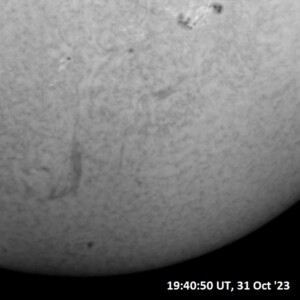 |
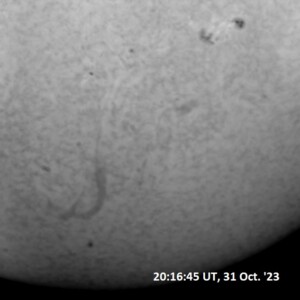 |
The first column of the table below show the red continuum images, taken at the times indicated, each a 0.25 second exposure. The second column shows the H-alpha images of each region, each a 0.5 second exposure. Each of the four images covers 18.0’x13.8′ on the sky and is oriented with celestial north up, west right.
Solar activity is expected to remain low, with a chance of isolated M-class flares primarily from AR 13474, through at least 3 November.
October 31, 2023
Observations resumed after some cloudy weather. The Sun continues to exhibit low activity but things are starting to pick up, as the frequency and intensity of C-class flares increases. They are not occurring continuously but in groups, with very low activity between. There were only a few low-level C-class events yesterday, but at 0:20 UT on 31 October, the largest event of yesterday and today erupted: a C5.7 which peaked at 0:20 UT. AR 13474, non existent before 29 October, grew, slowly at first, but rapidly over the last 36 hours or so, and has shown magnetic strength enhancement and spot consolidation. It is becoming more complex and may soon produce an M-class flare. AR 13473 grew some yesterday but stalled and remained stable through today; and AR 13472 was relatively stable. This afternoon, two new spot groups were noted: AR 13476, east of 13474; and 13477, which just rotated into view on the east limb. Both are shown in the images below.
The first image is a red continuum image of the four active regions near the center of the solar disk. It covers 13.8’x18.0′ on the solar surface. The second image, same size and zone, is in H-alpha. The third image shows the new region as it rotates into view. It covers 13.8’x13.8′ on the sky. Each of the three images is a 0.5 second exposure recorded at the time indicated on the image.
Solar activity is likely to remain low, with a chance of M-class flares primarily from AR 13474, through at least 2 November.
October 27, 2023
Observations were made under non-ideal conditions when the weather indicated it would clear but did not, so a few observations were made through cloud holes of varying sizes and clouds of varying thicknesses. The Sun continues to be very quiet with only five tiny sunspot groups (four of which are numbered) visible on the Sun. SWPC stated in its discussion October 25 that the previously indicated large active regions would not be appearing after all. So far this seems to be the case.
A filament erupted, breaking the string of low solar activity days. This was centered near N22 E80 on the Sun’s east northeast limb and it began around 22:29 UT on 26 October. This was near AR 13473. The event was a long-duration M1.4 flare that peaked at 23:24 UT on 26 October. A partial halo CME began erupting at 23:14 UT on 26 October. The CME will miss Earth. AR 13471 grew slightly then decayed, while all the other regions are in decay. This GONG image shows a nearly blank solar disk in continuum (white light) imaging.
Skies remained overcast for the rest of the day. Weather is expected to continue to be unfavorable through middle of next week. Next observations may happen on 1 November. may be the last observations made until at least 30 October.
Both images below are 0.5 second exposure and are trimmed to 13.8’x13.8′ with celestial north up, west right; they were recorded at the time indicated on the image. The left image is red continuum, the right is in H-alpha.
Solar activity is expected to be low to very low through at least 29 October. There is a slight chance of M-class flares on the 29th with the expected return of AR 13460.
October 24, 2023
The Sun continues an extended period of inactivity, with low solar activity over seven days and counting. Only periodic C-class events have been occurring from time to time, the largest of which over the last seven days was a C2.8 at 0:30 UT on 21 October. More recently, a C2.3 came from AR 13468 at 19:58 UT on 23 October. Only two numbered active regions remain, thought a third was still barely visible as a single spot or pore. Although AR 13471 has been downgraded to plage, two spots have appeared at its location. Several coronal mass ejections were observed yesterday. There are two large sunspot groups on the solar far side which may return by 26 October.
Weather has been unfavorable for observing this week and today’s expected sunny conditions became mostly cloudy during the session, hampering observations. Weather is expected to be worse the rest of the week so this may be the last observations made until at least 30 October.
Both images below are 0.5 second exposure and are trimmed to 13.8’x13.8′ with celestial north up, west right; they were recorded at the time indicated on the image. The left image is red continuum, the right is in H-alpha.
Solar activity is expected to be low, with isolated C-class flares. There may be a better chance for C-class flares on 26-27 October with the anticipated return of the above-mentioned active regions.
October 20, 2023
Solar activity continues to be low. The Sun is appearing almost blank as the above quick image (1/6000 second exposure through a Takahashi 5.1-inch with a Herschel wedge) shows. Only three numbered spotted regions remain visible on the Sun, but four additional groups, three of which were very small, have been noted during this morning’s sunspot counts. So a total of seven spotted groups are on the visible solar disk. The largest of the unnumbered groups, likely to be numbered AR 13469, produced yesterday’s largest solar flare, a C2.7 at 14:00 UT. Today, the low-level C-class flares continue but are either from this region or another undisclosed region.
One of the “new” spot groups seems to be AR 13467 (arrowed in the first continuum image below), which was classified as a plage region in today’s solar region summary. AR 13465 is decaying while 13464 and 13468 appear to be stable.
The first column of the table below show the red continuum images, taken at the times indicated, each a 0.1 second exposure. The second column shows the H-alpha images of each region, each a 0.5 second exposure. Each of the four images covers 18.0’x13.8′ on the sky and is oriented with celestial north up, west right.
Solar activity is expected to remain low, with more C-class flares likely, through at least 22 October.
October 19, 2023
Solar activity remains low. Only three spotted regions remain visible on the Sun with a fourth unnumbered region (near N25 E55) consisting of two tiny spots, yet to be numbered. This and the other regions appear to be stable or in decay. The X-ray background remained below C1.o level for 22.5 hours, but after 1:48 UT today, some low level C-class flares started happening with some regularity. Departing AR 13463, now spotless, was the source for two of these: a C1.4 at 9:52 UT and another C1.4 at 12:11 UT. The largest event since 16 October was a C2.7 at 14:00 UT today, from an unspecified location.
The first column of the table below show the red continuum images, taken at the times indicated, each a 0.1 second exposure. The second column shows the H-alpha images of each region, each a 0.5 second exposure. Each of the four images covers 13.8’x13.8′ on the sky and is oriented with celestial north up, west right.
Solar activity is expected to remain low, with more C-class flares likely, through at least 21 October.
October 18, 2023
After a double-peaked C-class event (or two events, first at 2:12 UT today, a C1.6; the second a C1.5 at 2:44 UT today), solar activity has dropped to very low levels. The background X-ray flux dropped below C1.0 level at 3:20 UT this morning and has remained in the B5 to B7 level all day, up until at least 22:00 UT. No information is available as to the source of the events.
There remains three spotted active regions on the sun today, with a fourth rotating into view. This is a pair of un-numbered spots near N27E70 on the solar disk. All of these regions are stable and inactive.
The red continuum image (left) is a 0.1 second exposure, while the H-alpha image (right) is a 0.5 second exposure. Each covers 13.8’x18.0′ on the Sun and are oriented with celestial north up, east left. Both cover the same region on the solar disk.
Solar activity is expected to be low, with a slight chance for an M-class flare through at least 20 October.
October 17, 2023
Solar activity remains low, with the largest event of the past few days being a C9.8 flare at 16:06 UTC on 16 October. This came from the northeast limb. AR’s 13463 and 13465 generated a few low-level C-class flares. The rest of the spotted regions on the visible solar disk were mainly small and stable. A CME rose from the SE limb at about 6:00 UTC on 17 October. This came from low-level C-class flares near AR 13464. The overall picture of the solar activity appears to be on the decline again, with existing active regions decaying, shrinking, and/or losing their spots. Nothing new or big seems to be imminent.
Each image is a 0.5 second exposure taken at the time indicated. They cover 13.8’x18.0′ on the Sun and are oriented with celestial north up, east left. The left image is a red continuum image; the right image is the H-alpha of the same area on the solar disk.
Solar activity is expected to be low, with a slight chance for an M-class flare through at least 19 October.
October 12, 2023
Observations resume after two days of cloudy and rainy weather. Solar activity rose to moderate levels when AR 13451 produced an M1.1 flare at 4:58 UT today as it rotated out of view. AR 13460 is decaying slightly as it approaches the western limb. It was the source of a C9.6 flare at 3:47 UT on 12 October. AR’s 13463, 13464, and AR 13466 each grew, with the last one growing rapidly before stopping its growth today. Everything else was quiet and stable. Since these events early on 12 October, there were few events through the rest of the day (UT), only low-level C-class and optical sub flares.
The first column of the table below show the red continuum images, taken at the times indicated. The second column shows the H-alpha images of each region. Each of the four images is a 0.5 second exposure, with the top row of images covering 13.8’x13.8′ on the sky and the bottom row covering 13.8’x18.0′ on the sky. Each is oriented with celestial north up, west right.
Solar activity is expected to be low with a chance for M-class events through at least 14 October.
October 9, 2023
Solar activity continues to be low with AR 13451 contributing the vast majority of the flaring activity yesterday and today. There was a C9.2/SF that peaked at 19:11 UT today from AR 13451, the largest since an M1.7 at 18:06 UT on 7 October. AR 13451 and 13460 have shown growth. The remaining seven spotted visible active regions are unremarkable: either stable or in decay.
The first column of the table below show the red continuum images, taken at the times indicated. The second column shows the H-alpha images of each region. Each of the four images is a 0.5 second exposure, covers 13.8’x13.8′ on the sky (unless otherwise indicated), and is oriented with celestial north up, west right.
Solar activity is expected to be low with a chance for M-class events through at least 11 October.
October 6, 2023
Solar activity continues at low levels. AR 13451 and 13452, the two most prominent on the Sun’s disk currently, showed some growth and produced almost all of the flares over the past two days, through today. AR 13454 also produced a flare, a C4/SN at 21:15 UT on 5 October. There were a total of ten spotted regions observed on the sun this morning, most of which were small and either stable or in decay.
Each image is a 0.5 second exposure taken at the time indicated. They cover 13.8’x18.0′ on the Sun and are oriented with celestial north up, east left. The left image is a red continuum image; the right image is the H-alpha of the same area on the solar disk.
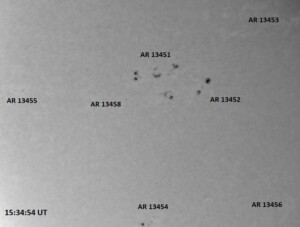 |
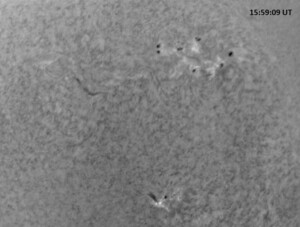 |
Solar activity is expected to be low, with a chance for isolated M-class activity through at least 8 October.
October 2, 2023
The Sun had been quiet for the most part, with the occasional M-class flare since the last observing session. There was an M1.2 at 16:35 UT on 30 September, then an M2.5 on 1 October. Activity remained quiet until an M1.9 flare from AR 13155 at 12:46 UT, which returned activity to moderate levels. Since then, through 22:15 UT today, there had only been a couple of minor C-class flares (both observed during this morning’s session): a C2.4 at 15:58 UT from AR 13450, and a C2.0 at 16:35 UT from AR 13453. The most complex regions currently visible are AR 13450 and 13452. The remaining regions were either stable or in gradual decay. AR 13155 was numbered just this morning but appeared rather unremarkable. Nonetheless it was the source of today’s only M-class flare so far.
The top image is a red continuum image; the bottom is an H-alpha image, taken at the UT’s indicated. Each is a 0.5 second exposure and is oriented so that celestial north is up, east is right. Each covers 13.8’x18.0′ on the sky.
Solar activity is expected to be low with a chance for M-class flares through at least 4 October.
September 29, 2023
Solar activity returned to low levels. There were C-class flares from AR 13445 and 13450, but the latter was responsible for the majority of the activity. AR 13450 is growing and becoming more complex magnetically. AR’s 13435, 13445 and 13447 all are in decay as they prepare to rotate out of view. The rest of the active regions were unremarkable.
The Sun was quiet in X-rays for much of the day, but unspecified sources produced two C-flares: a C7.5 at 18:24 UT and a C5.0 at 20:08 UT. As of this writing (21:10 UT), no source information is available.
The first column of the table below show the red continuum images, taken at the times indicated. The second column shows the H-alpha images of each region. Each of the four images is a 0.5 second exposure, covers 13.8’x13.8′ on the sky (unless indicated otherwise), and is oriented with celestial north up, west right.
Solar activity is expected to be low with a chance for M-class flares through at least 1 October.
September 28, 2023
New AR 13450 produced an M1 flare at 9:07 UT today, the first of such events in several days. AR 13435 continues to decay as it is about to rotate out of view. AR 13445 also underwent decay with fewer and fewer spots visible in this complex. However, AR 13449 continues to grow and evolve as it develops more complexity. But simple-looking AR 13450, which just rotated into view a few days ago, is the region with the most powerful flare so far today (up through 23:30 UT). Overall, the number and size of the sunspots and sunspot groups on the Sun is getting smaller as the sun continues its trend of becoming more and more quiet as of late.
The first column of the table below show the red continuum images, taken at the times indicated. The second column shows the H-alpha images of each region. Each of the four images is a 0.5 second exposure, covers 13.8’x13.8′ on the sky (unless indicated otherwise), and is oriented with celestial north up, west right.
Solar activity is expected to be low with a chance of isolated M-class flares through at least 30 September (these are primarily due to ARs 13435 and 13445).
September 27, 2023
The Sun continues at low activity levels as AR 13435 maintains a rather complex (“a weak delta signature”) magnetic configuration, but was otherwise quiet. It only produced a couple of optical subflares today. AR 13445 has also changed little and produced most of the C-class flare activity yesterday. AR 13449 is quickly developing and has produced most of the flare activity today, the most recent (as of 22:00 UT today) being a C3.5/SN event at 18:32 UT. This was the second largest so far today, the largest being a C4.6 event at 5:46 UT today from an unspecified region.
The number and complexity of the visible sunspot clusters seems to be on the decline again. Today I observed a total of seven groups, down from nine a day ago.
The first column of the table below show the red continuum images, taken at the times indicated. The second column shows the H-alpha images of each region. Each of the four images is a 0.5 second exposure, covers 13.8’x13.8′ on the sky, and is oriented with celestial north up, west right.
Solar activity is expected to be low with a chance of isolated M-class flares through at least 29 September (these are primarily due to ARs 13435 and 13445).
September 26, 2023
Since the M8.7 on the 21st, solar activity remained elevated with eight additional M-flares from the 22nd through the 24th; most were low level M-flares but one was an M4. Since midday on the 24th, no further M-flares were produced. Solar activity appears to be trending downward: since the M1 flare at 15:10 on 24 September, no additional M-flares have happened up to 23:45 UT today.
AR 13435 continued to be the most complex region on the Sun, magnetically speaking, and produced C-class flares yesterday and today, the largest of which was a C9.9 at 8:13 UT on 25 September. AR 13443 changed little over the last few days, but it is getting ready to rotate out of view. It was the source of some low-level C-class flares yesterday, but none today through at least 23:20 today (I currently have no information who produced the C2.2 at 23:30 today). A filament near the northwestern limb of the Sun erupted yesterday around 15:20 UT. This was followed by a surge and some ejecta erupting from AR 13435 that occurred with a C-class flare at 19:01 UT yesterday. We did not observe all this excitement yesterday due to inclement weather.
The first column of the table below show the red continuum images, taken at the times indicated. The second column shows the H-alpha images of each region. Each of the four images is a 0.5 second exposure, covers 13.8’x13.8′ on the sky, and is oriented with celestial north up, west right.
Solar activity is expected to be low with a chance of isolated M-class flares through at least 28 September (these are primarily due to AR’s 13435 and 13445).
September 21, 2023
Solar activity reached high levels again today. AR 13435 again produced an M8.7 flare, this time several hours before our session. It peaked at 12:54 UT. It produced a C2.5 some 2.5 hours earlier, at 10:20 UT. Other regions produced C-class flares today: A c2.2 from AR 13442 at 1:43 UT, a C1.6 from AR 13438 at 5:57 UT, a C2.1 (peaked at 9:46 UT) and C3.2 (peaked at 16:07 UT) from AR 13443. Yesterday’s M8 event generated a CME which was first seen via SOHO/LASCO C2 imagery at 15:05 UT on 20 September. I haven’t seen much of a CME from today’s event in SOHO imagery but it may emerge soon. AR 13435, 13441 and 13443 (the emerging flux arrowed in yesterday’s imagery) have shown some significant growth over the last 24 hours. The other 8 spotted active regions remain stable and unremarkable.
After the M-flare this morning, the X-ray flux stayed in the low C-range, except for the above mentioned flare events. The SOHO X-ray flux plot went offline at 19:28 UT today then cam back online at 21:11 UT.
The first column of the table below show the red continuum images, taken at the times indicated. The second column shows the H-alpha images of each region. Each of the four images is a 0.5 second exposure, covers 13.8’x18.0′ on the sky (except where indicated otherwise), and is oriented with celestial north up, west right.
Solar activity is likely to be at moderate levels through at least 22 September. There is a slight chance for an X-flare from AR 13435.
September 20, 2023
Solar activity reached high levels today. During the opening red continuum imaging sequence of today’s observing session, AR 13435 produced an M8.2 which peaked at 14:19 UT. When it was noticed that this event was underway, we slewed to the region and activated the H-alpha filter, which takes around 10 minutes to warm up to on band. The flare did not become visible within the images until the filter was about 0.5 angstroms short of center band. By the time it was onband, the flare had decayed to an M3 and dropped rapidly. Since then (through 22:00 UT, 20 September) only two significant C-class events have taken place: a C4.2 at 18:02 UT and a C5.5 at 18:40 UT. Add to this a C4.7 at 21:38 UT. The first came from AR 13442 and the most recent appears to have come from the same region (based on GONG imagery from 21:45 UT). No information is yet available on the sources of the C5.5 event.
Prior to this activity had reached moderate levels with an M4 from AR 13435 at 20:14 UT on 19 September. A little over two hours later, this region produced a C9.7 flare at 22:37 UT. A CME from the first event was seen starting at 20:36 UT via SOHO. All the other eleven numbered and unnumbered regions were quiet today.
The first column of the table below show the red continuum images, taken at the times indicated. The second column shows the H-alpha images of each region. Each of the four images is a 0.5 second exposure, covers 13.8’x18.0′ on the sky, and is oriented with celestial north up, west right.
Solar activity is expected to be at low levels, with a chance for an M-class flare through at least 22 September.
September 19, 2023
Problems with a cable connecting the mount to the camera canceled yesterday’s observing session. With a replacement cable in place, we resume observations this morning. Since the last observation session, solar activity had increased to moderate levels with three M-class flares closely spaced in time from 22:10 UT on 15 September to 5:50 UT on 16 September, all from AR 13429. Then activity dropped back to low levels with only occasional C-class flares happening from 6:00 UT 16 September to 3:00 UT on 19 September. Then two M1 flares occurred from AR 13435: an M1.1/SF at 3:55 UT today, then an M1.8 flare at 9:38 UT today. Since then, only a handful of C-class events happened today, followed by an M4.0 at 20:14 UT, which came from AR 13435.
AR 13436 has grown in size and spot number, but remains simple in magnetic structure. AR 13438 was numbered as its own group; it was originally thought to be part of AR 13435. Today, there are 10 spotted groups on the Sun, seven in the northern hemisphere and three in the southern hemisphere. The largest of these is AR 13435, with an area of 280 millionths of a solar hemisphere.
The first column of the table below show the red continuum images, taken at the times indicated. The second column shows the H-alpha images of each region. Each of the four images is a 0.5 second exposure, covers 13.8’x13.8′ on the sky, and is oriented with celestial north up, west right.
Solar activity is expected to be at low levels, with a chance for an M-class flare through at least 21 September.
September 15, 2023
Unsettled weather has limited observations these last three days, with only one image obtained yesterday. Today there was a long enough break in the weather to allow for a full sequence of continuum and H-alpha imaging. Solar activity was low for the full day of 13 September, with only occasional C-class flare activity. The activity increased to moderate with three M-class flares: an M1.4 at7:40 UT and a pair of M flares from AR 13429 (M1.9/SN at 19:34 UT and M 2.5/SN at 20:26 UT. We attempted observation right between these two, but equipment problems, weather, and other issues prevented us from continuing. AR 13429 was the source for most of the C-class activity yesterday and all of the activity (through 19:15 UT) today. Solar activity has returned to low levels today.
AR 13423 continues to be the largest on the list of active regions, even though it is rotating out of view presently. It has an arear of 260 MSH. AR 13433 is a large, simple spot with the second largest area at 90 MSH; AR 13429 is third with 80 MSH. Altogether there are six spotted regions on the visible solar disk, but most are unremarkable. AR 13429 showed some slight growth early yesterday but decayed some later yesterday; today the sunspot group looks quite simple and quiet, hence no more M-flares.
AR’s 13425 and 13423 produced the bulk of today’s activity: C-class flares and the aforementioned M-class flares. As of 23:15 UT (12 Sept.) there had been no further M-class flares; the last one was at 7:07 UT this morning.
Each of the four images is a 0.5 second exposure, with celestial north up, west right. All are red continuum images except for the last, which is in H-alpha light.
Solar activity is expected to be at low levels, with a chance for an M-class flare through at least 17 September.
September 12, 2023
The Sun remained at moderate activity levels, meaning there were more M-class flares. AR 13431 grew a bit in size and magnetic complexity and was the source of an M1 flare at 14:49 UT yesterday, the 11th. AR 13425 also produced an M1 flare and many C-class flares. AR 13423 continues to be the largest region on the visible solar disk and produced an M2/2N flare at 7:07 UT this morning, 12 July. A filament erupted in the south central region of the solar disk around 14:00 UT yesterday, September 11, and this produced a faint coronal mass ejection. More CME’s were produced on the far side of the Sun.
AR’s 13425 and 13423 produced the bulk of today’s activity: C-class flares and the aforementioned M-class flares. As of 23:15 UT (12 Sept.) there had been no further M-class flares; the last one was at 7:07 UT this morning.
The first column of the table below show the red continuum images, taken at the times indicated. The second column shows the H-alpha images of each region. The first row of images cover 13.8’x18.0′ on the sky; the size of the others are indicated below each image. Each of the four images is a 0.5 second exposure, with celestial north up, west right.
Solar activity is likely to continue at moderate levels with M-class flare activity fairly likely and a chance for an X-class flare through 14 September.
September 11, 2023
Moderate solar activity has returned as M-class flares have been happening with some regularity since the last observing session. AR 13429 and 13431 both produced M1 flares at 1:28 and 4:07 UT today, respectively. AR 13431 then produced an M1.1/SN flare just before this morning’s session. The flare peaked at 14:49 UT. AR 13425 produced a C5.5/SN with dark surges just after the observing session; this one peaked at 17:35 UT. Other notables include three high-level C-flares from AR 13431 (which immediately followed its M1 event): C7.1 at 5:42 UT, C9.3 at 6:01 UT, and C6.8 at 6:17 UT. AR 13423 produced a C7.4 at 10:37 UT today from AR 13423; and AR 13425 produced a C8.2 event at 21:!4 UT.
The rest of the visible spotted active regions were either stable or in decay. In the diagram caption below, the units MSH mean “Millionths of a Solar Hemisphere”, which is how the sizes of sunspots are recorded.
The image on the left is a 13.8’x13.8′ image in red continuum light. The image on the right is a 13.8’x15.1′ H-alpha image of the same region. Both images are 0.5 second exposures and are oriented so that celestial north is up, west is right.
Solar activity is expected to be low, with a chance for M-class flares, through at least 13 September.
September 8, 2023
Solar activity is now low after reaching moderate levels yesterday with the M2/1B flare from AR 13425 at 19:03 UT on 7 September. Since then there had been little more than low-level C-class flares, mostly from AR 13425. AR 13421 showed decay and was mostly inactive; it did produce a couple of optical sub-flares today. There has been no additional M-class activity since yesterday’s event up until this writing (21:15 UT). The remaining regions on the Sun were quiet and unremarkable.
The first column of the table below show the red continuum images, taken at the times indicated. The second column shows the H-alpha images of each region. Each image covers 13.8’x13.8′ on the sky and is a 0.5 second exposure, with celestial north up, west right.
Solar activity is expected to be low, with a chance for isolated M-class flares, through at least 10 September.
September 7, 2023
The Sun has quieted down again, with only (mostly) low-level C-class flare events. AR 13421 produced a C5.3/SF yesterday at 17:56 UTC, and that was the strongest event until AR 13425 produced an M2.1/1B event that peaked at 19:09 UT. AR’s 13423 and 13425 had produced C-class activity yesterday and today. A C1.3/SF was observed today in AR 13422 during the morning session. The flare took on the shape of a parallel ribbon and a fan-shaped surge of dark material was produced west of the main region. All of the other visible regions on the Sun were unremarkable.
The first column of the table below show the red continuum images, taken at the times indicated. The second column shows the H-alpha images of each region. The first row images cover 13.8’x18.0′ on the sky; the second row images cover 13.8’x13.8′ on the sky. Each image is a 0.5 second exposure, with celestial north up, west right.
Solar activity is expected to be low, with a chance for isolated M-class flares, through at least 9 September.
September 6, 2023
The regions observed last week have either rotated out of view, dissipated, or nearly dissipated. A new batch of regions have emerged and rotated into view, including the currently most-active region AR 13421. Four of the five M-class flares that have happened since the last PVO observing session have come from AR 13421. AR 13413 produced an M5 flare at 8:36 UT on 3 September. This region produced an M1.2 flare yesterday at 19:45 UT, followed by an M1.0 at 23:35 UT. Today has only seen C-class activity, all but one of which was from AR 13421 (the one not produced by this region was from AR 13417). There are eight spotted regions on the visible solar disk, most of which are quiet and stable.
Technical issues resulted in changing cameras for today’s observations. We are back to the SBIG STF-8300, which has a larger field of view. The first column of the table below show the red continuum images, taken at the times indicated. The second column shows the H-alpha images of each region. The first row images cover 13.8’x18.0′ on the sky; the second row images cover 13.8’x13.8′ on the sky.. Each image is a 0.5 second exposure, with celestial north up, west right.
Solar activity is expected to be low, with a chance for isolated M-class flares, through at least 8 September.
September 1, 2023
A long-duration M1.2 flare from AR 13413, which peaked at 3:51 UT on 1 September, breaks the long interval of low solar activity. This was preceded by a C1.1 at 2:15 UT. Afterwards, the X-ray level decreased below C level at 8:12 UT and has not breached this level since until 20:27 when an undetermined source produced a low-level C-1 event. There was also B9.9 that occurred at 15:14 UT, but other than this, and a couple of SF’s with and after the M-flare, solar activity has been very low. Only five small spotted regions are visible on the solar disk currently, and the two largest are about to rotate out of view.
A C7.4 flare occurred at 22:24 UT (today, 1 September) from an undesignated area near S21E50, and this appears to be a new active region emerging.
The first column of the table below show the red continuum images, taken at the times indicated. The second column shows the H-alpha images of each region. All the images are 7.8’x7.8′ in size. Each image is a 0.5 second exposure, with celestial north up, west right.
Solar activity is expected to be low through at least 3 September. AR 13413 is expected to be the source of most flare activity until it rotates beyond the limb after 3 September; C-class flares are expected through tomorrow with a chance for an isolated M-class flare. C-class flares remain likely on 3 September, with a slight chance of M-class flaring.
August 31, 2023
The Sun continues its stretch of low activity with relatively small numbers and sizes of sunspots on its visible disk. Only occasional C-class flares have occurred. AR 13413 has changed its shape as it reconfigures its spot configuration. AR 13415 is showing decay, and all the other regions are quiescent, inactive, and generally unremarkable.
The first column of the table below show the red continuum images, taken at the times indicated. The second column shows the H-alpha images of each region. All the images are 7.8’x7.8′ in size. Each image is a 0.5 second exposure, with celestial north up, west right.
Solar activity is expected to be low through at least 2 September. There is a slight chance for M-class flares, from regions 13413, 13415, and 13417, but continued C-class flares are likely.
August 30, 2023
Solar activity remains low with very little activity. There was a C2.8 at 16:42 UT (just after today’s session) from AR 13415. AR 13417 produced a C1.7 at 4:19 UT but has been otherwise quiet. AR 13413 produced a C1.5/SF at 17:46 UT. AR’s 13413, 13415, and 13417 are the three largest regions currently visible but have changed little over the last 24 hours.
The first column of the table below show the red continuum images, taken at the times indicated. The second column shows the H-alpha images of each region. All the images are 11.4’x7.8′ except where indicated otherwise. Each image is a 0.5 second exposure, with celestial north up, west right.
Solar activity is expected to be low through at least 1 September. There is a slight chance for M-class flares, from regions 13413, 13415, and 13417.
August 29, 2023
The Sun has moved into low activity mode, with a lull in activity since the early part of August. Since 10 August, there had not been any X-class flare, but only three M1 flares: 23:04 on 22 August featured an M1.1 from AR 13415 as it started to rotate into view; an M1.4 at 1:09 UT on 25 August from AR 13415; and a long-duration M1.1 at 22:50 on 26 August. This latest event came off the Sun’s eastern limb but a source was not identified. Two days later, AR 13417 makes its appearance on the eastern limb, near the location where this flare erupted. Since then, only occasional low-level C-class flares have occurred. Today, two came from AR 13413 and a third from 13417. The largest so far today (up till 19:47 UT) was a C1.6/SF from AR 13413 at 4:21 UT today.
The first column of the table below show the red continuum images, taken at the times indicated. The second column shows the H-alpha images of each region. The first row’s images each cover 7.8’x7.8′ on the sky; the second row’s images cover 11.4’x7.8′ on the sky. Each image is a 0.5 second exposure, with celestial north up, west right.
Solar activity is expected to be low through at least 31 August. There is a slight chance for M-class flares, from regions 13413, 13415, and 13417.
August 10, 2023
The Sun has moved into low levels of activity with only C-class flares all day yesterday and today through 20:20 UT. The overall trend of the solar disk is toward spotlessness, with small regions dissipating and others getting smaller. ARs 13394 and 13395 are exceptions to this trend, as each have shown slight growth and are the two largest spot groups on the visible disk. Aside from “two notable CMEs”, the Sun was quiet. One of these CME’s was a farside event; the other came off the SW edge of the Sun from a C5 flare that came from AR 13398.
The first column of the table below show the red continuum images, taken at the times indicated. The second column shows the H-alpha images of each region. Each image is a 0.5 second exposure, with celestial north up, west right, and each image covers 7.8’x7.8′ on the sky.
Solar activity is likely to be low through at least 12 August. There is a chance for M-class flares, especially on 10 August, with AR 13387 just over the western limb.
August 9, 2023
The Sun returned to low levels of activity after the M3 flare yesterday in the predawn hours local time. Since then, AR 13394 produced a C8.7 flare at 18:10 UT on 8 August, which is the largest flare to happen up to the present time (21:35 UT, 9 August). AR 13387 rotated over the west limb, while AR 13394 developed a few more spots as it showed some slight growth. AR 13395 also grew slightly since yesterday, but remained mostly inactive. There are a total of eight visible spotted groups, each of which is small to very small and inactive.
The first column of the table below show the red continuum images, taken at the times indicated. The second column shows the H-alpha images of select regions. Each of the five solar images is a 0.5 second exposure, with celestial north up, west right, and each image covers 7.8’x7.8′ on the sky. The Venus image is cropped to approximately 2’x2′ and is a 0.1 second exposure with the red ERF stopping the aperture to 4.875″.
Solar activity is expected to be low overall, but with M-class flares likely through 10 August and a chance of M-class flares on 11 August.
August 8, 2023
Solar activity remains at high levels because of yesterday’s X1.5 flare from AR 13386, now hidden from direct view. No further events were observed to come from this region after the X1.5 as it rotated further out of view (as of 18:35 UT 8 August). AR 13387 and 13394 were the most active regions today, with AR 13394 producing an M3.6/SF at 9:31 UT today, and a C8.7/SF at 18:10 UT today. AR 13387 produced a couple C-class flares to start today, followed by several sub flares. It was the source of two M-class flares yesterday. This region is slowly growing as it moves closer to the western limb of the Sun. AR 13398 emerged near the west limb and has shown some growth. The remaining of a total of 10 spotted regions were small and quiet. The Sun’s spotted regions have become smaller and quieter over all in recent days.
The first column of the table below show the red continuum images, taken at the times indicated. The second column shows the H-alpha images of each region. Each image is a 0.5 second exposure, with celestial north up, west right, and each image covers 7.8’x7.8′ on the sky.
M-class flares were likely today with a slight chance of an X-class flare through 9 August. This decreases to only a chance for M-class flares by 10 August as AR 13387 rotates over the western limb.
August 7, 2023
Since last week, the number and size of sunspots has decreased markedly. Yet in recent days, solar activity had remained high, especially starting late on 5 August. At 22:22 UT, AR 13386, as it was about to depart, produced an X1.6 flare, Then it produced an M5.5/SN flare at 18:40 UT on 6 August. It also produced an M2.4 flare at 4:41 UT today, 7 August. Then later today (7 August) at 20:46 UT, it generated an X1.5 flare from over the limb. Since we were not observing at the time, we needed to look at GONG imagery to watch the flare loops rise above the western solar horizon. This event has decayed into the high M-range as of this writing (21:22 UT). The region also produced many C-class flares from on and just beyond the west limb, and it was the source of some interesting activity earlier this morning (the sequence is pictured below).
The highlight images immediately below display four active regions. The first column of the table below show the red continuum images, taken at the times indicated. The second column shows the H-alpha images of each region. Each image is a 0.5 second exposure, with celestial north up, west right. The top row of images cover 11.4’x7.8′; the bottom row covers 7.8’x7.8′ on the sky.
During a 50 minute sequence (from 15:47 UT to 16:37 UT) much change was seen on the solar western horizon. During this time a fairly long duration M1.1/SF occurred in AR 13387 (lower left of image center in each of the following images). The flare began at 15:30, peaked at 16:27, and ended at 16:36. Note also the strange shaped prominence over AR 13386’s location and how this changes and begins to fade away throughout the sequence. Each image covers 5.3’x3.9′, centered on the activity, with celestial north left and celestial west up. Each is a 0.5 second H-alpha exposure obtained at the indicated time on the image.
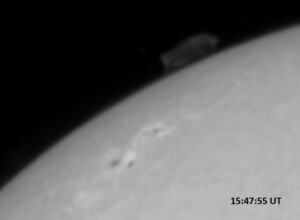 |
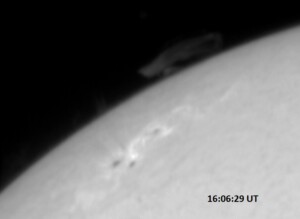 |
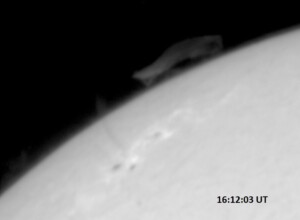 |
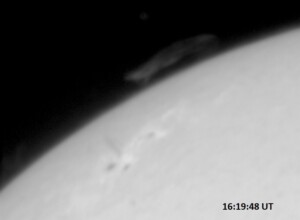 |
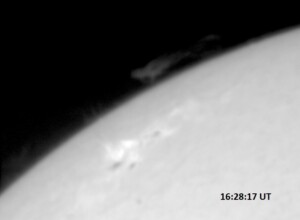 |
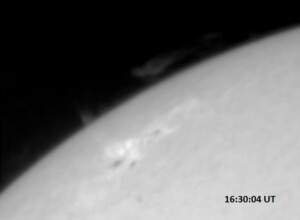 |
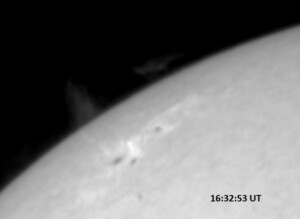 |
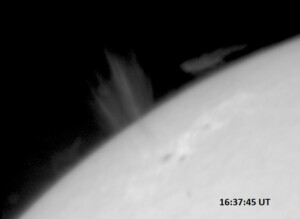 |
M-class flares were likely today with a slight chance of an X-class flare today. This decreases to only a chance for M-class flares from 8 to 9 August as AR 13386 rotates further over the limb.
August 1, 2023
Observations resume as solar activity once again increases. The sun’s activity had been moderate to high, high in recent days due to frequent M-class flaring from AR 13380. The largest of these was an M3 that peaked at 6:57 UT this morning and has grown significantly as it approaches the western limb. AR 13386 produced a few C-class flares and has shown some slight development. AR 13384 showed some redevelopment from new spots emerging, and a new AR, 13393, emerged but was quiet so far. The rest of the active regions present on the Sun were inactive; there are a total of 11 spotted active regions on the visible disk.
Each image below covers approximately 7’x7′, except for the middle two, which cover approximately 9’x6′ on the Sun. The images were acquired with the camera and telescope aligned to celestial coordinates; the images were later aligned to solar coordinates and trimmed; solar north is up, west is right in each image. Each is a 0.5 second exposure, with the red continuum images in the left column; the H-alpha line center images are in the right column.
Solar activity is expected to be low overall, but there is a likelihood of M-class flare through at least 3 August.
July 20, 2023
With the departure of AR 13363, solar activity has returned to low levels. Since yesterday’s M3 flare with the interesting limb phenomena, there had not been anything greater than a C3-except for a C9.7 that happened at 19:49 UT from AR 13373. The trio of sunspot groups we have been watching have been mostly quiet. AR 13373 had periods of decay and growth, AR 13376 had some growth, while AR 13372 did not experience any notable activity and remained largely unchanged. This was the same for the other visible spot groups on the Sun.
A “C” shaped filament that we have been watching all week straightened out from “C” shape to boomerang shaped. Then between 22:40 and 2:55 UTC, this approximately 15 degree long filament was seen erupting from the Sun’s surface. No trace of it was visible today on the Sun.
AR 13373 contributed nearly all of the (fewer in number compared to past days) events. There was an SF that peaked at 15:48 UT: the white light/continuum image below shows some signs of this event even in continuum Compare this first image with the two red images just below it. These are 304-Angstrom He-II images from SDO that show what is likely the same phenomena (arrowed). This is not the first time we have imaged dark surges from flares in the red continuum.
Except for the two images colored red below, each of the below images is a 0.5 second exposure, taken at the time indicated on the image. Each image cover 11.4’x7.8′ on the sky and is oriented so that solar north is up, west is right. The first column includes red continuum images; the second column features white light/red continuum images. The red images are 304-Angstrom extreme ultraviolet images, taken by the Solar Dynamics Observatory (SDO). The arrowed feature, which shows bright in these images, corresponds with the dark feature at the bottom center edge of the first image.
Solar activity is expected to be low, with a chance for M-class flares, through at least 22 July. There is a slight chance of an X-class flare through 21 July.
July 19, 2023
Solar activity continued to be moderate due to an M2/1 flare late yesterday from AR 13376. This produced a CME, part of which is likely to interact with Earth. AR 13363 produced an M1.4 flare as it rotated over the limb. AR 13372 continued to remain stable as parts strengthen and other parts weaken, AR 13373 experience similar change but added more spots in the leader (front) section. All the other regions visible on the Sun were inactive, little changed, or decayed slightly.
Even as it departed, AR 13363 contributed most of the activity today, from 0h UT through 20:45 UT. AR 13372 produced a single C-class flare, a C2.4/SF. AR 13363 produced an M1.4/SF at 10:57 UT, and an M3.8 at 17:25UT. We observed this one, starting two minutes before the X-ray peak when a flare arcade appeared above the solar horizon. For the next 90 minutes we documented the evolution of this arcade system (one example image is displayed immediately below, west is up, north is left in this 3.9’x3.9′ image, taken at the time indicated).
Each of the below images is a 0.5 second exposure, taken at the time indicated on the image. Each image cover 11.4’x7.8′ on the sky and is oriented so that solar north is up, west is right. The first column includes red continuum images; the second column features white light/red continuum images.
Today, solar activity was forecast to be moderate, with M-class flares likely and a slight chance of X-class flares. Solar activity is forecast to be low from 20 to 21 July, with a chance of M-class flares and a slight chance of X-class flares..
July 18, 2023
Solar activity remained low for much of yesterday until 22:00 UT, when a series of increasingly strong flares occurred: A c5.9 at 22:10, a C6.3 at 22:34, an M2.7 at 22:54 UT, then culminating with an M5, initially peaking at 23:32 UT. This started a long duration event that peaked higher, at M5.7 at 0:08 UT. The source region for the M-class flares was departing AR 13363. The M flare lasted for several hours, staying above the M1 level until 3:08 UT. Such a long event releases much more energy than a typical X1 flare as can be seen in the images below (source: spaceweather.com). The first is an animation showing the initial flaring event as seen in the extreme ultraviolet wavelengths. The second is a visible light animation of the CME (Coronal Mass Ejection) from the SOHO satellite. Click the image for animation.
The CME was first observed at 23:43 (17 July) and expanded from there. An additional M1.5 flare occurred at 6:56 UT from growing AR 13376. This region also produced a C8.3 just before, at 6:10 UT. AR 13372 was the source of a C6.6/SF art 15:16 UT on 17 July. AR 13372 stayed roughly the same, while AR 13373 and 13376 grew in size and complexity. Periodic C-class flares occurred today from Regions 13372, 13373, and 13376. A double-peaked C-class flare was observed during the morning’s session. It came from AR 13372 and peaked at C5.0 at 17:29 UT and C3.9 at 17:32UT. As the optical component faded, a dark surge emanated from the bright region, spreading toward the north and east before fading a few minutes later.
Then, after the scheduled session was over, AR 13376 produced a rather long duration M1.3 flare that peaked at 19:47 UT. This may have stimulated another, smaller flare at AR 13372 that peaked at20:05 UT, the X-ray profile superimposed on the first M-class flare. The 13372 event faded quickly but the 13376 event, covering more optical area, started to fade a bit initially but began a resurgence. This led to yet another M-class flare, an M2.1 at 20:27 UT. The flare is now subsiding as of 20:42 UT.
Each of the below images is a 0.5 second exposure, taken at the time indicated on the image. The first row of images cover 7.8’x7.8′ on the sky, while the second row of images each cover 11.4’x7.8′ on the sky. All four are oriented so that solar north is up, west is right. The first column includes red continuum images; the second column features white light/red continuum images.
Solar activity is expected to be low, with a chance for M-class flares and a slight chance for X-class flares as solar activity trends lower. This is expected through at least 20 July.
July 17, 2023
Solar activity was moderate over the weekend with a few M-class flares on the 15th and 16th. The background X-ray flux remained at C-levels. There are 8 spotted active regions on the Sun currently, with five of these numbered as of early this morning. AR 13363 is starting to approach the western limb, carried along by the Sun’s rotation. It produced the largest flare of the weekend, an M4.0/2B flare at 17:46 UT on 16 July. The region also produced numerous C-class and optical sub-flares. AR 13372 produced an M1.7/1B flare at 15:08 UT on 16th of July. The region also produced many C-class and optical sub-flares. The other regions were largely stable, but AR 13373 has grown somewhat but remains relatively simple in terms of its magnetic fields. It produced many C-class flares. The many C-class and SF’s continued into this afternoon. A C2.5/SF was observed, starting just after its maximum at 17:33 UT, from AR 13373.
As of 19:55 UT on 17 July, there has not been another M-class flare since the M4.0 of yesterday.
Each of the below images is a 0.5 second exposure, taken at the time indicated on the image. Except for the second one, each covers 11.4’x7.8′ on the sky and is oriented so that solar north is up, west is right. The first column includes red continuum images; the second column features white light/red continuum images.
There is expected to be a gradual downward trend in solar activity level. It is expected to remain moderate today and tomorrow, with more C-class flares expected and M-class flares likely. There is a slight chance of an X-class flare also. Solar activity drops to low levels on 19 July as AR 13363 rotates out of view.
July 14, 2023
The Sun’s activity remains at moderate levels, with many C-class flare events and an M2/1N flare event at 19:20 UT on 13 July, all coming from AR 13372. AR 13363 remains largely unchanged and produced an M1/SF at 9:36 UT this morning, 14 July. Some more C-class flares came from just over the east-southeastern limb of the Sun. Limb activity was observed along the west northwest limb (primarily from AR 13361) and west-southwest limb (mainly from AR 13359). Currently there are nine spotted solar regions on the Sun’s visible disk, seven of which are numbered. Several more have rotated out of view.
Each of the below images cover 7.8’x7.8′ on the sky and is a 0.5 second exposure. The first column displays red continuum images of selected active regions; the second column are the same areas imaged H-alpha. Each was recorded at the time indicated on the image and oriented to approximately match the solar p.a., thus the orientation is that solar north is up, west is right in each image.
Moderate solar activity is expected to prevail through tomorrow (15 July) with M-class flares likely and a chance for X-class flares. By the 16rh of July, solar activity is expected to return to low, with a chance for M-class flares and a slight chance for X-class flares. Solar activity continues to be trending downward for the time being. AR’s 13372, 13363, and 13367 are expected to be the primary sources of such flares.
July 13, 2023
Since yesterday’s M6.9 flare, the Sun had experienced lower levels of activity with many C-class flares and optical sub-flares. AR 13372 produced frequent C-class flares today, including a C9.7/1F event at 12:44 UT this morning. The region produced a C4.7 at 16:52 UT during a flare watch and was documented as one of numerous optical subflares that the region has produced so far today. After the conclusion of today’s session, AR 13372 produced an M2.1 flare, the first M-flare since yesterday’s M6.9. The background X-ray flux remains at C-levels. AR 13361 has decayed in the trailing parts but grew in the intermediate parts, and AR 13367 is slowly weakening and decaying. Both are approaching the west limb, carried along by solar rotation. AR 13366 and the regions near it have rotated out of view but some limb activity from these has been documented. AR 13363 continues to grow a bit but remains inactive, as do the remaining five spot groups, each of which is little changed or experiencing minor decay.
Each of the below images cover 7.8’x7.8′ on the sky, unless indicated otherwise, and is a 0.5 second exposure. The first column displays red continuum images of selected active regions; the second column are the same areas imaged H-alpha. Each was recorded at the time indicated on the image and oriented to approximately match the solar p.a., thus the orientation is that solar north is up, west is right in each image.
Moderate solar activity is expected to prevail through tomorrow (14 July) with M-class flares likely and a chance for X-class flares. By 15 July, solar activity should be low, with a chance for M-class flares and a slight chance for X-class flares. Solar activity seems to be trending downward for the time being.
July 12, 2023
There has been considerable amounts of activity on the Sun recently, which included two M6 and one M5 flare, all occurring in a less-than-a 15 hour span.AR 13368 produced the M6.8/SF at 18:08 UT on 11 July, followed by an M5.8 flare from just over the northeastern limb of the Sun happened at 22:15 UT on 11 July. Then AR 13372 produced an M6.9/1N flare at 8:55 UT this morning, 12 July. This was the largest flare in at least 7 days. Since this large flare , there has only been many sub-flares and a few low-level C-class flares. No further M-class flares have occurred since through at least 22:15 UT (12 July). Five low-level M-class flares came from AR’s 13361 and 13366 in addition to these three larger flares. There was a near-M flare after the latest M6: a C9.1/SN from AR 13361 at 10:29 UT. This was the last flare this strong today (through 22:15 UT), with only the afore-mentioned small flares occurring since.
The first of the large M-class flares is depicted below in this gif animation of several SDO (Solar Dynamics Observatory) images. These were posted on Spaceweather.com on 11 July. This image is in the extreme ultraviolet and this radiation ionized the top of the Earth’s atmosphere, resulting in a short wave radio blackout over North America (click on the image for the animation). One frame becomes very speckly because the event saturated the detector.
A large, active filament that was just south and west of AR 13363 and the filament seen in today’s image erupted, beginning at about 18:30 UT on 11 July.
The images below depict most of the visible active regions on the Sun. The first column of the table includes red continuum images, the second column displays the H-alpha images. All eight images are 0.5 second exposures at the time printed on each image, . The first and last row of images cover 7.8’x7.8′ on the sky, while the second and third row of images span 11.4’x7.8′. Solar north is up, west right in each image.
Solar activity is likely to remain at moderate levels with M-class flares likely (mainly from AR 13372) and a slight chance of X-class flares, through at least 14 July.
July 11, 2023
Lots of flaring activity from lots of different active regions today as solar activity remains at moderate to high levels. AR 13366 produced an M1/1N flare at 22:18 UT on 10 July. AR 13372 just rotated into view and yesterday it produced a lot of C-class flares from just beyond the limb. Today it produced an M1.1. flare at 16:12 UT, which is imaged below in the 3.2’x2.6′ closeup of the region, taken at 16:12 UT. AR 13372 also produced an M2.0 at 14:35 UT this morning.
East is up, north is right in the above image.
Active regions 13360, 13361, 13367, 13368, and 13369 all showed slight decay; AR’s 13363 and 13366 showed some slight growth in at least part of each region. Then AR 13366 produced an M6.8/SF at 18:08 UT (after the day’s observing session ended).
Each of the below images cover 11.4’x7.8′ on the sky and is a 0.5 second exposure. The first column displays red continuum images of selected active regions; the second column are the same areas imaged H-alpha. Each was recorded at the time indicated on the image and oriented to approximately match the solar p.a., thus the orientation is that solar north is up, west is right in each image.
Solar activity is expected to be low with a chance for M-class flares and a slight chance for X-class flares through at least 13 July.
July 10, 2023
The Sun has been moderate in its activity level over the last week, with occasional M-class flares from various regions. The most receint is an M2.3/2N flare at 3:55 UT on 10 July from AR 13366, which was not expected to be a source region for such flares. AR 13361 was the region with the most complex magnetic field type currently visible on the solar disk; this region was expected (and still is) to be the source of larger flares going forward. However, it, along with AR’s 13359, 13363, 13366, 13367, and 13368, produced numerous C-class flares. Ten spotted active regions are currently visible on the Sun’s disk. Five of these are showing signs of growth, but AR 13366 is showing slight decay; the remainder of the spot groups is unchanged.
Each of the below images cover 11.4’x7.8′ on the sky and is a 0.5 second exposure. The first column displays red continuum images of selected active regions; the second column are the same areas imaged H-alpha. Each was recorded at the time indicated on the image and oriented to approximately match the solar p.a., thus the orientation is that solar north is up, west is right in each image.
Solar activity is expected to be low with a chance for M-class flares and a slight chance for X-class flares through at least 12 July.
June 30, 2023
After yesterday’s M3.8/2B flare, solar activity has returned to low levels, with only C-class and optical subflares occurring since. The largest since then, up to this writing (18:00 UT 30 June) was a C5.7/1F flare from AR 13354. This large region, almost 900 millionths of a solar hemisphere in areal coverage, is the only sizable spot group remaining on the visible solar disk. There are four other spotted regions, each of which is a single spot or two. AR 13354 is the only region to produce flares so far today, and they are all C-class events.
The images below are 0.5 second exposures, each covering 7.8’x7.8′ on the Sun’s disk. The first is AR 13354 in red continuum light; the second is the same region in the light of H-alpha. The times each were recorded are stamped on each image.
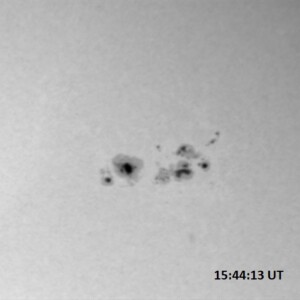 |
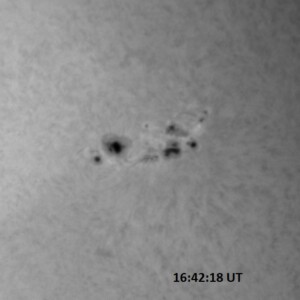 |
Solar activity is expected to be low, with a chance of M-class flares, and a slight chance of X-class flares, through at least 2 July.
June 29, 2023
Before the start of today’s session, when the early morning convective cumulus clouds (typical in this area for this time of year) were still abundant, AR 13354 generated an M3.8/2B flare that peaked at 14:15 UT, sending solar activity levels back to moderate levels. Prior to this, the active region was the source of many C-class flares. AR 13348 managed to produce a C2.8/SF today at 4:03 UT. AR 13340 has begun to rotate out of view over the solar northwestern horizon and has been fairly quiet. AR 13354 has stabilized some over the last day or so. Aside from these two, there are still five spotted active regions visible on the solar disk. All of these regions are small, quiet, and unremarkable.
Each of the below images is a 0.5 second exposure, taken at the time indicated on the image. Except for the second one, each covers 7.8’x7.8′ on the sky; the second image covers 11.4’x7.8′. The first column includes red continuum images; the second column features white light/red continuum images. Solar north is up, west is right in each image below.
Solar activity is expected to remain low, with a chance for M-class flares and a slight chance for X-class flares through at least 1 July.
June 28, 2023
The NOAA (National Oceanic and Atmospheric Administration) space weather forecasters gave a 40% probability of M-class flare activity and a 10% probability of an X-flare for today. So the extended observing session with AR 13354 being the main focus, since it has what they call a “beta-gamma-delta” magnetic configuration. This is a complex configuration that provides conditions favorable for larger flares to occur. (The typical solar active region has either an “alpha” or “beta” magnetic configuration, a simple dipole setup.) Solar activity was moderate with an M1/2B flare yesterday at 15:14 UT and an M1.9.2N flare today at 8:44 UT, both from the decaying AR 13340. This region produced most of yesterday’s flares. However, today the majority of activity has come from AR 13354, which produced lots of sub-flares and four C-class flares, one of which was observed during today’s session.
The surprise today was the C5.0/SF flare from AR 13348. We observed the above mentioned C5.4 event from AR 13354, which appeared optically as a bright kernel. This faded before another, much larger area appeared just north of the leader spot. This was thought to be a separate optical event but as of this writing (21:45 UT, and no additional M-class flares have happened since the 8:44 UT event), NOAA SWPC has counted this as a single optical event, beginning at 18:46 UT, peaking at 18:53 UT (two minutes before the second spot appeared) and ending at 19:04 UT. As the event was coming to an end, a dark surge appeared and then faded north of the flare location.
AR 13354 also produced C-class activity yesterday. It is visible to the unaided eye (with proper solar filter protection) and is the largest, most complex active region currently visible on the Sun. There are seven other numbered regions but most are much smaller than 13354. Each of the below images cover 7.8’x7.8′ on the sky and is a 0.5 second exposure. The first column of the first two rows are red continuum images of selected active regions; the rest of the images are in H-alpha. Each was recorded at the time indicated on the image and oriented to approximately match the solar p.a., thus the orientation is that solar north is up, west is right in each image.
Solar activity is expected to be low with a chance for M-class flares and a slight chance for X-class flares through at least 30 June.
June 27, 2023
The Sun maintained its moderate activity level with an M1.6 flare at 16:22 UT on 26 June (imaged below, in June 26 section). Another flare, an M1.2/SF, occurred today at 15:14 UT. Both events came from AR 13340, which also produced many C-class flares and optical subflares. AR 13354 grew quite dramatically over the last 30 hours or so. A few pores existed south of AR 13351 on the morning of 25 June, but a definite region was visible by the 26th of June. The images below show how AR 13354 changed from yesterday to today. The yellow strip is an animation from Spaceweather.com obtained from NASA’s Solar Dynamics Observatory. It spans 24 hours. This region produced some low-level C-class flares.
A single spot, AR 13355, rotated into view. It and the other spotted active regions (except for 13340) continue to be stable, quiet, and unremarkable.
The first set of images show the changes experienced by AR 14454 from yesterday to today. The PVSO (gray) images are each 0.5 second exposure.
This next set of images depict AR 13340 in continuum and three minutes after the X-ray peak of the M1 flare. Reports state an optical 2B flare peaked at 15:12 UT, and a second optical flare (an SF) peaked 15:21. We had recorded three images of AR 13340 prior to the 2B flare, the latest being 15:10 before moving to the next active region in the sequence. The flare appeared as bright plage at the time (it started at 14:53 UT). When we returned to AR 13340 at 15:17 UT, the flare was still bright. However, it faded considerably shortly after that. A secondary flare “kernel” was observed to appear in the central regions of the active region and this was the SF that peaked at 15:21UT.
Each of the PVSO images (above and below) cover 7.8’x11.4′ on the sky, were 0.5 second exposures, and are oriented so that solar north is up, west is right.
Solar activity is expected to be low with a chance for M-class flares through at least 29 June.
June 26, 2023
Solar activity remained on the low side since the last observing session, with many C-class flares and two M-class flares. One of these, an M1.1, happened at 12:17 UT on 24 June. The second of these, an M1.6/1N, came from AR 13340. This region also produced a C7/1F flare today at 4:02 UT. This region has grown and become more complex over the last few days. AR 13341 is decaying but did produce a C8.5/1N flare at 12:18 UT on 25 June. The many other regions on the Sun were either stable or in decay, with a number of them becoming spotless plages (five “H-alpha Plages, according to today’s Space Weather Prediction active region summary).
Each of the below images cover 7.8’x11.4′ on the sky, except where indicated otherwise, and is a 0.5 second exposure. The first column are red continuum images of selected active regions; the right column are corresponding images of each area in H-alpha. Each was recorded at the time indicated on the image and oriented to approximately match the solar p.a., thus the orientation is that solar north is up, west is right in each image.
Solar activity is expected to be low with a chance for M-class flares through at least 28 June.
June 23, 2023
AR 13341 produced an M4.8/SF at 23:44 UT yesterday, the 22nd. The flare took place centered south of a region along an erupting filament; this produced a globally propagating wave in the solar corona known as an EIT wave. This is named after the Extreme-ultraviolet Imaging Telescope instrument onboard the Solar and Heliospheric Observatory, which detects such types of waves from time to time associated with solar flare and other eruptive events. AR 13337 produced a C4.6/SF at 3:32 UT. All the other spotted regions remained quiet, stable, and unremarkable. There are now sixteen numbered active regions visible on the disk of the Sun, with only four larger than 100 millionths of a solar hemisphere in area. The largest is AR 13335 at 230 MSH.
As of this writing (18:20 UT), there were no more M-class flares beside the one described above.
Each of the below images cover 7.8’x11.4′ on the sky and is a 0.5 second exposure. The first column are red continuum images of selected active regions; the right column are corresponding images of each area in H-alpha. Each was recorded at the time indicated on the image and oriented to approximately match the solar p.a., thus the orientation is that solar north is up, west is right in each image.
Solar activity is expected to be low with a chance for M-class flares and a slight chance of an X-class flare through at least 25 June.
June 22, 2023
Solar activity remained at moderate levels. AR’s 13341 and 13337 were the most active of the visible spot groups/active regions. They produced low level M-class and C-class flares, the most recent M-flare being an M1.1/1N from AR 13341. Twelve spotted sunspot groups (or active regions, currently 11 are numbered) adorn the solar disk. Most are quite small, but there are six that cover areas larger than 100 millionths of a solar hemisphere (MSH). Of these, the two largest is AR 13335 (220 MSH) and 13342 (200 MSH). AR 13337 is growing in size and spot number, while AR 13342 seems to stabilize, then decay as it rotates out of view over the western solar limb. This region produced a few C-class flares. The remainder of the active regions were mostly stable, inactive, and unremarkable.
Each of the below images cover 7.8’x11.4′ on the sky and is a 0.5 second exposure. The first column are red continuum images of selected active regions; the right column are corresponding images of each area in H-alpha. Each was recorded at the time indicated on the image and oriented to approximately match the solar p.a., thus the orientation is that solar north is up, west is right in each image.
Solar activity is likely to be low with a chance for M-class flares and a slight chance of an X-class flare through at least 24 June.
June 21, 2023
Since yesterday’s X1.1 flare, solar activity had returned to low to moderate levels. Only weak C-class flares and optical sub-flares have happened since, with a pair of M-class flares happening today: an M1.1/1N from AR 13341 at 12:44 UT, and an M1.0/SF at 15:38 UT from AR 13338. There are currently 13 sunspot groups on the visible disk, 12 of which are numbered. AR 13342 continues to grow as it rotates out of view, producing quite a few C-class and optical subflares along the way. AR 13333 is slowly growing as it approaches the western limb. AR 13335 also shows growth and is currently the largest sunspot group on the visible disk. It has an area of 200 millionths of a solar hemisphere. The others are smaller in size, including AR 13340, which is also showing growth. The other regions are quiet and inactive.
The top two images are 13.8’x18.0′ in size and are 0.5 second red continuum images with the SBIG 8300 camera. Then this camera stopped communicating reliably with the computer and was changed out for the 1603 model, with which the remaining four images (each also 0.5 sec exposures) were taken. The four images are H-alpha images, 11.4’x7.8′ on the sky. Each of the below images was taken at the time indicated on the image and oriented to approximately match the solar p.a., thus the orientation is that solar north is up, west is right in each image.
Solar activity is likely to be moderate with a slight chance for an X-class flare through at least 23 June.
June 20, 2023
Since June 14, solar activity remained at moderate levels, with at least one M-class flare each day except for 17 June. There was one such flare on 15 June, three on 16 June, two on 18 June (including an M2.5), two on 19 June, and two on 20 June prior to today’s observing session. AR 13341 produced an M1/SF at 12:14 UT on 19 June. AR 13342 is growing as it approaches the western limb of the Sun, and AR 13333 is growing slightly and produced a few C-class events over the last day or so. AR 13335 showed some decay, and the remaining spot groups were rather unremarkable.
Regions 13333, 13336, 13339, 13340, 13341, and 13342 each contributed C-class flares and optical sub-flares. AR 13342 was the most active of these, with an M1.1 just prior to the start of today’s observing session. However, as the day progressed, AR 13341 became more and more active, culminating in an X1 flare at 17:09, which was observed during today’s session from seven minutes before to 46 minutes after the X-ray peak. Images of this event are shown in the second group of images below.
Each of the first four images is a 0.5 second exposure. The images are oriented so that solar north is up, west is right. The top two cover 13.8’x13.8′ on the Sun; the bottom two cover 18.0’x13.8′. Three are red-continuum images, one is an H-alpha image.
We imaged much of the X1.1/1N flare event this afternoon, and representative images showing the evolution of this flare are shown below. This event sent a pulse of extreme ultraviolet radiation that ionized the top of Earth’s atmosphere. This resulted in a shortwave radio blackout over North America. Shortly after this event, a Coronal Mass Ejection can be seen emerging into interplanetary space.
The first seven images, taken in H-alpha, show the development of the optical counterpart of the flare (bright areas). The last image is an SDO far UV animated GIF image. The H-alpha line centered images, cropped to 11.2’x8.0′ on the sky and are oriented so that solar north is up, east is left.
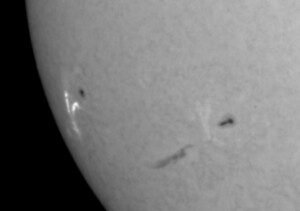 17:02:45 UT. 17:02:45 UT. |
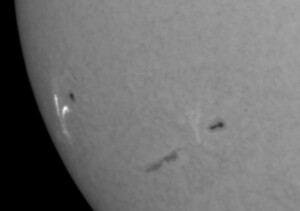 17:05:17 UT 17:05:17 UT |
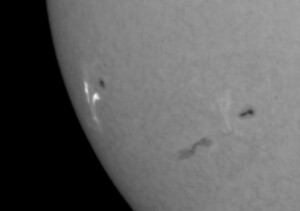 17:09:29 UT 17:09:29 UT |
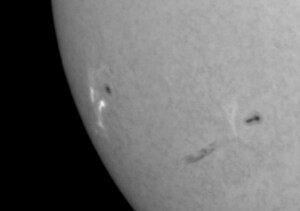 17:21:00 UT 17:21:00 UT |
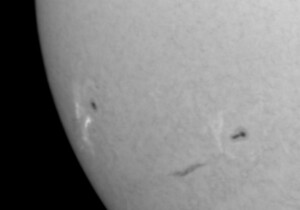 17:30:01 UT 17:30:01 UT |
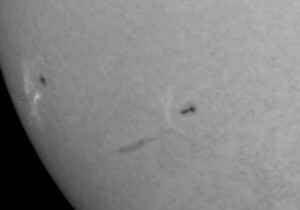 17:36:57 UT 17:36:57 UT |
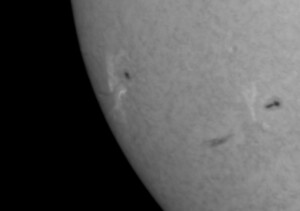 17:55:02 UT 17:55:02 UT |
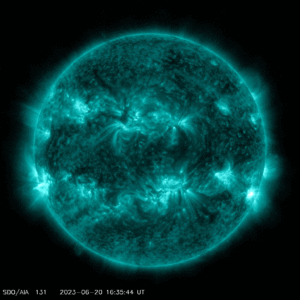 Solar Dynamics Observatory Animation Solar Dynamics Observatory Animation |
Solar activity is expected to be low with a chance of M-class flares and a slight chance for an X-class flare through at least 22 June.
June 14, 2023
Solar activity is low. There are seven spotted active regions on the visible disk, with three more spotless regions present, including AR 13327, which appeared spotless during visual sunspot observations early this morning. All of the regions are small, with regions 13331, 13333, 13335, and 13336 being the largest ones visible on the disk. The background solar x-ray flux remains at C-class levels. AR 13334 produced a C6.3/1F flare yesterday at 17:38 UT. AR 13327 produced a few small C-class and optical sub-flares. AR 13331 has lost most of its trailing spots, while 13333 grew slowly and produced a C2 flare yesterday at 12:45 UT. The newly visible regions AR 13335 and 13336 produced some low level C-class flares. Their visibility will improve as solar rotation brings them more into focus. So far today, AR 13333 produced six optical subflares prior to 12:00 UT; AR 13327 produced two subflares, AR 13334 was the source of one subflare, and AR 13335 produced a C2.0/SF flare at 9:31 UT.
AR 13335 produced a C3.7/SF flare at 15:16 UT, but the clouds remained large over the local observatory, delaying the start of the observing session until 40 minutes later. This same regions produced many subflares this morning, one of which happened just before the start of today’s session; the very next one just after the session concluded.
Each of the below images are 0.5 second exposures, with solar north up, west right, recorded at the times indicated on each image. The images each cover 13.8’x13.8′ on the sky. The first column below are red continuum images; the second column are H-alpha images and the UT of each image is “stamped” on the image.
Solar activity is expected to be low with a chance of M-class flares through at least 16 June. Active regions 13331, 13333, and 13334 are the ones most likely to produce such flares at this time.
June 13, 2023
The Sun continues to quiet down as the visible sunspot groups continue to shrink and decay. AR 13327 only has a handful of spots left, but AR 13331 has shown some growth as well as some decay. The other regions were stable and inactive. There continues to be occasional C-class flares, mostly from AR 13327, but AR 13329, AR 13330, and AR 13331 each contributed a C-flare or optical subflare. Today, AR 13329 produced a C4.9/SF at 12:07 UT, then newly emerged region AR 13333 produced a C2.1 at 12:45 UT. AR 13327 produced a C1.8 at 15:14 UT, but we were in the continuum imaging sequence (and the Sun was mostly behind clouds at this time), to be able to observe any optical counterpart. There was a C6.3/1F that peaked at 17:38 UT from an AR that just rotated into view, AR 13334. The X-ray flux background has stayed in the C-range for the last several days.
Each of the below images are 0.5 second exposures, with solar north up, west right, recorded at the times indicated on each image. The images each cover 13.8’x13.8′ on the sky. The first column below are red continuum images; the second column are H-alpha images and the UT of each image is “stamped” on the image.
Solar activity is expected to be low with a chance of M-class flares through at least 15 June.
June 12, 2023
The Sun has quieted down again, with the last M-class flare being the surprise event mentioned below. Since then, only occasional C-class flares have occurred, the largest of this was a C5.7 at 21:15 UT on 10 June. More recently, AR 13330 produced a C5.2/1N flare today at 6:58 UT. AR 13331 showed some growth and decay in adjacent spots. The other regions are in a state of decay, especially AR 13327, which looks like a pale remnant of its former self. One of the long polar crown filaments erupted from the northwest disk, beginning the process of lifting off the solar surface after 2:00 UT on 12 June. This produced a CME that was accelerated far above the orbital plane.
Each of the red continuum images (left column) is a 0.1 second exposure. Each of the H-alpha images (right column) is a 0.5 second exposure. Solar north is up, solar west is right, and the recorded times (in UT) are posted within each image. Each of the images cover 13.8’x 13.8′ on the sky, except where indicated otherwise.
Solar activity is expected to be low, with a slight chance for M-class flares through at least 14 June.
June 9, 2023
Solar activity just jumped to moderate levels as a surprise M-flare (looking like two parallel luminous ribbons in GONG H-alpha imagery) erupts from AR 13331 as this goes to post. It was expected that any M-class flare that would erupt would most likely come from AR 13327 or (less likely) 13323, but so far that has not happened. Today, AR 13323 has contiributed a few optical sub-flares and AR 13327 produced at c3.1/SF at 13:44UT, and a C4.5/1F at 14:40 UT. Prior to these, this region produced a C2.1/SF at 23:56 UT on 8 May. The current (as of the writing) has peaked at M2.5 at 17:11 UT and is now in decay phase.
AR continues to show some development and some consolidation among the spots in the middle of the active region. AR 13323, overall has decayed, but a few new spots have emerged among the decaying spots. The other seven numbered active regions were either stable or gradually decaying, and they seem to come in pairs or threes: ARs 13320, 13321, and 13323 near the west limb, AR 13326, AR 13329, and AR 13330 are on the north central disk, and ARs 13327, 13331, and 13332 are in the southeastern quadrant of the solar disk. The images below present each of these three groups of active regions in turn.
Each of the below images are 0.5 second exposures, with solar north up, west right, recorded at the times indicated on each image. The images each cover 13.8’x13.8′ on the sky, except where otherwise indicated. The first column below are red continuum images; the second column are H-alpha images and the UT of each image is “stamped” on the image.
Solar activity is expected to be low with a chance of M-class flares through at least 11 June.
June 8, 2023
Solar activity returned to low levels after the M4 flare early morning (local time) yesterday. AR 13327 continued to be the most interesting and active sunspot region on the visible solar disk and produced occasional C-class flares. AR 13323 continues to decay slowly in spot number and area as it rotates towards the western limb of the sun, following AR 13321. I observed a total of nine spotted regions on the Sun today and all of them (except 13327) continued to be unremarkable.
Each of the below images is a 0.5 second exposure. Solar north is up, solar west is right, and the recorded times (in UT) are posted within each image. Each of the images cover 13.8’x 13.8′ on the sky. The first column of images are red continuum (“white light”) images, and the second column displays H-alpha line center images.
Solar activity is expected to be low, with a chance for M-class flares and a slight chance for X-class flares through at least 10 June.
June 7, 2023
Solar activity became moderate today when AR 13327 produced an M4 flare at 11:26 UT, the first of this size in many days. Later in the day it produced a C9 flare at 18:35UT; this was two of three quick peaks that happened at 18:29 (C8.7), 18:35 (C9.2), and 18:50 UT (C7.0). It also produced additional C-class flares, including a C7.1 at 6:45 UT on 7 June. This region continues to grow and expand, while the other interesting region, AR 13323 is decaying. The other 7 numbered and 1 unnumbered region were all quiet.
Each of the below images is a 0.5 second exposure. Solar north is up, solar west is right, and the recorded times (in UT) are posted within each image. Each of the images cover 18.0’x 13.8′ on the sky, unless indicated otherwise. The first column of images are red continuum (“white light”) images, and the second column are H-alpha line center images.
Solar activity is expected to be low, with a chance for M-class flares and a slight chance for X-class flares through at least 9 June.
June 6, 2023
Low solar activity continued into today and continues to be low as of this writing (21:15 UTC). AR 13323 is the largest and most complex active region currently visible on the solar disk. Despite this and the rather complex magnetic structure it possesses, it only produced a few minor low-level C-class enhancements and mini-flares. These were also generated by AR’s 13320 and 13327. AR 13327 produced a C7.5/SF this afternoon at 19:00 UT (the optical counterpart peaked at 19:12 UT), after the observing session concluded.
There are a total of eleven spotted active regions/groups visible on the solar disk currently, with seven of them numbered. One of these unnumbered regions is a large spot rotating into view near solar latitude 22 degrees south. Everything remained quiet and inactive on the sun today.
Each of the below images is a 0.5 second exposure. Solar north is up, solar west is right, and the recorded times are posted in the upper right corner of each image. Each of the images cover 18.0’x 13.8′ on the sky. The first column of images are red continuum (“white light”) images, each of which cover 18.0’x13.8′ on the sky; the second column are H-alpha line center images, each covering 13.8’x13.8′ on the sky.
Solar activity is expected to be low, with a chance for M-class flares through at least 8 June. Today features a slight chance for X-class flares.
June 5, 2023
Solar activity has been low for the past several days and continues to be low today. The last M-class flare was an M1.5 that occurred at 2:41 UT on 2 June. Since then, only C-class flare have happened, the largest of which was a c5.7/1N at 14:30 UT on 4 June from AR 13327. This region rotated into view a couple of days ago and is growing. AR 13323 is also growing a bit, while the rest of the numbered active regions remain mostly unchanged. The Sun’s activity level continued to be at low levels through at least 19:00 UT, 5 June.
The filament we’ve been watching all last week has finally lifted off the Sun, on 4 June between 8:30 and 10:00 UT (see the animation below from the Solar Dynamics Observatory). Some of the filament moved north and crashed back down on the Sun, while some escaped into interplanetary space, forming a CME. This CME may influence Earth’s environment on the 8th of this month. The X-ray flux background has been above C-level since last week.
Each of the below images is a 0.5 second exposure. Solar north is up, solar west is right, and the recorded times are posted in the upper right corner of each image. Each of the images cover 18.0’x 13.8′ on the sky. The first column of images are red continuum (“white light”) images, while the second column are H-alpha line center images.
Solar activity is expected to be low, with a chance for M-class flares through at least 7 June. There is a slight chance for X-class flares through 6 June.
June 1, 2023
Solar activity reached moderate levels late yesterday after AR 13323 produced a long-duration M4.3 flare that peaked yesterday (May 31) at 22:52 UT. The event began over an hour earlier, at 21:47 and delayed briefly in the upswing. The region also produced an M1/SF at 22:08 UT during its long-duration M4 flare (likely from another part of the region) and a number of C-class flares. AR 13319 generated a few C-class flares and an M1 flare at 12:26 UT on May 31. AR 13315 produced a C9 flare at 00:41 UT on June 1. This (so far) has been the strongest flare of today (up to 21:45 UT, 1 June). AR 13323 produced most of the flares today, all low C-class and optical subflares; AR 13315 contributed some of these flares as well, including a C6.5 at 11:25 UT.
Each of the below images are 0.5 second exposures, with solar north up, west right, recorded at the times indicated on each image. The images each cover 13.8’x13.8′ on the sky, except the last row of images, which cover 13.8’x18.0′. The first column below are red continuum images; the second column are H-alpha images.
Solar activity is expected to be low with a chance of M-class flares through at least 3 June.
May 31, 2023
We are watching the departure of an old batch of sunspot as they prepare to rotate over the western limb, a total of 9 active regions. The complex in the northern hemisphere have decayed to the point of being unremarkable, while the ones in the southern hemisphere (actually only two) have grown to be the largest groups on the solar disk. Solar activity remains at moderate levels due to a series of impulsive low-level M-class flares. AR 13315 produced one such event yesterday, an M1.4/1B event that peaked at 13:38 UT. New AR 13323 produced another event, an M1.3 today at 4:38 UT. This region had been the source of most of today’s flares, at least six C-class flares. AR 13319 also produced C-class activity: a few today and more yesterday as it grows rather rapidly, rivaling AR 13315 as the largest spot group on the visible disk. AR 13315 has begun to decay some in the trailing end.
The other spots were quiet and stable. We observed a C3.3/SN flare from AR 13315, peaking at 16:39 UT. This was actually preceded immediately by a C2.5 which peaked at 16:20 UT (we were observing the region by 16:21 UT). A C9.6 flare erupted from AR 13323, peaking at 20:10 UT; this was followed by a C6.8 at 20:48 UT, from the same region.
Each of the below images are 0.5 second exposures, with solar north up, west right, recorded at the times indicated on each image. The images each cover 13.8’x13.8′ on the sky, except the last image, which covers 13.8’x18.0′. The first column below are red continuum images; the second column are H-alpha images.
Solar activity is expected to be low with an increasing chance of M-class flares through at least 2 June.
May 30, 2023
Overall, solar activity has been low with the occasional M-class flare since 26 May, but this increased to moderate levels with three M1 flares all within a span of 5.5 hours. Two of these came from AR 13310 as it rotates over the western limb. It also produced two C-class flares. AR’s 13312 and 13317 each produced low-level C-class flare activity. There are currently 10 spotted regions on the Sun, eight of which are numbered so far. AR 13315 remains the largest visible region on the solar disk but it has remained quiet.
Each of the below images are 0.5 second exposures, with solar north up, west right. The images cover 16.0’x13.8′ on the sky. The first column below are red continuum images; the second column are H-alpha images, and each was recorded at the times indicated on each image.
Solar activity is expected to be low with a chance for M-class flares through at least 1 June.
May 26, 2023
Today included a follow-up imaging session as we continue to follow the visible active regions across the Sun, then break for the long weekend. Solar activity had been moderate, but since the M1/1N flare yesterday at 14:46 UTC from AR 13312, there had been no further M-class flare activity, with the exception of an M1 flare event in progress as of this writing (22:55 UT). This is coming from AR 13311. All was quiet today except for fairly frequent low-level C-class activity from AR’s 13314 and 13315. In fact, the former produced a C5.5/SF at 17:54 UT just after the end of today’s session. Another spotted region, AR 13316, emerged today but was quiet as were the remaining visible regions which were each stable or in decay state. A filament erupted off the WSW limb of the Sun at 2:30 UT on 26 May.
The most recent event appears to be two events: a C6.9 that peaked at 22:43 UT from AR 13315, and an M1.3 that had a flat peak that ultimately crested at 23:04 UT, from AR 13311. The events are in decline as of 23:25 UT.
Each of the below images are 0.5 second exposures, with solar north up, west right. The images each cover 13.8’x13.8′ on the sky. The first column below are red continuum images; the second column are H-alpha images.
Solar activity is expected to be low with a chance of M-class flares through at least 28 May.
May 25, 2023
Solar activity was moderate, with AR 13311 being the source of a majority of the events that have occurred in the last couple of days. It produced an M1.8/1F flare at 17:21 UT on 24 May. AR 13314 has become a separate entity once again, as it redeveloped some spots to set it apart from AT 13311. AR 13315 continues to grow in size and complexity and produced an M1/SF at 19:10 UT, 24 March. New spots were seen north of the large leader spot of AR 13310 but these have not received a designation yet. AR 13312 produced an M1.1/1N at 14:46 UT on 25 May 2023, just before the start of the morning session today. AR’s 13310, 13311, 13312, 13314, and 13315 each contributed flare events today. A prominence erupted off the SW limb occurred today around 8:00 UT. Another filament in the northeast corner of the Sun’s disk, just east of AR 13314 appeared to be a bit active but remains in place as of 20:55 UT.
Each of the below images are 0.5 second exposures, with solar north up, west right. The images each cover 13.8’x13.8′ on the sky, except where indicated otherwise. The first column below are red continuum images; the second column are H-alpha images.
Solar activity is expected to be low with a chance of isolated M-class flares through at least 27 May.
May 24, 2023
Solar activity was moderate, with AR 13311 producing numerous C-class flares, an M3 flare at 12:13 UT on 23 May, an M1.0/SN flare at 9:58 UT today, and an M1.8/1F flare at 17:21 UT today. The numerous C-class flares continued into today. AR 13311 remains the most complex region visible on the solar disk today, with the other visible regions, including AR 13315, being relatively quiet.
Each of the below images are 0.5 second exposures, with solar north up, west right. The images each cover 13.8’x13.8′ on the sky. The first column below are red continuum images; the second column are H-alpha images.
Solar activity is expected to be low with a chance for isolated M-class flares through 25 May; the chances for M-class flares increase on 26 May as old AR 13296 is expected to return.
May 23, 2023
The anticipated major flares from AR 13311 never came, as of 22:00 UT today. Only lots of pointlike “sub-flares”, a few of which were captured in today’s imaging session, which was on and off due to frequent (also unexpected) cloud interruptions. AR 13312 had some development and produced an M1.9/1N flare at 13:37 UT on 22 May. AR 13311 did produce an M3.0/SN flare at 12:13 UT, the largest (so far of the last two full days. In addition, I counted 28 small optical flares (most SF, two 1F, one SN) from 1:44 UT to 19:18 UT. A handful of these was accompanied by low-level C-class flares and the M3 flare already mentioned. The X-ray background has been in the low C-range since 5:00 UT 17 May, nearly a week ago.
AR 13310 showed some growth but stayed quiet. AR 13311 remained the most complex spot group visible on the Sun’s disk, and it “absorbed” AR 13314 as most of its spots decayed to plage and the rest was overtaken by 13311.
Each of the below images are 0.5 second exposures, with solar north up, west right. The images cover 13.8’x13.8′ on the sky. The first column below are red continuum images; the second column are H-alpha images. The top row displays AR 13310 and 13312, and the bottom row images display AR 13311 and 13314. Each was taken at the time indicated.
Solar activity is likely to be moderate through at least 25 May due mainly to the flare potential of AR 13311.
May 22, 2023
Solar activity remained moderate over the last several days, with the barrage of regular M-class flares continuing through 21 May. There were ten discrete events from 0:49 UT, 19 May through 2:15 UT, 21 May, all of which came from AR 13311. The strongest of these was an M8 at 12:35 UT on 20 May. More recently this region had shown some decay in the middle of the region. AR 13308, which is about to rotate out of view, showed some minor growth. and a prominence lifted off the surface of the sun around 6:30 UT today. Surprisingly, AR 13312, which does not show much in the way of spot complexity, produced a C7.2/SF/SN flare at 13:27 UT, and an M1/9/1N/1B flare at 13:33 UT, lots of activity over a short span of time. So far, AR 13311, the source of great flare potential, has been quiet and unremarkable through at least 18:45 UT, 22 May 2023.
The quiet, low level activity persisted through at least 23:00 UT today, with none of the forecasted M- or X-class flares occurring with AR 13111. The only event of note was a C3 flare at 18:37 UT from AR 13312. The X-ray background did stay above C1 level all day.
Each of the below images are 0.5 second exposures, with solar north up, west right. The images cover 13.8’x13.8′ on the sky. The first column below are red continuum images; the second column are H-alpha images.
Solar activity is likely to moderate to high through at least 24 May due to the flare potential of AR 13311.
May 18, 2023
Solar activity rose to moderate to high levels. There was M-class flare activity from an unnumbered region on the NE limb. AR 13310 produced a few low level C-class flares. AR 13309 produced a C4.3/SF are 15:20 UT on 17 May. This produced a Coronal Mass Ejection (CME) Another CME was generated by a filament eruption from the same general area. A series of M-class flares began at 6:25 UT today and was the first of eight such events, the last of which (for 18 May) was an M5 from AR 13311 during the short observing session (pictured below). In fact, all of these events were from the same region. AR 13305 redeveloped a bit as did AR 13308. These will rotate out of view in a few days.
Each of the below images are 0.5 second exposures, with solar north up, west right. The images cover 13.8’x13.8′ on the sky, except where indicated otherwise. The first column below are red continuum images; the second column are H-alpha images. The top row displays the same area of sun (west limb) and the bottom row images display the same area (east limb) of the sun. Each was taken at the time indicated.
Solar activity is expected to be low with a chance for isolated M-class flares through at least 20 May
May 17, 2023
After reaching high levels with yesterday’s M9.6 flare from just over the ESE limb, solar activity returned to low levels for the rest of the day and for most of today, through at least 21:50 UT. There was a C9.5 flare from an undetermined source that peaked at 21:47 UT. The region that was the source of the M9.6 flare also produced additional C-class flares. There were quite a few C-class flares today, from AR’s 13310, 13305, and 13309. Of the three C-class events that occurred during today’s 2.5 hour session, only one was visible, from AR 13309. Old region AR 13288 has rotated over the east southeastern limb and has been renumbered 13310, as is usually the case for regions making a second rotation/appearance on the solar disk. AR 13305 has been relatively quiet and the rest of the other 8 visible active regions were quiet and stable.
There continues to be plenty of filaments visible on the solar disk. Today there is 18 total. A 14-degree long filament near S13 E62 (near the east southeastern edge) disappeared at approximately 10:54 UT on 16 May. This one was mostly reabsorbed into the Sun as opposed to launching off into interplanetary space.
The below images were taken at the times indicated on the image and include a variety of surface features, from spots, to filaments, to a solar flare. The top two images are in red continuum light; the remaining 4 are in H-alpha. Each covers 13.8’x13.8′ on the sky, except for the last one, which covers 18.0’x13.8′. Each is a 0.5 second exposure and each is oriented so that solar north is up, west is right.
Solar Activity is expected to be low, with a chance for isolate M-class flares, through at least 19 May.
May 16, 2023
Non-meteorological circumstances today limited the observing session to 15 minutes, time only to get a few white-light images of the visible active regions on the Sun. The complex of 3 regions, AR 13301, 13302, and 13305, continue to dominate the solar disk. AR 13304 is nearly spotless, and three more spots or tiny spot groups, yet to be numbered, have appeared on the solar disk. AR 13305 produced a pair of c1 flares today at 4:31 and 4:44 UT. Several additional C-class flares occurred since, but without attribution to a specific active region. The largest of these was a C4.5 at 12:14 UT. Then, before today’s short session, an M9.6 flare erupted, peaking at 16:43 UT. This came from a region just beyond the ESE solar limb, likely from old AR 13288, which produced 45 C-class flares and 4 M-class flares during its last appearance on the last rotation.
Each images measures 18.0’x12.0′ and is a 0.5 second exposure, oriented so that solar north is up, west is right.
Solar activity is expected to be low to start with on 16 May, with increasing chances for M-class flares on 17 and 18 May with the return of old AR 13288, the likely source of today’s M9 flare.
May 15, 2023
With AR 13296 and its companions rotating out of view, solar activity has returned to low levels. A few new active regions have emerged, including AR 13306, which produced a C3.4 flare at 0:51 UT 15 May. There was another C-class flare, a C1.7 from an area over the SE limb of the Sun, possibly from old AR 13299, which is due to return on May 17. During its last trip across the Sun’s disk, it produced M-class flares. There is another region emerging near S09 E39, which is AR 13307. It was visible since at least yesterday afternoon. The last M-class flare occurred late on 11 May. All the other regions were quiet and stable.
The main cluster of active regions are pictured below, in white light/red continuum, and H-alpha. Each image covers 18.0’x13.8′ on the sky and is a 0.5 second exposure, taken at the time indicated in the lower left corner of each image. Solar north is up, west is right in each image.
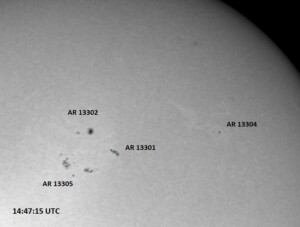 Five spotted regions (labeled) are visible in this red continuum image. Five spotted regions (labeled) are visible in this red continuum image. |
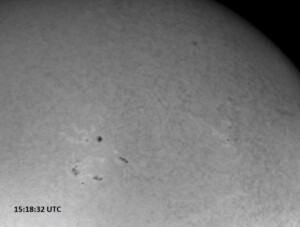 The same five regions as viewed in H-alpha. A filament is visible on the right center edge. The same five regions as viewed in H-alpha. A filament is visible on the right center edge. |
Solar activity is expected to be low, with a slight chance for isolated M-class flares through at least 17 May.
May 11, 2023
Since the last observation session the frequency and strength of the M-class flares on the Sun have decreased markedly. Since the double event of 9 May after 1800 UT, there had only been 3 M-flares, an M2.2 at 14:20 UT on 10 May; an M2.2 at 11:09 UT on 11 May, and an M1.8 at 18:30 UT this afternoon just before the observing session. There are 10 spotted regions on the Sun today, 8 of which are numbered. AR 13296 is weakening; it lost its delta magnetic signature yesterday but it is still complex magnetically. It is still unstable, being the source of one of the M-class flares (AR 13294 was the source of the other two) and several C-class flares. AR 13297 remained mainly unchanged and the rest of the regions have been rather unremarkable.
Each of the below images are 0.5 second exposures, with solar north up, west right. The images cover 13.8’x13.8′ on the sky. The first column below are red continuum images; the second column are H-alpha images. The top row displays the same area of sun (west limb) and the bottom row images display the same area (east limb) of the sun. Each was taken at the time indicated.
Solar activity is likely to remain moderate with isolated M-class flares likely, along with a slight chance of X-class flares, through at least 13 May. This is mainly due to the flare probability of AR 13296.
May 9, 2023
A break in an extended period of cloudy, rainy weather allowed for an hour-and-a half session, enough time to view parts of three flares! The active region cluster that rotated into view crossed the center of the Sun’s disk and has moved to the western hemisphere. AR 13296, a sunspot group with a magnetic polarity reversed compared to typical northern solar hemisphere sunspots during Cycle 25. Hale’s law stats that all (or most) sunspots of a particular hemisphere have the same polarity, with spots of the opposite hemisphere having the opposite magnetic polarity. In other words, for a typical northern hemisphere sunspot for the current solar cycle, the positive polarity is the front half, and the negative polarity is the back half, and vice versa for southern hemisphere spot groups. AR 13296 shows the opposite. It also has been unusually active, producing lots of flares.
There was a lull in the M-flares from late 5 May through late 7 May, then at 22:20 UT that same day, a long-duration M1.5 flare erupted from AR 13296 and lasted over six hours, with additional flares enhanced by its decay tail. An M2.3 of much shorter duration then happened at 20:24 UT, 8 May. Then there was an M6.5 flare at 5:34 UT on 9 May from the same AR as this region grows in the middle region but decays in the leading region. AR 13297 is also growing and has the potential for large flares but it has only been producing low-level C-class events. Since the M7 event, AR 13296 produced four more M-class flares: an M1.2 at 6:13 UT, an M1.3 at 10:20 UT, an M4.2/1B events at 18:58 (today’s session began while this flare was still in decay, with an M1.2 enhancement or “spark” at 20:09 UT; then finally an M5.0/1N, the beginning and peak of which was observed before the clouds filled back in, stopping the observing session.
There are three more unnumbered spotted regions rotating into view on the eastern limb of the Sun, but they look unremarkable so far.
Each of the below images is a 0.5 second exposure. The first image (red continuum) covers 13.8’x13.8′ on the Sun, the second and third (at various stages of the M5/1N flare event) are each 16.2’x13.8′. Each is oriented so that solar north is up, west is right. The brightening in the lower left of the H-alpha images is an image artefact.
Solar activity is likely to stay moderate, with more M-class flares likely along with a slight chance of X-class events through at least 11 May. These are due to the enhanced flare probabilities of ARs 13296 and 13297. Unfortunately the weather forecast calls for more thick clouds and heavy rain making further observations of this activity unlikely, but as of this writing, the forecast is for partly sunny on 11 May, so there may be more opportunity for observations then.
May 5, 2023
Yesterday was clouded out, today returned to partly cloudy conditions and enabled a morning observing session. Overnight (local time) a filament lifted off the Sun’s eastern edge. This started a chain of events that included strong flares and a solar tsunami. These explosions may have launched several overlapping CME’s into interplanetary space. These images depict the event from these three wavelengths (three images immediately below) show different aspects of the events. More information can be obtained from today’s spaceweather.com story. Each of the animated gif’s were obtained from the Solar Dynamics Observatory (SDO) thru three of its filters. Click on each for the animation.
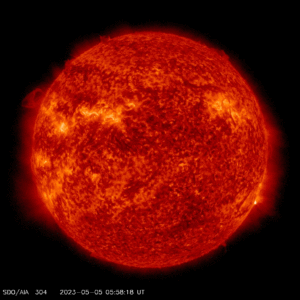 SDO 304 A, gas temperature of 50,000K SDO 304 A, gas temperature of 50,000K |
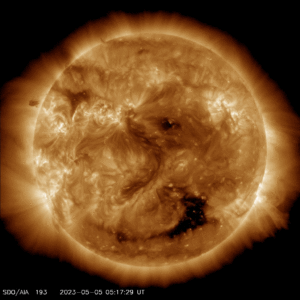 SDO 193 A, gas temperature of 1,000,000 K SDO 193 A, gas temperature of 1,000,000 K |
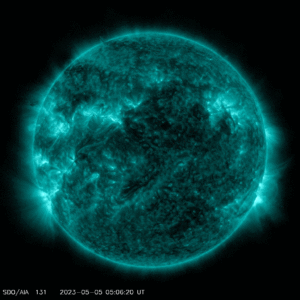 SDO 131 A, gas temperature of 10,000,000 K SDO 131 A, gas temperature of 10,000,000 K |
There was a continuation of moderate solar activity with an M3.9 flare on 4 May at 8:44 UT (this was a long-duration event from AR 13296). The next M-class flare occurred this morning / overnight local time, with a long duration M2 flare from AR 13296 at 8:01 UT. Another M-class flare occurred at 15:31 UT, while we were working through the red continuum imaging sequence. This was followed by a C8.2 at 15:47 UT, the latter part of which was captured in the slightly offband (-0.1 Angstrom) image below. No further significant activity has occurred since, with the X-ray background slowly declining (at C1.3 level as of 222:05 UT). AR 13293 continued to slowly decay, AR 13289 and 13295 have decayed to spotless plage; AR 13298 (just southwest of 13294) formed late in Wednesday’s imaging sequence but was gone by today. AR 13297 looks large and impressive but its magnetic fields remain simple.
The first image, upper left quarter of image panel, displays a red continuum image covering 18.0’x13.8′ on the sky. The remaining three are H-alpha emission line (or near-line) center, 13.8’x13.8′ in size. Each image is a five second exposure and is oriented so that solar north is up, west is right (the P.A. axis, the apparent tilt of the Sun’s rotation axis as seen from Earth, has begun to decrease and is now -23.5 degrees, down from -26.2 degrees a few weeks earlier) in each image.
The background X-ray levels are expected to remain above C-class level through at least 7 May. There is a chance for isolated M-class flares and a slight chance for an X-class flare through at least 7 May.
May 3, 2023
Solar activity became high today due to an impulsive M7.3 flare at 10:45 UT today, from AR 13293. Over a 4.5 hour period, there were five M-class flares, the largest of which was the M7 just mentioned. These were preceded by a C9.6 flare from AR 13295 at 7:37 UT today. AR 13293 was the source for all five M-class flares. Because of the frequent flaring of this region earlier, and the favorable weather and other circumstances, today was a full day observing session to attempt to capture another large flare from this active region or its neighbors. So far, as of 20:15 UT, it has only produced low-level C-class flares, along with AR 13288 and 13297. The most recent M-class flare from AR 13293 was an M2.2 that peaked at 13:50 UT today, just prior to the start of the session.
The first column includes red continuum images, each 0.1 second exposure. The second column features H-alpha line center images, each also 0.5 second exposure. Each image covers 13.8’x13.8’ on the sky and heliocentric (solar) north is up, west right.
Solar activity is expected to be low with a chance for isolated M-class flares and a slight chance of X-class flares through at least 5 May. The flare probabilities come mainly from the flare potentials of AR 13288 and 13293, although all the visible regions have potential for flaring.
May 2, 2023
After yesterday’s M7.1 flare, everything is much quieter today, with only fairly regular occurrences of C-class flares from ARs 13288, 13289, and 13293. Another source of these flares is possibly a large AR that is about to rotate over the solar eastern limb. The largest event today so far (through 20:49 UT) was a C5.5 flare from AR 13288. AR 13288 has decayed somewhat, while AR 13293 showed some growth. There are five numbered spotted active regions currently visible on the solar disk with two (and possibly three) additional regions rotating into view along the eastern solar limb. Aside from magnetically-complex 13288 and 13293, the other regions are quiet, simple, and unremarkable.
Today’s weather was forecast to be cloudy, but the Sun shone brightly from the time it rose (enabling a good view of its disk visually for daily sunspot counts) until mid- to late-morning. So we conducted this observation session to get follow up images of active regions, to document their day-to-day changes. Thin cirrus was present throughout the session, increasing in thickness as the morning progressed. Hence, the H-alpha images appear low-contrast and a bit “washed out”. In addition to the cirrus, large cumulus clouds came and regularly interrupted the observations.
The first column includes red continuum images, each 0.5 second exposure. The second column features H-alpha line center images, each also 0.5 second exposure. Each image covers 13.8’x13.8’ on the sky and heliocentric (solar) north is up, west right.
Solar activity is expected to be low with a chance for M-class flares and a slight chance of X-class flares through at least 4 May. The flare probabilities come mainly from the flare potentials of AR 13288 and 13293.
May 1, 2023
AR 13288 produced an M7.1 flare this morning at 13:09 UT, raising solar activity to moderate levels. This follows an 2 at 20:28 UTC on 30 April from AR 13293 (just rotating into view) and an M1 flare at 1:21 UT on 1 May from AR 13288. AR 13288 continues to grow in complexity and has the potential to produce more M-class and possibly X-class flares. AR 13293 is also growing in size and complexity, while AR 13289 has decayed slightly. A C2.7/SF event was observed briefly from the Observatory from AR 13289 at 15:30. This event peaked at 15:27 UT. The other visible regions (there is a total of five spotted groups that are visible) are unremarkable.
The red continuum images (first column of the table below) are each 0.1 second exposures; the H-alpha images (right column) are each 0.5 second exposures. The first row containing images of AR 13285, 13288, and 13291, have the images cover 13.8’x13.8′ on the sky. The second row of images of AR 13289 and 13293 cover 18.0’x13.8′ on the sky. The images are such that heliocentric (solar) north is up and west is right; that is, they are aligned with the Sun’s coordinate system.
Solar activity is expected to be low with a chance for M-class flares through at least 3 May.
April 28, 2023
The Sun remains at low activity levels, with rather frequent C-class activity. Today, AR 13288 developed a beta-gamma-delta magnetic field type, a complex configuration that is conducive to large solar flare production. A C6 flare came from AR 13285 at 1:22 UT on 28 April. AR 13288 produced a C6.8/SF at 16:00 UT today, which was observed in one frame of image during the morning’s session (further observations of this event were not possible due to large and persistent convective cumulus clouds). AR 13288 produced most of today’s events, and generated a series of C-flares from 15:00 to 20:00 (with a low-level C-flare in progress from AR 13288 as of this writing). It appears like AR 13288, over time, is smoldering with almost continuous low-level C-flare and sub-flare activity. It does have the potential for an M- or even an X-class flare, but none have happened so far today.
A prominence erupted off the west limb earlier today, generating a CME that was detected by far UV satellite imagery beginning at 10:25 UT. This was likely the dark, semicircular filament that we had followed for several days.
The first column includes red continuum images, each 0.1 second exposure. The second column features H-alpha line center images, each 0.5 second exposure. Each image covers 13.8’x13.8’ on the sky and celestial north is up, west right.
Solar activity is expected to be low with a chance for M-class flares through at least 30 April.
April 27, 2023
Solar activity reached moderate levels today with an M1.8 flare at 11:14 UT from AR 13288. This was the first M-class flare since the M1.5 on 21 April at 18:20 UT. AR 13288 is growing, with increasing complexity as it gained intermediate spots (that is, spots between the large lead/front spot and the almost-as-large trailing/following spot). AR 13289, on the northeast limb, produced a few low-level C-class flares, which featured a long-duration C2.5 flare that peaked at 2:49 UT, 27 April. All the other regions, four more in total, were stable, quiet, and unremarkable.
The below images were made this afternoon after persistent clouds cleared. The first column includes red continuum images, each 0.1 second exposure. The second column features H-alpha line center images, each 0.5 second exposure. Each image covers 13.8’x13.8’ on the sky and celestial north is up, west right.
Solar activity is expected to be very low to low with a chance for C-class flares and a slight chance for M-class flares through at least 29 April.
April 26, 2023
Despite a mostly cloudy, chance of rain type forecast, the clouds partially parted at mid-day to allow more than enough time to complete a quiet sun imaging sequence. AR’s 13284 and 13287 both decayed to plage. AR 13290 and 13291 emerged in the solar northern hemisphere. Two of the filaments in the southern hemisphere which were imaged yesterday disappeared today. All the visible active regions are unremarkable. AR 13289 did produce a C2.5/SF this morning at 14:23 UT to break the monotony; otherwise solar activity remained very low.
Each of the below images is a 0.5 second exposure. The first column of images are red continuum images; the second column contains H-alpha line center images. Each image is 13.8’x13.8′ in angular size, with celestial north is up, west right, in each.
Solar activity is expected to be very low, with a chance for C-class and a slight chance for M-class flares through at least 28 April.
April 25, 2023
Today’s weather featured variable cloudiness all day, from brief instances of mostly clear, to generally partly cloudy and extended times of overcast. The first part of today’s sessions happened during on brief clearing spell. This was followed by two hours of cloudy conditions before another partly sunny period occurred, allowing more imaging before the clouds returned. This constantly changing weather continued after the session ended, but the Sun continues to exhibit low activity. AR 13283 decayed to spotless plage, but as it does so it produced a C2.8 flare yesterday at 13:05 UT. AR 13285 showed some decay in its trailing region and was the source of a C1.5/SF at 17:27 yesterday (before yesterday’s session began), and AR 13288 emerged rapidly and produced C1.7 flare today at 8:07 UT.
Each of the below images is a 0.5 second exposure. The first image is a red continuum image; the remaining images are H-alpha line center images. Each image is 13.8’x13.8′ in angular size, except for the H-alpha image of AR 13281, 13283, and 13284 and filaments. This image covers 18.0’x13.8′ on the sky. Celestial north is up, west right, in each image.
Solar activity is expected to be very low, with a chance for C-class and a slight chance for M-class flares through at least 27 April.
April 24, 2023
The Sun’s activity level had been at very low to low levels these last few days. AR 13282 is in the process of rotating out of view and it produced several low-level C-class flares; including two events today. The most recent was a C1.1 today at 16:22 UT. This region has started to decay, but AR 13285 has shown some slight growth. It was the source of a C1.5 flare at 17:27 UT today (prior to start of today’s session). AR 13283 contributed a C2.8 at 13:05 UT, the largest event since a C4.8 at 1:48 UT on 22 April. No flares have occurred from 17:27 to at least 22:15 UT today.
Each of the below images is a 0.5 second exposure. The top row of images cover 18.0’x13.8′ on the sky, while the bottom row of images are cropped to 13.8’x13.8’square. The first column contains the red continuum images; the second column contains the H-alpha line center images. Celestial north is up, west right, in each image.
Solar activity is expected to be low, with a chance for M-class flares through 25 April and a slight chance for M-class flares through at least 26 April.
April 21, 2023
The expected clearing of the skies did not occur until late in the day, but it was enough to obtain a complete set of images of the visible solar features. Several hours prior to the observing session, a filament erupted, producing an m1.7/2N parallel ribbon flare (from the vicinity of AR 13282) and launching a coronal mass ejection straight toward the Earth. (Image courtesy of spaceweather.com, click on the image for the full animation of the flare event.)
Aside from this event, solar activity remained on the low side today. The only other flare for the day was a C4.0/SN from AR 13279, which peaked at 22:23 UT (as we were just getting started, working in the continuum). A dark surge was noted just south of the main/leader spot of AR 13282 (pictured below). Each of the below images is a 0.5 second exposure and cropped to 13.8’x13.8’square. The first image, with the labeled regions, covers 18.0’x13.8′. The first column contains the red continuum images; the second column contains the H-alpha line center images. Celestial north is up, west right, in each image.
Solar activity is expected to be low, with a 35% chance for M-class flares through at least 23 April.
April 20, 2023
Overnight in North America, there was a hybrid solar eclipse on the other side of the world. This means the ends of the eclipse were annular, then became total as the curvature of the Earth brought it closer to the Moon. More information on this event can be obtained at the Eclipse Wise web page for this event. Images of this event can be viewed at the Spaceweather.com Realtime Images page. There is over three hours of videotape coverage and commentary from Exmouth, Australia, at https://www.youtube.com/watch?v=StSPFuFi4g0 To watch the several minutes centered around totality, start the video at 1:23:00 and watch the dramatic change that takes place as the crescent Sun (red H-alpha image) thins and “disintegrates”. Totality at this site lasted 55 seconds. This is a sneak preview of the eclipse that will cross North America on 8 April 2024. More information on this can be viewed at Eclipse Wise.
Overcast skies briefly became mostly cloudy skies as some breaks appeared for less than one hour. This was enough to get a quick set of follow-up images of visible active regions, mainly in continuum imagery. The holes were not large enough to capture very many H-alpha images and the one displayed below was flat fielded with the continuum flats, so it was not the best outcome. The images are cropped to 12.9’x13.8′ to remove the effects of imaging processing (though some still persist, especially in the H-alpha image. Solar activity remained low today, with only low-level C-class flare events and optical sub-flares. AR’s 13282 and 13283 contributed most of these but AR 13281 and 13284 also contributed; AR 13281 was the source of the largest flare so far today: a C3.6 at 9:22 UT, 20 April. AR 13282 has developed a beta-gamma magnetic configuration. All the other regions were either unremarkable, stable, or quiet.
A large new spot is rotating into view near S18E85. It is too early to tell how active this one will be.
AR 13282 and some of the smaller regions were imaged below. Some artefacts of the processing appear as “craters” and fade spots, especially in the second image. Each image is a 0.5 second exposure
Solar activity is expected to be low, with a chance for M-class flares, through at least 22 April.
April 19, 2023
The cloudy weather broke into partly to mostly sunny weather around mid-afternoon or 20:00 UT. The observing session began and we were able to image the entire Sun several times. Solar activity remained low. The activity had been coming primarily from AR’s 13272 as it departed over the western solar limb; and 13283. Large AR 13282 remained quiet prior to this morning. Some increase in area happened in AR’s 13279, 13282, and 13284. The rest of the regions were either stable or in slight decay.
AR 13282 did produce a C1.8 at 13:18, a C2 at 13:35, a C2.3 at 13:47, a C2.7 at 16:08 and a C3.4 (the largest today so far) at 16:28. All else was quiet, including during the hour long viewing session this afternoon.
Each of the images below are 0.5 second exposures. The two images in the top row, of AR 13282 and other regions, each cover 18.0’x13.8′ on the sky; the bottom continuum image of AR 13284 also covers 18.0’x13.8′; the H-alpha image of 13284 covers 13.8′ square. The first column images are in red continuum, the second column in H-alpha. Celestial north is up, west is right in each image.
Solar activity is expected to be low, with a chance for M-class flares and a slight change for an X-class flare through at least 21 April.
April 18, 2023
The skies cleared rather unexpectedly (from cloudy and rainy early in the day to partly cloudy by early afternoon) allowing follow-up observations to be made of existing active regions and the many filaments visible on the Sun’s disk. So far it has been quiet on the Sun with only the occasional C-class flare. A C6.9/SF came from AR 13282 at 14:17 UT yesterday. This region has grown slightly. AR 13280 is rotating out of view, producing a few small C-class flares as it departs. ARs 13279 and 13284 showed some growth and increase in complexity, and the other regions were quiet and stable. For today (18 April) through at least 21:40 UTC, AR 13282 has not produced any flares. Only AR’s 13280 (from just over the southwestern limb) and 13283 generated some low-level C-flares, the largest of which was a C3.2/SF at 18:13 (just before this afternoon’s observing session) from AR 13283.
Each of the images below are 0.5 second exposures. The two images in the top row, of AR 13282 and other regions, each cover 18.0’x13.8′ on the sky; the bottom two are each 13.8′ square. Each is H-alpha except the first one, which is red continuum. Celestial north is up, west is right in each image.
Solar activity is expected to be low, with a chance for M-class flares and a slight change for an X-class flare through at least 20 April.
April 17, 2023
Despite the impressive appearance of some of the sunspot groups (including a long string of active regions across the southern hemisphere) and two of the regions having complicated “beta-gamma” magnetic configurations, there has been no M-class flare since late 14 April, when an M1.5 at 23:27 on 14 April occurred. Since then the largest had been a C9.0 at 17:44UT on 16 April. The source of this flare was an active region beyond the northeast limb of the Sun. AR 13281 produced a C7 flare at 6:33 UT today, 17 April. Additional C-class flares came from AR’s 13282, 13280, and 13279. AR 13283 showed growth while the remaining regions were either stable or in decay. The quiet Sun conditions continued throughout the day today, including the duration of this morning’s observing session.
The left column of the table contains red continuum images, and the right column contains H-alpha images; each of the four images is a 0.5 second exposure. The top row of images cover 13.8’x13.8′ on the sky; the bottom row covers 13.8’x18.0′ on the sky. Celestial north is up, west is right in each image.
Solar activity is expected to be low, with a chance for M-class flares and a slight change for an X-class flare through at least 19 April.
April 14, 2023
Unlike the last several days, the weather was not very cooperative for observing today. Although the day started out partly cloudy, the clouds increased (“ahead of schedule”) by the time we were able to open up this morning. Visual sunspot counts earlier this morning revealed that AR’s 13280 and 13282 grew dramatically since yesterday, so I wanted to get images of these. I was able to do so, but through occasional breaks in clouds and mostly with some cloud interference. This interference shows itself in diagonal broad streaks in the image. The sky became solidly overcast before we could do any H-alpha imaging, so only continuum images were collected today.
AR 13282 produced most of the flares today so far, including an M1.1 (hidden behind the clouds) at 16:18 UT. The rest were C-flares from this region and AR 13281. The below continuum images are each 0.5 second exposures of the indicated regions at the indicated times. Each measures 13.8’x18.0′ on the sky unless indicated otherwise.
Solar activity is expected to be low, with a chance of M-class flares, through at least 16 April.
April 13, 2023
Solar Maximum may arrive early, as early as late this year or early next year. Today’s (April 13, 2023) spaceweather.com has details as to why this may be the case. The website speaks of a “magnetic termination event” that may be currently underway. Check out the website for more details. The below diagram shows the sunspot numbers over the course of 4-1/2 solar cycles, and indications show that we may be reaching the peak of the current cycle by early 2024.
The favorable observing weather continues but the Sun remained quiet for the day. Observations happened in the morning hours, but no flaring events were observed. The largest event was a C8.4 event that came from AR 13279 at 10:43 UT. There were a number of C-class events and optical subflares from AR 13279 mostly, with a few from AR’s 13272, 13280, and 13281. The most complex regions, magnetically speaking, are AR 13272 and 13280, both with beta-gamma magnetic configurations. These were the subject of a short watch for flares from this morning’s observing session. However, as of 20:40 UT, 13 April, these have remained almost completely quiet.
The left column of the table contains red continuum images, each 0.1 second exposure. The right column contains H-alpha images, each 0.5 second exposure. The top row of images cover 13.8’x18.0′ on the sky; the bottom row covers 13.8’x13.8′ on the sky. Celestial north is up, west is right in each image.
Solar activity is expected to be low, with a chance for M-class flares and a slight change for an X-class flare through at least 15 April.
April 12, 2023
Beautiful weather for a morning observing session, but the Sun remained quiet during the 3 hours we watched. There was a 50% chance of an M-class flare today and a slight chance of an X-class flare, so we watched the two most likely regions to flare: AR 13272 and AR 13276. Beyond 13276, on the solar edge, another, potentially large active region is starting to rotate into view and a C5 event was observed from this one. Overall, solar activity remained low, and ARs 13272, 13273, and 13276 each produced a few C-class flares. The largest of these was a C5.9/1B at 22:42 UT, 11 April. AR’s 13275, 13277, and 13278 were inactive today.
A filament erupted in the southwest quadrant of the Sun, producing a Coronal Mass Ejection that was observed by satellite shortly after 4:00 UT today. It was not the large, dark filament that we had been watching yesterday (pictured below) as it was still present during today’s observing session.
The red continuum images, each 0.1 second exposure, are presented in the left column. The H-alpha images are shown in the right column. Each image is 13.8’x18.0′ unless otherwise indicated. Celestial north is top, east at left unless indicated otherwise. The Sun’s north polar region is tilted toward the left by26.2 degrees.
Solar activity is expected to be low with a chance for M-class flares and a slight chance for X-class flares through at least 14 April.
April 11, 2023
After an extended period of cloudy weather, the skies broke enough this afternoon to allow a short session under excellent seeing. The Sun displays a few respective sunspot groups these days. The largest is near the solar disk center, AR 13272, which is responsible for an M1.3 flare at 10:16 UT today. But AR’s 13272 and 13276 (which is growing) combined to produce over a dozen C-class flares yesterday through this morning. Things seem to have quieted down quite a bit since the M1 flare, as only a C2.1 occurred at 14:40 UT, from AR 13273. The rest of the event were merely enhancements in the B8-9 to C1 range, through 20:00 UT, 11 April.
AR’s 13272 and 13273 are imaged in the same field of view along with an un-numbered wide pair of spots. Each of the images is 0.5 exposure, with the red continuum at the left, and the H-alpha images at center and right. The right image shows a filament and prominence and a small patch of plage (the slightly brighter spot left and slightly below the bottom end of the filament). Each image is 18.0’x13.8′ and is orientated with celestial north up, west right. Solar north is tilted 26.2 degrees left of the vertical.
Solar activity is expected to be low, with a slight chance of M-class flares, through at least 13 April.
April 3, 2023
As the month of April began, the Sun was about to become a blank disk as sunspot groups rotated out of view or decayed to plages or small spots. The weather at the PV observatory has been unsettled for more than a week, but with periods of reasonably good weather to allow for some observations over the last week. This weather pattern is expected to continue through the end of the weekend with maybe a return to partly sunny skies by Monday the 10th. Sometime on April 2nd, a new sunspot group emerged where none was located just the day before. By 22:00 UT the group, AR 13270, formed a ring of sunspots that grew over the next day or so. We were able to observe this new sunspot group today as the cloudy weather gave way to partly cloudy skies late in the afternoon. Solar activity had been low with only C-class flares occurring. AR 13270 was the source of a C3.4/SN flare at 23:13 UT on 2 April. There were three other spotted regions on the Sun today, each of which were stable, small and quiet.
The two images depict AR 13270 and its surroundings. The red continuum image, top, depicts all four visible spotted regions on the Sun (labeled). The H-alpha image, bottom, shows 13270, along with several filaments visible in the area. Each image is a 0.5 second exposure, with the top image covering 13.8’x18.0′ on the Sun, the bottom image covers 13.8’x13.8′.
Solar activity is expected to remain at low levels with a slight chance of M-class flares through at least 6 April.
March 29, 2023
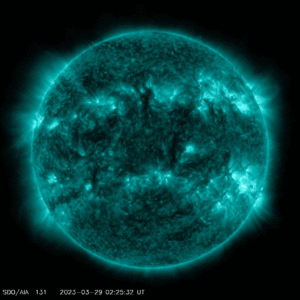 An X1.2 flare came from AR 13256 at 2:33 UT on 29 March. Click on the image (from spaceweather.com) at left for a short animation of the event. This event produced a CME which lofted off the WSW limb of the Sun, well ahead of Earth’s orbit. AR 13256 also produced an M1.2 flare that peaked at 14:07 UT. In addition, there was another flare that initially peaked at C5.6 at 16:12 UT before leveling off and increasing again to peak a second time at C6.6 at 16:25 UT before gradually tapering off. The source of this flare activity was also AR 13256. All three of these events happened prior to the start of today’s observing session.
An X1.2 flare came from AR 13256 at 2:33 UT on 29 March. Click on the image (from spaceweather.com) at left for a short animation of the event. This event produced a CME which lofted off the WSW limb of the Sun, well ahead of Earth’s orbit. AR 13256 also produced an M1.2 flare that peaked at 14:07 UT. In addition, there was another flare that initially peaked at C5.6 at 16:12 UT before leveling off and increasing again to peak a second time at C6.6 at 16:25 UT before gradually tapering off. The source of this flare activity was also AR 13256. All three of these events happened prior to the start of today’s observing session.
Two of the other regions, AR 13262 and 13265 produced isolated C-class flares. The other regions were stable and inactive, including three un-numbered spotted regions near S07 W15 (this was a cluster of five spots yesterday, but only a single spot remains today); N09 E46 (a small cluster of 6 spots, with one spot notably larger than the others); and S18 E51 (a dark, small spot). This totals to ten spotted regions, all small and most inactive.
The pattern of unsettled weather continued this week, with a mid-day clearing of the mid-level clouds. This allowed for observing for nearly one hour through cloud-free and nearly cloud-free skies. The session ran from 16:40 to 17:45 UT, when the clouds filled in to cover the sky once again. Each of the below images from today is a 0.5 second exposure. The red continuum images are in the left column, the H-alpha images are displayed in the right column, and each of the four images cover 18.0’x13.8′ on the sky. Celestial north is up, west right in each image.
Solar activity is expected to be low, with a slight chance for M-class flares, through at least 31 March.
March 28, 2023
Skies were mostly cloudy today as a steady stream of high clouds move over the area. Later in the morning, there was a thinning of the clouds to allow for some viewing. The image/seeing was steady (based on visual sunspot counts) but there was always a thin film of clouds/haze present which reduced H-alpha contrast significantly. Nonetheless, the daily collection of images was acquired, with the leftovers of a flare (image below) captured in the H-alpha image of the complex of active regions AR 13256, 13257, and 13259. This was a C2.3/SF that peaked at 15:47 UT from AR 13259.
Activity remained at low levels, with AR 13256 producing C-class flares. It is in the process of decaying after developing a beta-gamma magnetic configuration a few days ago. AR 13258 is rotating over the western limb and is not visible in the below images. Everything else was unremarkable: nine numbered spotted active regions are visible, with a tenth consisting of a small cluster of almost a half-dozen spots emerging near S05 W10.
Each of the below images from today is a 0.5 second exposure. The red continuum images are in the left column, the H-alpha images are displayed in the right column, and each of the four images cover 13.8’x13.8′ on the sky. Celestial north is up, west right in each image.
Solar activity is expected to be low, with a slight chance for M-class flares, through at least 30 March.
March 27, 2023
Solar activity remains low with only occasional C-class flares, most of these from AR 13256. AR 13258 produced a C2.9/SF at 19:01 UT today; the largest of today’s events was a C4.6/SF from AR 13256 at 6:36 UT today. This may have produced an observed coronal mass ejection, visible one hour later via SOHO. ARs 13256, 13263, and 13265 were the only growing regions, with the remaining images either being stable or in decay.
Each of the below images from today is a 0.5 second exposure. The red continuum images are in the left column, the H-alpha images are displayed in the right column, and each of the four images cover 18.0’x13.8′ on the sky. Celestial north is up, west right in each image.
Solar activity is expected to be low, with a slight chance for M-class flares, through at least 29 March.
March 25, 2023
The Sun remains at low levels of activity today. Some slight growth occurred in AR 13258, but the other regions were either stable or unchanging up to this point in time. Each of the below images from today is a 0.5 second exposure. The red continuum images are in the left column, the H-alpha images are displayed in the right column, and each of the four images cover 18.0’x13.8′ on the sky. Celestial north is up, west right in each image.
Solar activity is expected to be low, with a slight chance for M-class flares, through at least 27 March.
March 24, 2023
Solar activity remains at low levels as the background X-ray continuum falls to B-level. There were very few C-class flares yesterday but some more have occurred today, the largest of which was a C2.2 at 13:40 UT, 24 March. This came from AR 13259. The other regions show little change from day to day. Each of the images is 0.5 second exposure. The red continuum images are in the left column, the H-alpha images are displayed in the right column, and each of the four images cover 16.5’x11.9′ on the sky. Celestial north is up, west right in each image.
Solar activity is expected to be low, with a slight chance for M-class flares, through at least 26 March.
March 23, 2023
Much better weather today, with a period of mostly sunny conditions during the 45 minute observing session. The session was short, only to document a snapshot of today’s sun, as flare activity is quite subdued. Yesterday’s observed long-duration C2.5 flare (observed at 19:50 UT, peaking at 19:57 UT) from AR 13256 was the strongest since a C4.6 flare at 13:54 UT on 21 March. Since then, a couple of C1 flares and some high B-level enhancements have occurred as solar activity remains low to very low. There are six spotted active regions, with two more possibly emerging today (one just south of AR 13260 and one just north of AR 13259). The largest of these are 13260 and 13262, each of which cover an area equal to 180 millionth of the solar hemisphere.
Each of the images is 0.5 second exposure. The red continuum images are in the left column and are each 16.2’x12.0′. The H-alpha images are displayed in the right column and are trimmed to 15.9’x13.8′. Celestial north is up, west right in each image.
Solar activity is expected to be low, with a slight chance for M-class flares, through at least 25 March.
March 22, 2023
Observations attempted under partly to mostly cloudy skies this afternoon. Since the forecast called for partly cloudy skies, the observations were resumed today (it had been cloudy the last few days, then Spring Break before that). Solar activity was moderate a few days ago with occasional low-level M-class flares (it has been more than two weeks since an M5+ event). Most of the spotted regions are clustered just southeast of the solar central meridian, which is the focus for today’s images.
Only low-level C-class events occurred since yesterday. AR 13259 was the only visible region that showed growth, but it remained quiet. The other five numbered regions were either stable or in decline.
Observations were made in red continuum light and H-alpha, both types were made in 0.5 second exposures. Both images are 13.8’x15.0′ on the sky, taken at the indicated time, with celestial north up.
Solar activity is expected to be low, with a slight chance for M-class flares through at least 24 March.
March 10, 2023
Much better weather today; the expected cloudy conditions scattered out just after 1:00 pm local time and it has remained mainly sunny since. However, activity has waned and only a short session of follow up images of visible regions occurred today.
There has only been C-class flare activity today and yesterday, with AR 13242 decaying almost to a lone spot (a few tiny trailing spots remain), and AR 13245 starting to decay itself. There are now twelve spotted active regions visible on the solar disk, but most are small and simple. This region produced a C7/1F overnight (local time) at 7:08 UTC today. AR 13242 is approaching the western limb of the Sun and despite its decay, had produced a c4.5 flare at 10:06 UT today. There are a total of 10 spotted regions on the visible disk today, but most of them remain unremarkable.
Each of the images is 0.5 second exposure and covers 13.8’x18.0′ on the sky. The first column contain the red continuum images; the second column the H-alpha images; each of the designated active region taken at the listed time. Celestial north is up, west right in each image.
Solar activity is expected to be low, with a chance for M-class flares and a slight chance for an X-class flare through at least 12 March.
PROGRAM NOTE: This will be the last observing session until at least 20 March 2023.
March 9, 2023
Persistent cloudiness made for rather difficult observing but the seeing (atmospheric steadiness/clarity of images) was excellent between and apart from the clouds.
AR 13245 produced an M1.3 flare yesterday at 22:44 UTC (after our session closed for the day). This region is now slowly decaying but it produced some C-class events, including a C6.2 at 20:24 UT today (which we observed between clouds). This C6.2 occurred just 18 minutes after a C3 flare, also observed between clouds at our location. AR 13242 is decaying and losing spots and surface area but it is still able to produce several C-class flares. Other regions contributed to today’s solar activity, including AR 13248 (a C1.8 at 0:07 UT today), and AR 13250 (a pair of C2 flares at 18:16 and 21:09 UT today; we caught a few images of the optical component of the latter also). The rest of the regions were unremarkable today. There are now twelve spotted active regions visible on the solar disk, but most are small and simple.
Each of the images is 0.5 second exposure and covers 13.8’x18.0′ on the sky, except for the H-alpha image of AR 13242, which is 13.8′ square. The first column contain the red continuum images; the second column the H-alpha images; each of the designated active region taken at the listed time. Celestial north is up, west right in each image.
Solar activity is expected to be low, with a chance for an isolated M-flare and a slight chance for an X-flare from either AR 13242 or 13247, through at least 11 March.
March 8, 2023
The weather was much better for imaging today, staying partly to mostly sunny all day. We used 3 hours of today to collect images of all the visible features, with an emphasis on AR 13242, due to its flare potential.
Solar activity reached moderate levels with a long duration M1.1 flare at 10:12 UT today from AR 13242. This was the only M-flare so far today (up to 21:10 UT), with other regions (13244, 13245, and 13248) contributing low-level C-class flares yesterday and today. Aside from AR 13245, which experienced separation in its leader and intermediate spots, all the other ten visible active regions were either stable or in decay. AR 13242 produced a long-duration C3.7 flare at 19:44 UT.
Each of the images is 0.5 second exposure and covers 7.8’x11.4′ on the sky. The first column contain the red continuum images; the second column the H-alpha images; each of the designated active region taken at the listed time. Celestial north is up, west right in each image.
Solar activity is expected to be low, with a chance for an isolated M-flare from either AR 13242 or 13247, through at least 10 March.
March 7, 2023
Expected clearing this afternoon did not really happen but we did push forward with some imaging anyway. Some of the best images still show the influence of clouds. Solar activity was moderate due to an M1 flare yesterday at 17:50 UT from AR 13242. AR 13243 had produced a number of C-class flares; AR 13241 produced a C4.2 and C7.2 flare yesterday, within 18 minutes of each other yesterday. Growing AR 13245 was mostly inactive. The aforementioned M1 flare was the last M-class flare with solar activity today declining to low, with only low-level C-class flares.
The images below focus on the largest active regions currently visible on the Sun (there is a total of eleven spotted regions currently visible). Each image is cropped to 7.8′ square (except for the last one, which is slightly larger at 8.0’x7.8′. The first column contains red continuum images; the second H-alpha images; and each image is 0.5 second exposure.
Solar activity is likely to be moderate, with a slight chance of an X-class flare through at least 9 March due to the magnetic complexities of ARs 13242 and 13245.
March 6, 2023
The Sun’s activity reached high levels with five M-class flares occurring yesterday into early today. The largest of these was an M5.8/2N flare that came from AR 13243 at 2:28 UT on 6 March. Since then, two more M-class flares occurred, an M1.3 flare from over the western limb, and an M1.0 event from AR 13242. Since then, only C-class flares have occurred and the overall trend for the X-ray background is decreasing.
Clouds did not clear sufficiently for observations until late, and equipment problems further delayed the start of observations. No significant activity was observed during the one hour period that observations were conducted. The trend of lots of spotted regions on the Sun continues. There is one dominant region, AR 13242, and ten smaller regions scattered across the visible solar disk.
Each of the below images cover 7.8’x11.4′ on the sky and are 0.5 second exposures. The images in the left column of the table below are red continuum images; the right column images are H-alpha emission line images.
Solar activity is likely to be at moderate levels, with a slight chance of an X-flare through at least 8 March. This is due to the combined flare activity and potential of AR’s 13238, 13242, and 13243.
March 3, 2023
The Sun’s activity reached high levels today with an X2.0/1B flare at 17:52 UT from AR 13234. AR 13234 also produced an M3.3/1F flare at 10:32 UT today; and an M3.8 flare at 21:16 UT on 2 March (we were not able to open until the afternoon, so we missed the midday event). AR 12342 appears rather active and dynamic in today’s images. It sported a dark filament during this afternoon’s sessions. This region was the source of a C7.2/SF today at 2:23 UT. There are seven additional spotted regions visible on the solar disk today, but none of these was very active. Regions 13236 produced several optical sub-flares (SF’s) and AR 13239 produced a C3.0 flare at 7:16 UT.
The first row of images cover 13.8’x13.8′ on the sky; the second row, 13.8’x18.0′ on the sky; each image is oriented with celestial north up. The red continuum images, each 0.1 second exposure, appear in the first column of the table; the H-alpha images, each 0.5 second exposures, are displayed in the second column.
Solar activity is expected to be low, with a chance for M-class flares through at least 5 March; there’s a slight chance for an X-class flare through at least 4 March, from AR 13234 rotating over the western solar limb.
March 1, 2023
Solar activity has returned to low levels today after yesterday’s M8.6/2B flare from AR 13234. This region produced an M1.0/1N at 1:07 UT today then had been the source of a half-dozen C-class flares since. Regions 13236 (about to rotate out of view) and 13240 (on the opposite side of the solar disk) each produced C-flares, the largest of which was a C9.3 at 1:47. There are now six spotted regions visible on the solar disk, with the sixth being un-numbered as of this writing as it rotates into view over the eastern limb.
The day was cloudy except for about an hour of partly cloudy conditions, so observing was rather limited. Nonetheless, the entire Sun was imaged in H-alpha, especially the aforementioned regions. The first image is a red continuum image taken through a break in the clouds; the others are H-alpha images taken later when conditions were more favorable. Each image is a 0.5 second exposure and the seeing conditions (apart from the clouds) were excellent.
Solar activity is expected to be low, with a chance for an M-class flare, primarily from AR 13234, through at least 3 March.
February 28, 2023
Solar activity had been low until today, with the background solar X-ray flux remaining at C-class levels, and 7 sunspot groups present on the visible solar disk. The largest of these was AR 13234, which has been carrying a potential for flare activity, there was only a few C-class events that came from it, the most recent being a C5.8/SF at 16:22 UT (we imaged the last decay part of this event). Then, at 17:50 UT, this region produced an M8.6 flare, which we were able to capture in its entirety (the optical flare near X-ray peak levels is shown below. This sent solar activity to high levels.
Each of the below images cover 13.8’x13.8′ on the sky and are oriented with celestial north up. The exception is the prominence image, which is oriented with celestial east up. The first image is a red-continuum of AR 13234; the rest are H-alpha line-center images. All images used exposure times of 0.5 seconds.
Solar activity is expected to be low, with a chance for M-class flares and a slight chance for an X-class flare through at least 2 March.
February 27, 2023
Two notable events occurred since the last observing session. On February 24th, beginning at 19:49 UT, a magnetic filament erupted and launched into space. This filament was connected to AR 13229 and destabilized the region, causing a long duration M3.7 flare that peaked at 20:30 UT. Click on the below SDO far ultraviolet image to see an animation of the filament eruption.
This chain of events sent a coronal mass ejection (CME) into interplanetary space, which arrived at Earth’s magnetic field in the late hours of 26 February. This impact resulted in a display of aurorae across the northern third of the USA.
A similar chain of events from AR 13229 happened on 25 February, resulting in an M6.3 flare that peaked at 19:44 UT on 25 February. This launched another CME that is due to strike the Earth’s magnetic field on February 27 or 28th. Click on the SOHO wide field image below to see an animation of this CME.
Since these events, solar activity had returned to low levels. Low level C-class activity has been observed, yesterday and today, from AR 13234, which has grown some overall. This region was forecast to produce an M-class flare, and even carried a slight probability of an X-class flare, today, so it was the primary flare watch target of today’s observations.
The first column in the table below feature red continuum images which cover 13,8’x18.0′ on the sky. The second column are the H-alpha images, cropped to 13.8’x13.8′ on the sky. Each image is a 0.5 second exposure taken at the time indicated.
Solar activity is likely to be moderate with a slight chance of an X-flare through at least 1 March.
February 23, 2023
Observations were intermittent throughout the day due to weather and equipment (camera mainly) problems. We were able to get images of active regions only, not much else. Solar activity remained moderate as AR’s 13234 and 13235 each produced an M1 flare and additional C-class flares. AR 13234 is growing some, while AR 13229 decayed some. AR 13230 grew some, then decayed some. AR 13235 and (soon to be numbered) 13236 emerged and grew some today. AR 13220 and 13226 have rotated over the western solar limb. No flares were observed during today’s observing sessions.
The top two red continuum images were taken earlier today with the STF 8300 camera, 0.1 second exposures. The image at left covers 13.8’x18.0′ of sky; the right image covers 7.8’x7.8′ (to match its corresponding H-alpha image below it). The H-alpha images were taken later today, with the STT-1603 camera and 0.5 second exposures; the image at lower left covers 7.8’11.4′ on the sky and the image at the lower right covers 7.8’x7.8′.
Solar activity is expected to be low with a chance of M-class flares and a slight chance of an X-class flare from ARs 13229, 13230 and 13234 through at least 25 February.
February 22, 2023
AR 13234 produced an M5.0 flare at 20:17 UT on 21 February. Two additional M-flares happened since then: an M1.4 at 5:12 UT, 22 February from AR 13234; and an M2.6, also from AR 13234, at 13:50 UT. There were many additional C-class and optical subflare events today, mostly from AR 13234. AR 13230 contributed a C3.2 at 10:27 UT and departing AR 13226 produced a C2.1 at 1:15 UT. Since the M2.6 flare, everything has been rather quiet, with the background X-ray level remaining above C-level.
Clouds cleared just after 16:00 UT, the session today began shortly thereafter and ran until a little before 18:00 UT. No flares were observed during this time. Each of the red continuum images are 0.1, and the H-alpha images are 0.5 second exposures. The top row images cover 18.0’x13.8′ and the bottom row images cover 13.8’x13.8′ on the sky. The red continuum images are presented in the left column; the H-alpha images in the right column.
Solar activity is expected to be low with an ongoing chance of more M-class flares from ARs 13229 and 13234 through at least 24 February.
February 21, 2023
So far the second largest flare today was an M4.7 from AR 13234 at 11:23 UT today (as of 20:10 UT). There have been many C-class flares so far from a variety of regions, and another M-class flare (an M5.0/SF) from AR 13234, peaking at 20:17.
Weather was better for observation this morning. The red continuum images, each 0.1 second exposure, are displayed in the left column; the H-alpha images, each 0.5 second exposure, are displayed in the right column. Each image covers 13.8’x13.8′ on the sky, except for the middle two images of ARs 13229 and 13234; these images cover 13.8’x18.0′.
Solar activity is likely to be low with a chance of M-class flares and a slight chance of X-class flares from ARs 13229 and 13234 through at least 23 February,
February 20, 2023
After the large X2.2 flare three days ago, the Sun has quieted down. Active regions 13226, 13229, 13230, and 13231 were each the source of C-flare activity on 19 February. There was an M4.4 flare at 14:58 UT on 20 February and an M4.7 flare at 11:23 UT on 21 February. Both of these flares came from AR 13234. Today, various regions were sources of C-flare activity, including a C9.6/SF from AR 13226, which is about to rotate out of view.
Today’s observing session was made amidst clouds later in the day, with thin cirrus increasing a bit toward the end of the session. This resulted in images with less contrast than usual. Each of the below images are 0.5 second exposures and cover 13.8’x13.8′ on the sky. The red continuum images are presented in the left column; the H-alpha images in the right column.
Solar activity is expected to be low with a chance of M-class flares and a slight chance of X-class flares through at least 22 February.
February 17, 2023
Surprisingly, AR 13229 unleased a powerful, long-duration X2.2 flare that peaked at 20:16 UT. The X-rays started to rise shortly after 19:00 and as of 21:37 it is slowly decaying at M5 level. The X-rays stayed above X-level for 50 minutes. The image below, from the Solar Dynamics Observatory, shows the flare as it appeared in the extreme ultraviolet at 21:30 UT.
Aside from this surprise, the Sun had quieted down considerably over the last three days. The overall background X-ray level had lowered to C1 level and the last M flare was an M1.1 at 0:30 UT on 16 February. Since then, two C9 flares, the most recent being C9.1 at 21:15 UT, 16 February from AR 13229, which rotated into view two days ago. Since the C9 event, there has been only low-level C-class activity (mostly from AR 13229) through 19:00 UT, 17 February. The large active regions of earlier this week have weakened and simplified and are currently relatively stable.
Each of the below images covers 13.8’x13.8” on the sky and was taken at the time indicated. The left column contains red continuum images (0.1 second exposure) and the right column includes H-alpha images (0.5 second exposure). Skies contained scattered to numerous cirrus, which allowed for breaks of clear sky during the short imaging session.
Solar activity is expected to be low with a slight chance of M-class flares through at least 19 February.
February 14, 2023
We had to change cameras due to a persistent communication problem with the STT 1603 camera. We also had some difficulties with the STF 8300 camera but they remained isolated enough to complete the afternoon observing session after the clouds cleared completely out. AR 13226 produced an M1.4 flare at 15:56 UT on 13 February (image in the February 13 section) and an M1.8/1N at 2:03 UT on 14 February. This region grew rather rapidly yesterday and appears much larger today than it did yesterday. Departing AR 13213 produced an M2.6 flare at 12:12 UT on 14 February. The other eleven active regions, including AR 13217, were either stable or in decay.
Aside from a C9.6 event at 6:24 UT, the afore-mentioned M2.6 and a C8.9 at 21:25, the Sun has been manly quiet today. The sunspot groups, except for AR 13226, appear to be on the decline once again. The Space Prediction Center website had shared that four active regions, 13213, 13214, 14217, and 13226, each had the potential to produce an M-class flare. During all of 14 February (UTC) only AR 13226 and 13213 flared.
With the 8300 camera in place, the imaging area increases by 278%, enabling greater coverage of the Sun at higher resolution; the file size of each image is 5.4 times larger. The larger coverage will enable a complete solar disk image in 6 frames, as opposed to almost 20 with the other camera. Each of the below images covers 13.8’x15.3′ on the sky (unless otherwise indicated). The left column contains red continuum images (0.1 second exposure) and the right column are H-alpha images (0.5 second exposure). The small, faint white “fingerprints” on the continuum images are artifacts from the processing: the combined larger area covered on the Sun plus the presence of large sunspots made obtaining good flats difficult.
Solar activity is likely to continue at moderate levels with a chance of M-class flares and a slight chance of an isolated X-class flare due to limb activity from AR 13213 through 15 February. Solar activity is expected to return to low levels after the 15th.
February 13, 2023
Solar activity continues at high levels. AR 13217 produced an X1.1/2N flare at 15:48 UT on 11 February, right during a scheduled observing run that was cancelled due to clouds! Since then, seven M-class flares occurred, the most recent being 15:56 UT today from newly-emerged AR 13226. This was imaged in part during today’s sessions that imaged through high clouds of various thicknesses. The Sun had been mostly quiet since (through 23:15 UT).
This SDO animated sequence below shows the X-flare’s eruption. Click on the image to see the animation.
Each of the below images covers 7.8’x11.4′ on the sky and was taken at the time indicated on the image. The left column contains red continuum images (0.1 second exposure) and the right column are H-alpha images (0.5 second exposure).
Solar activity is expected to be moderate to high with a slight chance of an isolated X-flare through 14 February and M class flares likely through at least 15 February.
February 10, 2023
Solar activity has been high, but the frequency and intensity of the M-class flares seems to have eased somewhat. The largest since yesterday’s observing was an M3.7/2N flare from AR 13213 at 3:03 UT. Shortly afterwards, at 5:46 UT, AR 13217 produced a C9.3/1F event; this was followed by an M1.4/SN flare at 8:05 UT. During this morning’s cloud-riddled session, AR 13213 produced another M class flare, an M1.6 at 16:00 UT. We managed a few images of the event but an abundance of clouds prevented a complete sequence of images..
Each of the below images covers 7.8’x11.4′ on the sky and was taken at the time indicated on the image. The left column contains red continuum images (0.1 second exposure) and the right column are H-alpha images (0.5 second exposure). Skies were mainly mostly cloudy with some openings and breaks in the clouds that allowed for some imaging.
Solar activity is expected to be moderate with M-class flares expected (75% chance of these on 10 February) and a slight chance of isolated X-class flares (15% chance of these on 10 February) through at least 12 February, mainly from AR’s 12313 and 12317.
February 9, 2023
Since the last observing run, the Sun became very quiet, as if it were resting from its recent frenzy of activity. The spot groups became few and tiny, with the Sun almost appearing spotless at one point. But the occasional C-flares continued and the X-ray background, haven dropped below the C1.0 level into the B-range for the first time in some time, began to slowly rise up again, passing back into the C-range around 11:40 UT on 6 February and continuing to rise from there. The M-flares began again on 7 February at 13:55 UT and continued on a more-or-less regular basis since, with the largest event an M6.3 at 23:07 UT on 7 February from AR 13213, which had been rapidly growing before becoming a bit more stable today. Since this event, another eleven low-level M-class flare events have occurred (up until 21:35 UT, 9 Feb), from AR’s 13213 and 13217. An M1.8 flare was captured during today’s imaging session.
Each of the below images are cropped to 7.8’x7.8′ on the sky. The left column are red continuum images and the right column are H-alpha images, each image a 0.5 second exposures. Skies were clear and seeing excellent during this three-hour observing session.
The above image depicts the region AR 13213 during the M1.8 flare that peaked at 18:42UT. The optical counterpart was unusually faint. This image was recorded at 18:42:40 UT, near the peak of the X-ray flare.
Solar activity is expected to remain at moderate levels through at least 11 February due to occasional M-class flares, with a slight chance for an isolated X-class flare, from AR’s 13213 and 13217.
January 27, 2023
Solar activity has settled to low levels as the two most active regions have rotated over the limb. Since an isolated M2.8 flare from AR 13192 at 13:06 UT yesterday (26 January), there have been no more M-flares through 20:36 UT today (27 January). There are currently 8 small sunspot groups in the northern solar hemisphere (none in the southern…). Of these, AR 13200 and 13203 show growth, with the other six being stable or showing decay. AR 13200 had been producing low-level C-class flares yesterday (none today so far), and regions 13198 and 13202 had each produced one optical subflare today. A C2.8 flare (which peaked at 1:36 UT) came from an active region just over the ESE limb of the sun.
Each of the below images are cropped to 7.8’x7.8′ on the sky. The left column are red continuum images, 0.1 second exposure; the right column are H-alpha images, 0.5 second exposures. An incoming overcast deck brought an abrupt end to today’s observing session. Because of an expected, extended spell of inclement weather, these will be the last observations until at least 6 February.
Solar activity is expected to be low through at least 29 January. There is a chance of M-class flares and a slight chance of X-class flares, especially starting 28 January and after with an active region rotating into view on the SE limb.
January 26, 2023
AR 13190 has rotated over the western solar limb and has left behind a string of eight spotted active regions, each consisting of tiny spots strung out along a wavy line girdling the northern hemisphere. Most of these are either stable or in slow decay. AR 13196 grew slightly and AR 13200 produced a C2 flare at 2:48 UTC on 26 January. Yesterday, there was an M1/SF at 17:01 UTC and an M2 at 22:35 UTC, the first came from AR 13190; the second, from AR 13192.
AR 13192 produced an M2.8 event at 13:06 UT, along with a few additional C-flares. ARs 3194, 3199, 3200, and 3202 each produced low level C-flares and/or optical subflares (SF), but overall things have been quiet on the Sun today. Each of the below images are cropped to 7.8’x10.2′ to fit all the small spot groups in the image. The prominence image was set at 7.8’x7.8′. The left column are red continuum images, 0.1 second exposure; the right column are H-alpha images, 0.5 second exposures.
This image depicts some prominence activity on the eastern limb of the Sun, which may be the imminent appearance of an active region just over the limb. The region is indicated on farside maps of the Sun and should become visible to ground-based instruments on Earth in a day or two. This image was recorded at 17:26:55 UT.
Solar activity is expected to be low through at least January 28. There is a lingering chance of an M-class flare and a slight chance of an X-class flare on January 26, due to AR’s 13190 and 13192 being just beyond the west limb.
January 25, 2023
(Corrected active region designations for AR 13202 and 13203).
After a stormy day, skies had slowly cleared to allow observations this afternoon. These were mainly follow-up observations of visible active regions. The large region 13190 is in the process of rotating out of view and was the source of an M4.6 flare that peaked at 10:11 UTC today. The day before, an approximately 14 degree long filament erupted and resulted in a long duration C9/SF event at 14:35 UTC. AR 13192, barely visible on the WNW limb, produced a C9 flare at 4:53 UTC today. A number of C-flares occurred yesterday and today from a variety of regions. Prior to today’s observing, AR 13190 produced another M class flare, an M1.3/SF at 17:01 UTC.
AR 13190 and most of the small northern spots are documented in images below. Each image is a 0.5 second exposure and is cropped to 7.8’x7.8′ size unless otherwise indicated. The red continuum images are displayed in the left column, with the corresponding H-alpha images in the right column.
Solar activity is expected to be low through at least 27 January. There is a chance for M-class flares and a slight chance for X-class flares through 26 January due to AR 13190. These chances drop off as the region rotates out of view.
January 23, 2023
Solar activity has been low overall with only two M-class flares since the last observing session of 19 January. The most recent, and strongest of these was an M1.7/1B flare at 17:02 UTC on 22 January from AR 13194. AR 13190 also produced an M1.1 flare at 12:26 UT on 22 January. Today saw only C-flares through 22:40 UTC, with AR’s 13190 and 13194 being the source of these. The below full-disk GONG white-light image shows that, aside from AR 13190 (large spot toward the right of the Sun’s disk) all the sunspots on the Sun are small. Most occupy a band stretching from the WNW to the ENE limbs. This is in contrast to the large, prominent spots seen last week.
The below images show the active regions that we had been following last week as they approach the solar limb, carried along by rotation. The red continuum images, left column, are 0.1 second exposures; the H-alpha images, right column, are 0.5 second exposures. Each image covers 7.8’x7.8 on the sky and were taken at the indicated times.
Solar activity is likely to be low, with a chance for M-class flares through at least 25 January.
January 19, 2023
Solar activity is moderate overall. So far today, there have been three M1-class flares from AR 13196; the largest of these was an M1.7 at 10:12 UT. Active regions 13192, 13190, 13186 and 13196 each produced C-class flares. There was a 60% chance for M-class flares today and a 15% chance of X-class flares today, primarily from AR’s 13190 and 13192. So far, nothing more powerful than the M1.7 has occurred.
The red continuum images in the left column are 0.1 second exposures; the H-alpha images in the right column are each 0.5 second exposures. The images are each 7.8’x7.8′ in angular size on the sky.
Solar activity is expected to remain moderate with an ongoing likelihood of M-class flares and a slight chance of an X-class flare through at least 21 January.
January 18, 2023
The Sun continues to be rather active with 9 visible spotted regions, three of them rather large. The dominant region is AR 13190, which is visible to the unaided eye viewing with proper protection. Newly-numbered AR 13196, which does not look like much visually, produced M-class flares, the largest of which was an M1.7 at 10:12 UTC on 19 January. AR 13192 produced a C9 flare at 20:47 UTC on 18 January; and AR 13190 generated a C7 flare at 5:43 UT on 19 January. A coronal mass ejection (CME) came from the sun, first observed at 13:36 UT on 18 January, from some explosion on the far side of the Sun. A prominence erupted from the Southeast limb around 18:00 UTC (18 Jan.) and generated a CME.
Due to the weather (which did not clear until early afternoon) and start-of-semester activity, observations were limited to survey and mosaic mode. Yet the large number of regions were worth monitoring. Each of the below images are 0.5 second exposures, with the red continuum images in the left column and the corresponding H-alpha images in the right column. Each image covers 7.8’x7.8′ of sky except where indicated otherwise.
Solar activity is expected to remain moderate with an ongoing likelihood of M-class flares and a slight chance of an X-class flare through at least 20 January.
January 13, 2023
There are ten spotted active regions visible on the Sun, several of them fairly large. However, the overall activity level has gone down a bit, with only two M-class flares earlier today (so far, as of 21:47 UT). AR 13181 produced an M3.9/SN at 10:15 UT; AR 13186 produced an M1.4/1N at 2:59 UT. AR 13182. AR 13182 generated a C9.0/1N flare at 17:01, the latter part of which was observed.
Each of the below images covers 7.8’x11.4′ with solar and celestial north up in each image. The first column contains the red continuum images; the second the H-alpha images. The former are 0.1 second exposures each and the latter are 0.5 second exposures each.
Solar activity is expected to remain moderate with M flares likely and a chance of X-flares through at least 13 January. Flaring probabilities decrease slightly on 14 and 15 January with a remaining chance of M-class flares.
January 12, 2023
Today featured five low-level M-class flares (each in the M1 range), the largest of which was an M1.5 at 6:46 UT from AR 13186. There were no further M-flares after 19:13 UT (as of 23:13 UT). There are currently seven spotted regions visible on the solar disk, with at least one large region starting the process of rotating into view along the east-southeastern limb.
The below images include red continuum of most of the visible spotted active regions in the left column, and the H-alpha version in the right column. The red continuum images are 0.1 second exposures; the H-alpha images are 0.5 second exposures. Each covers 7.8’x7.8′ on the sky.
Solar activity is expected to remain moderate with isolated M flares and a slight chance of X-flares through at least 14 January. These are due to the combined flare probabilities of AR’s 13181, 13182, 13184, and 13186.
January 11, 2023
Today featured three M-class flares, the largest of which was an M5.6/1B at 1:21 UT from AR 13184. There were no further M-flares after 8:33 UT as the Sun seemed to have quieted down. There are currently seven spotted regions visible on the solar disk, with two additional regions rotating out of view (and difficult to see). In addition, there are at least two large active regions on the solar far side that will rotate into view later this week (see the diagram immediately below, with the far side regions circled in red).
The below images include red continuum of most of the visible spotted active regions in the left column, and the H-alpha version in the right column. The red continuum images are 0.1 second exposures; the H-alpha images are 0.5 second exposures. Each covers 7.8’x7.8′ on the sky.
Solar activity is expected to remain moderate with M flares likely and a chance of X-flares through at least 14 January. These are due to the combined flare probabilities of AR’s 13181, 13182, 13184, and 13186.
January 10, 2023
Today featured six M-class flare events, all before today’s afternoon observing session. The largest of these was an M5.1/SF from AR 13186 at 0:16 UT. Other M-flares came from AR’s 13181 and 13184. Many C-flares happened today, from AR’s 13182, 13184, 13185, and 13186. Later in the day, AR 13186 produced an X1.0 at 22:47 UT, after today’s sessions concluded.
Each of the below images are cropped to 7.8’x7.8′ with solar and celestial north up in each image. The first column contains the red continuum images; the second the H-alpha images. The former are 0.1 second exposures each and the latter are 0.5 second exposures each.
Solar activity is expected to remain moderate with M flares likely and a chance of X-flares through at least 13 January. These are due to the combined flare probabilities of AR’s 13181, 13182, 13184, and 13186.
January 9, 2023
Observations resumed today after a three-week break. Solar activity is at moderate to high levels with a half-dozen M flares over the last two days. There was an X-1.2 flare at 0:50 UT on 6 January, then an X1.8 flare today at 18:50 UT. The latter was barely caught in the images as an automated imaging sequence was executed for one hour, which caught the event on the edge of the last 10 minutes of frames. Another, much smaller flare was imaged at 18:29 from AR 13182.
The three large active regions dominate the Sun’s disk: AR 13181, 13182, and 13184. The latter two proved to be the more active of these, but most of this came from 13184 which rotated into view two days ago. Except for the top two images, each image is 7.8’x11.4′ in size. The two red-continuum images are 0.1 second exposures, while the H-alpha images are 0.5 second exposures.
More M-class flare activity is likely, along with a chance for X-class flares, through at least 11 January.

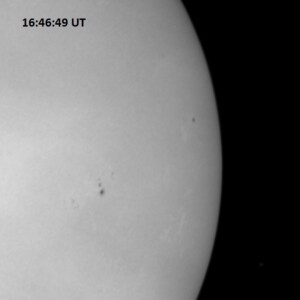 AR 13519 (just below center) and 13527 (near the edge) as imaged in this red continuum image covering 13.8’x13.8′ on the sky.
AR 13519 (just below center) and 13527 (near the edge) as imaged in this red continuum image covering 13.8’x13.8′ on the sky.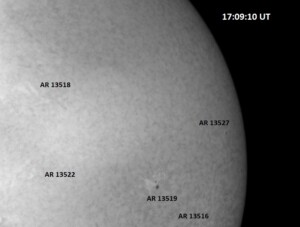 The two images listed at left, plus several others (labeled) are imaged in this 13.8’x18.0′ H-alpha image of this zone on the Sun. The two regions along the left edge of the image are spotless H-alpha plages.
The two images listed at left, plus several others (labeled) are imaged in this 13.8’x18.0′ H-alpha image of this zone on the Sun. The two regions along the left edge of the image are spotless H-alpha plages.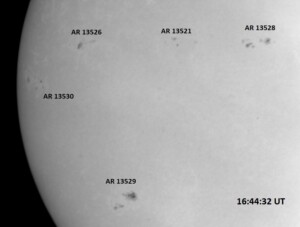 A 13.8’x18.0′ red continuum image showing the active regions visible on the eastern half of the Sun. AR’s 13523 and 13524 are just above 13521, outside the frame of this image. These two are quite small and unremarkable.
A 13.8’x18.0′ red continuum image showing the active regions visible on the eastern half of the Sun. AR’s 13523 and 13524 are just above 13521, outside the frame of this image. These two are quite small and unremarkable.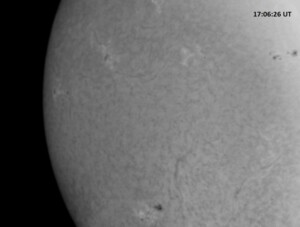 H-alpha image, covering 13.8’x18.0′ on the sky, of the same area of the Sun as depicted at left. A few filaments are visible along with most of the active regions.
H-alpha image, covering 13.8’x18.0′ on the sky, of the same area of the Sun as depicted at left. A few filaments are visible along with most of the active regions.